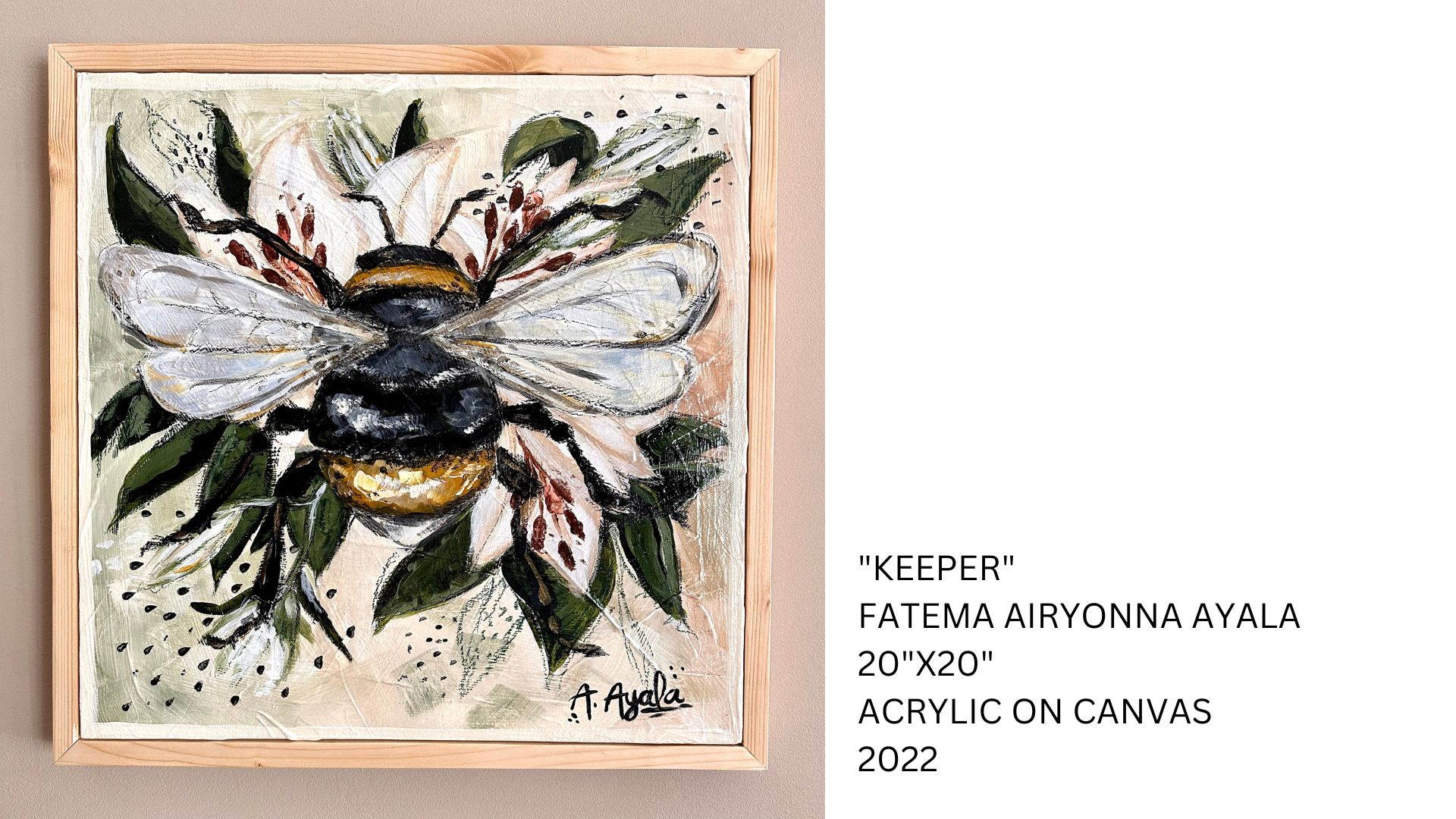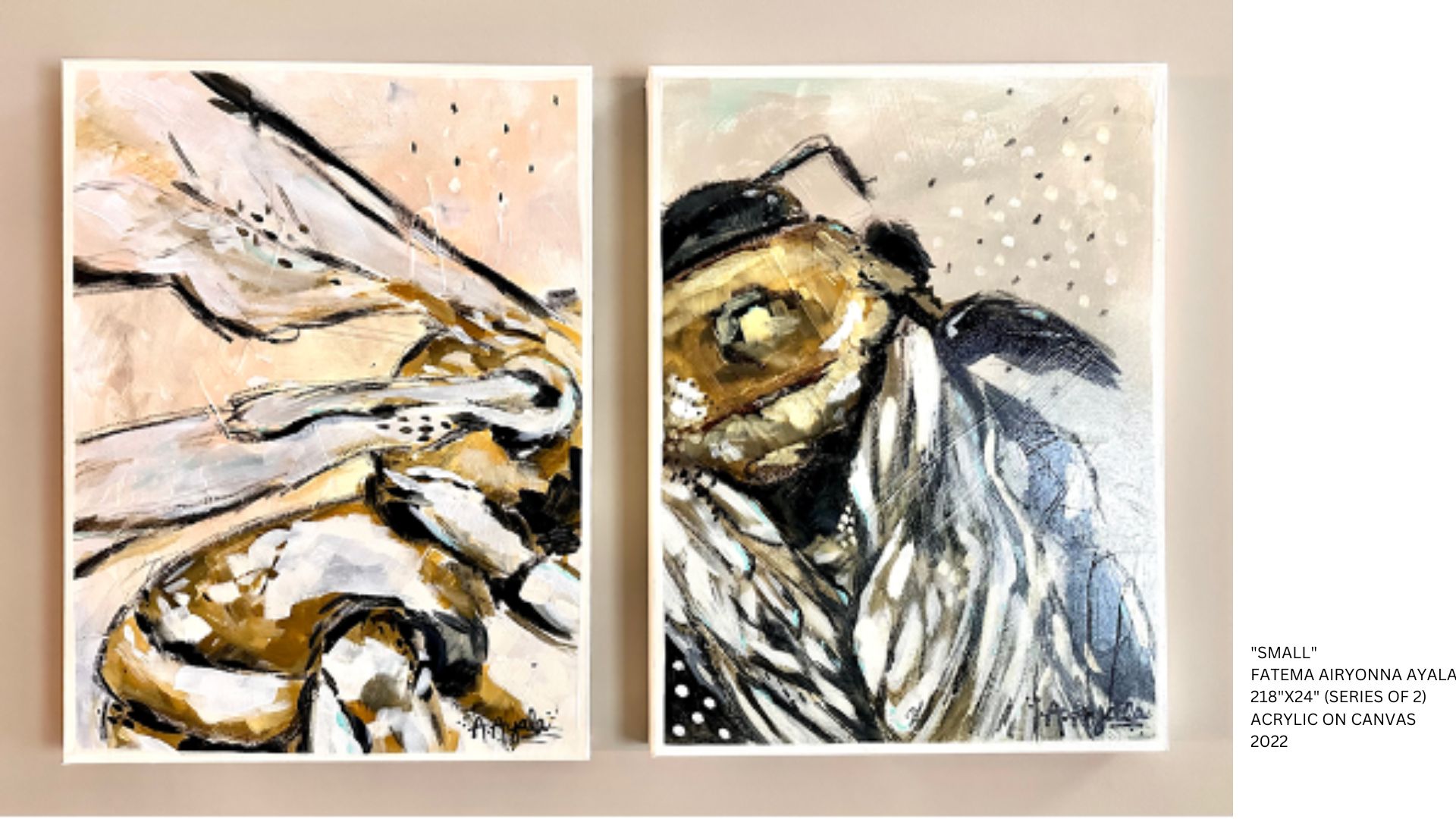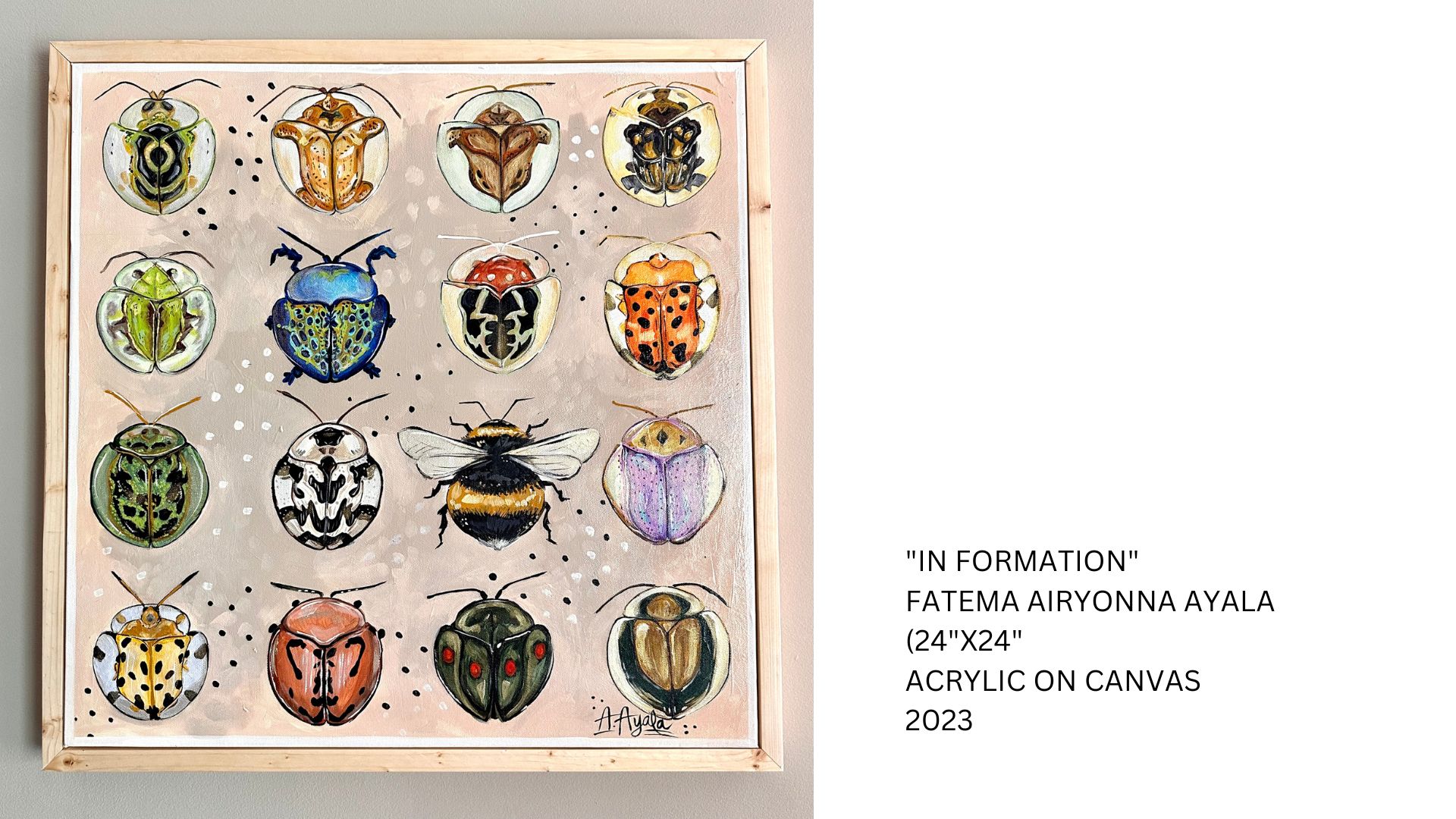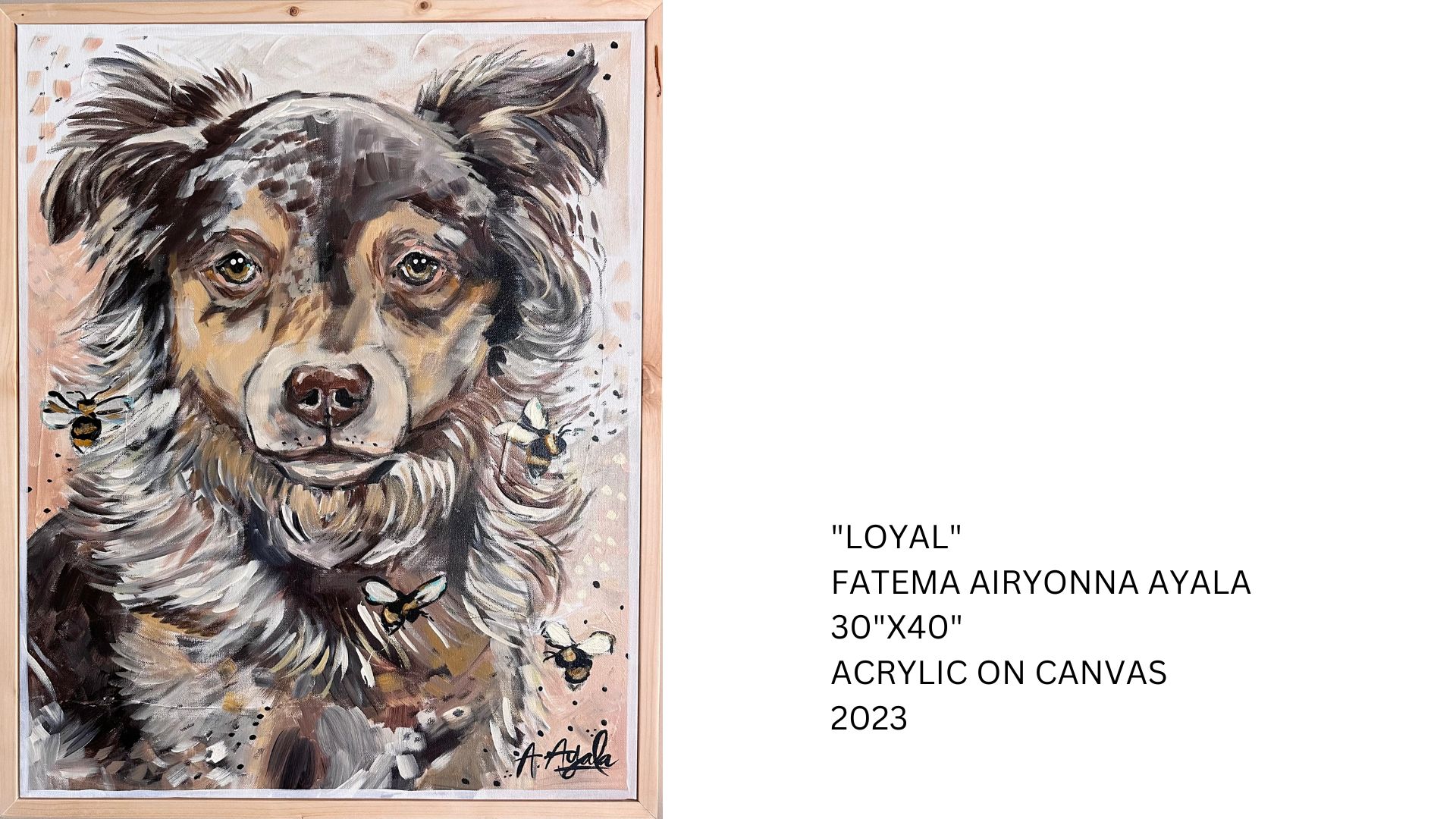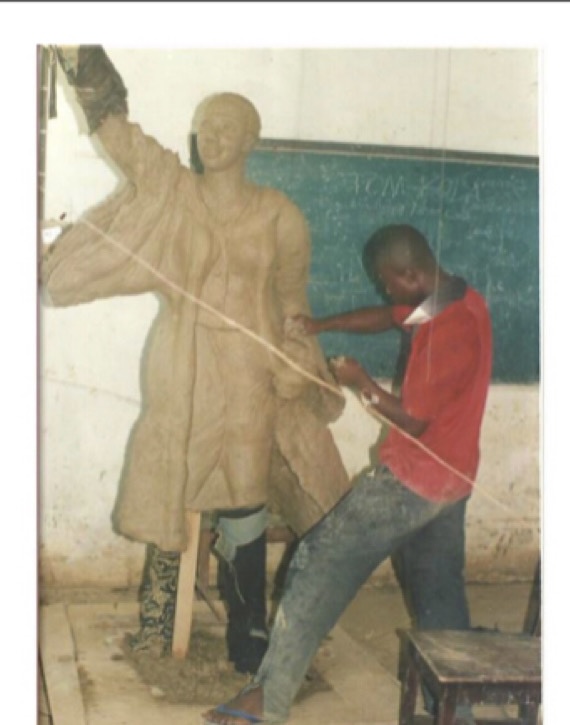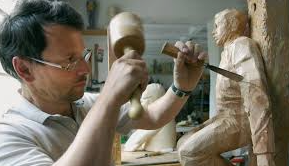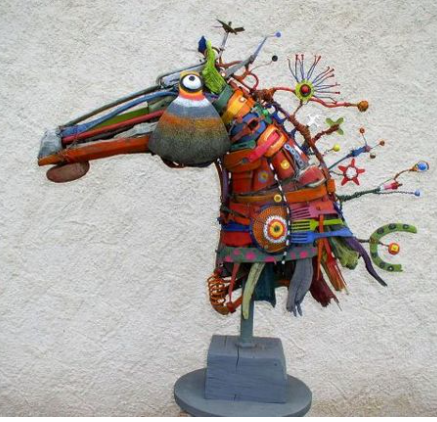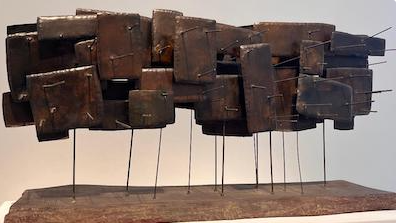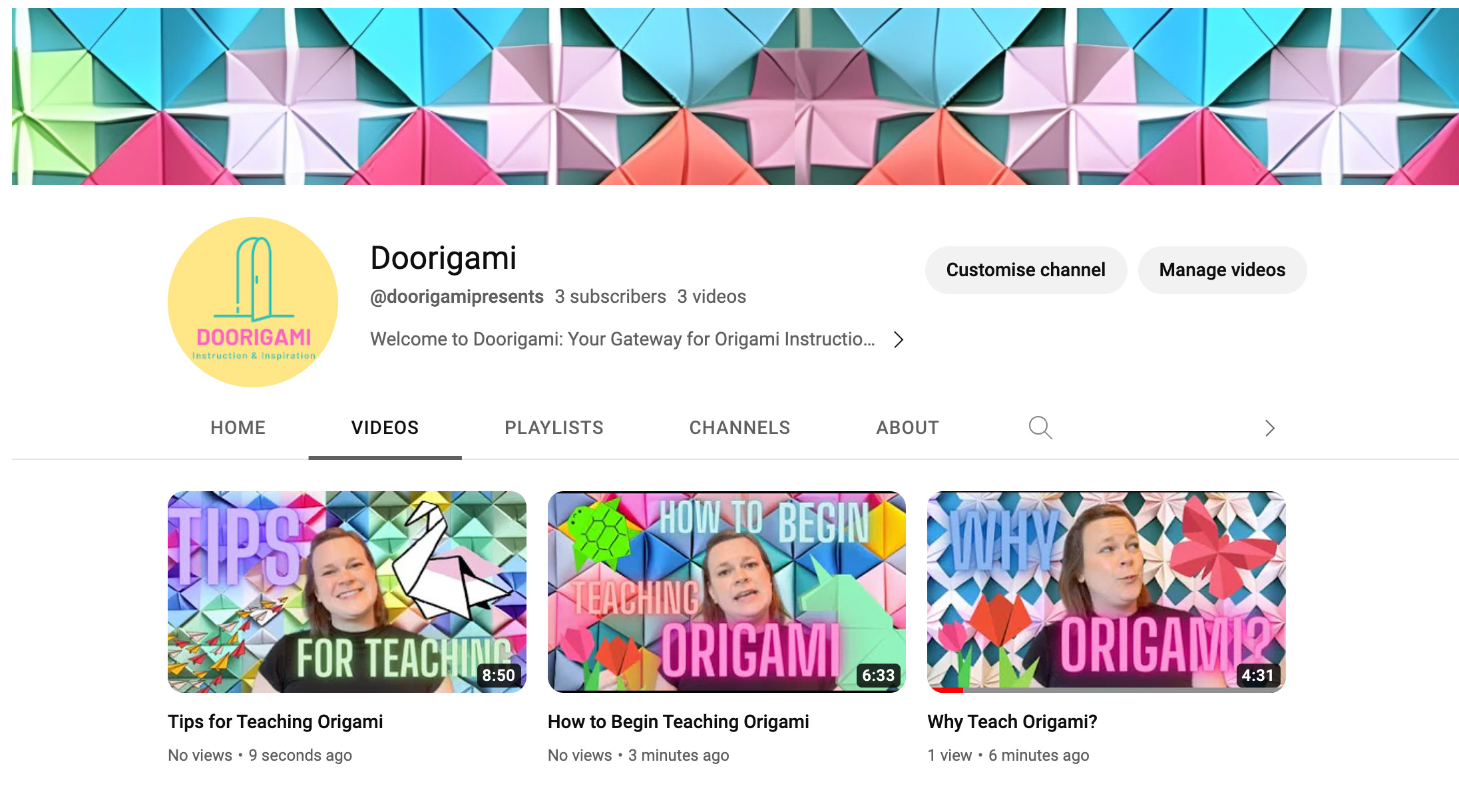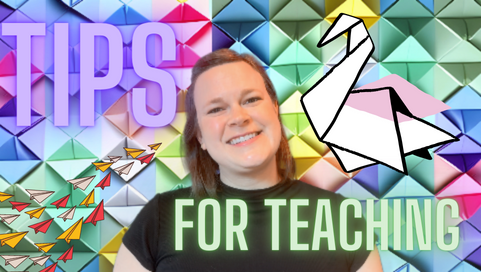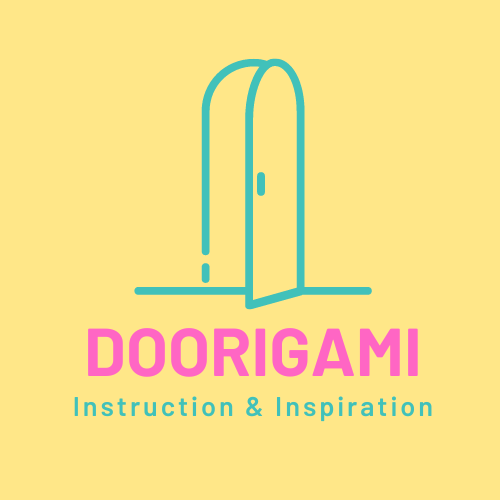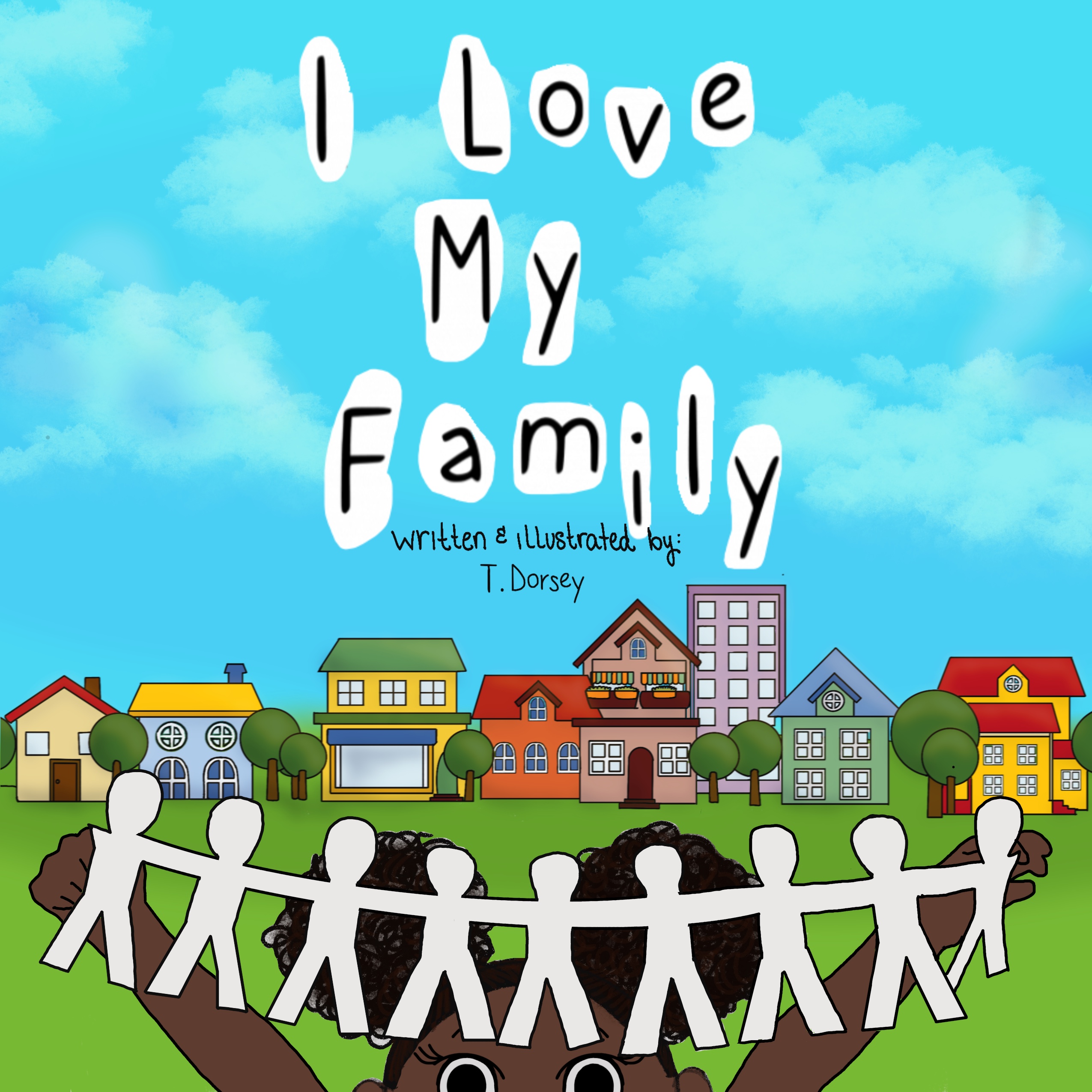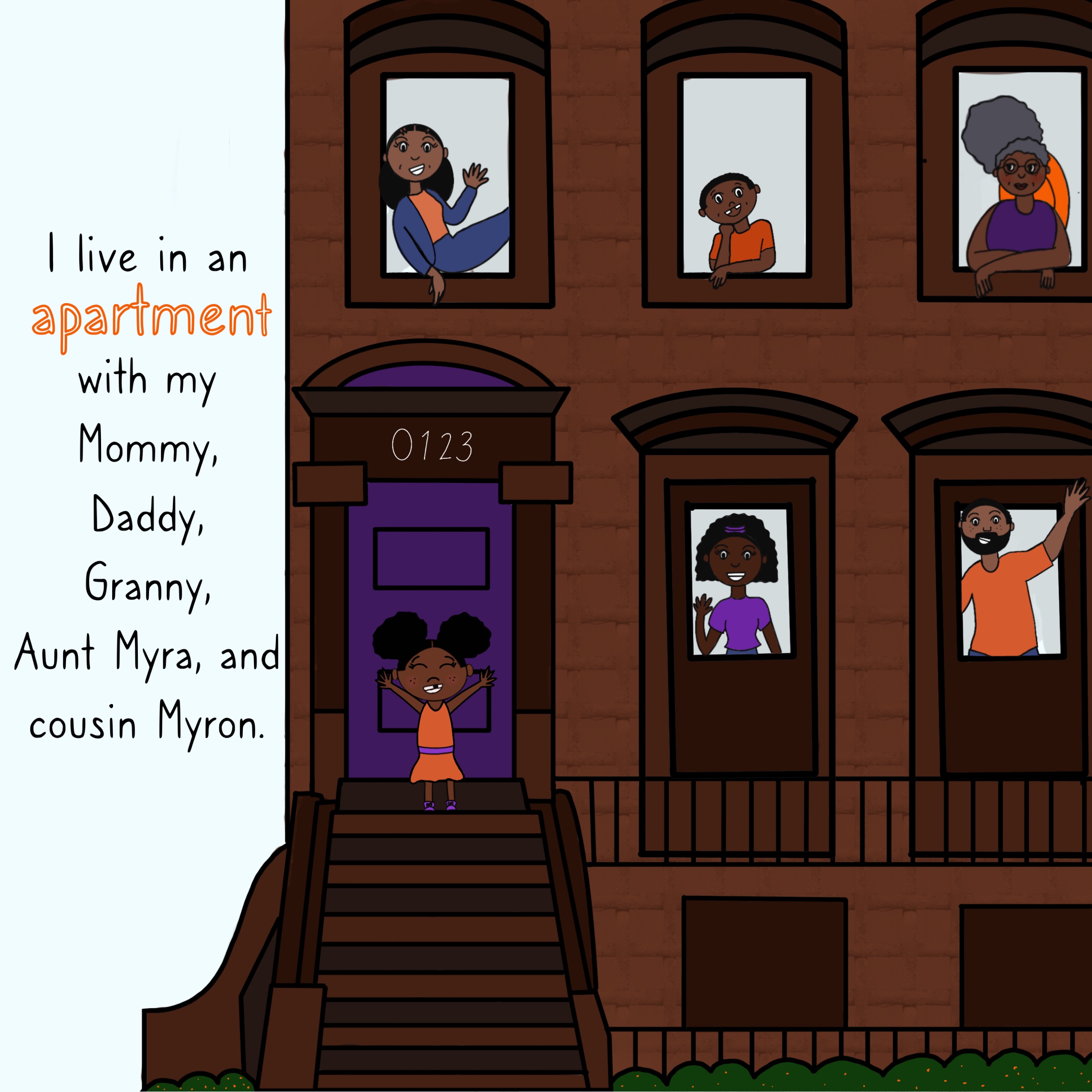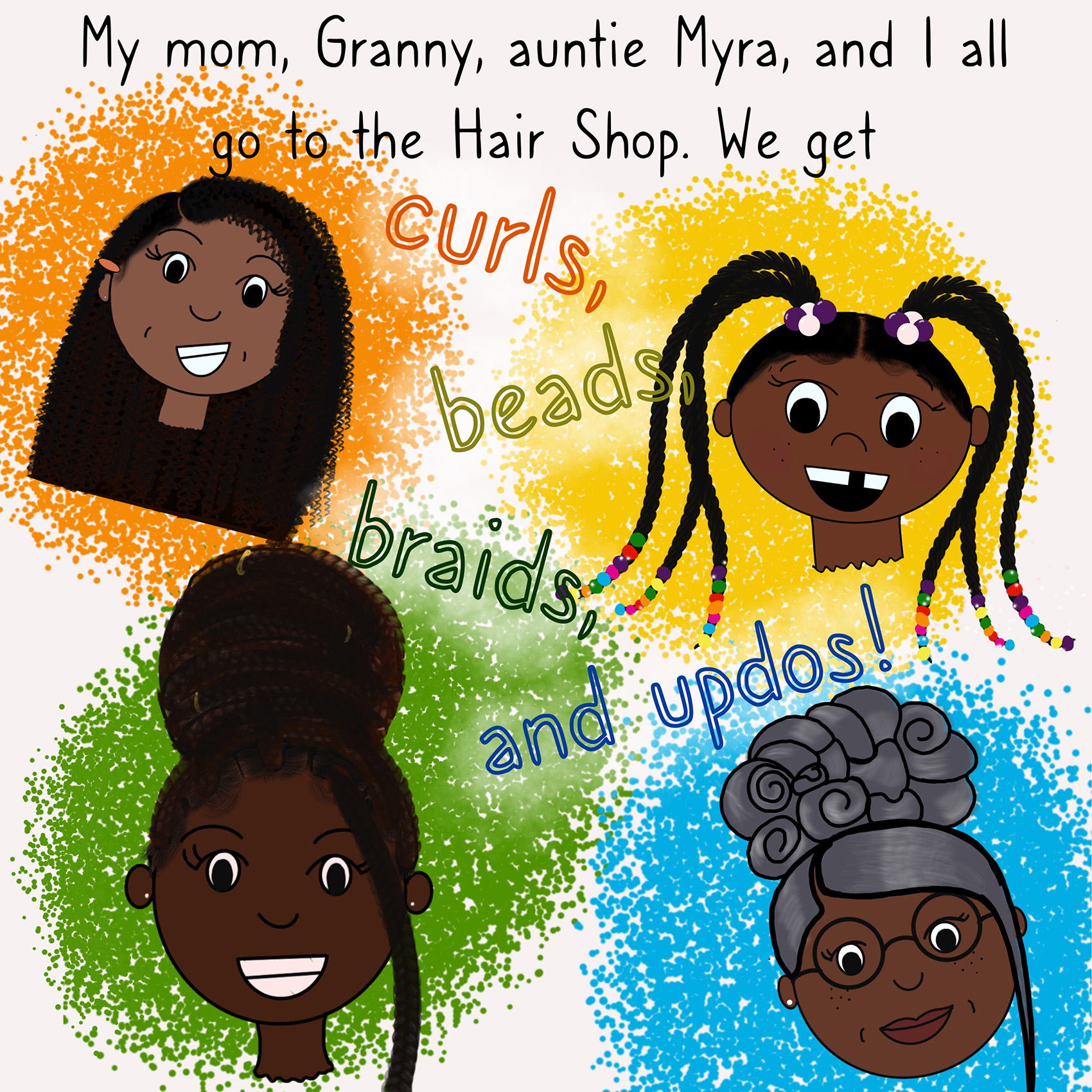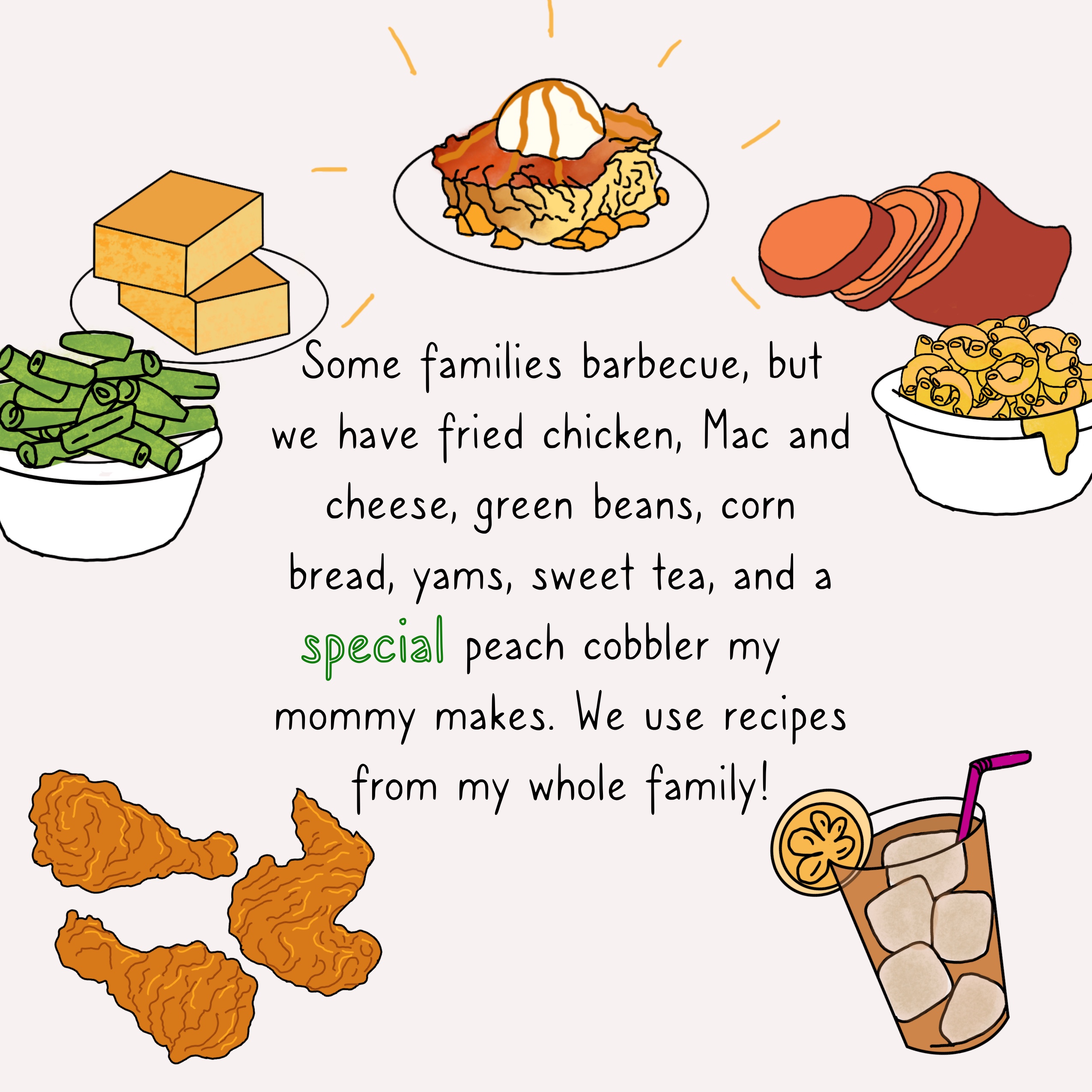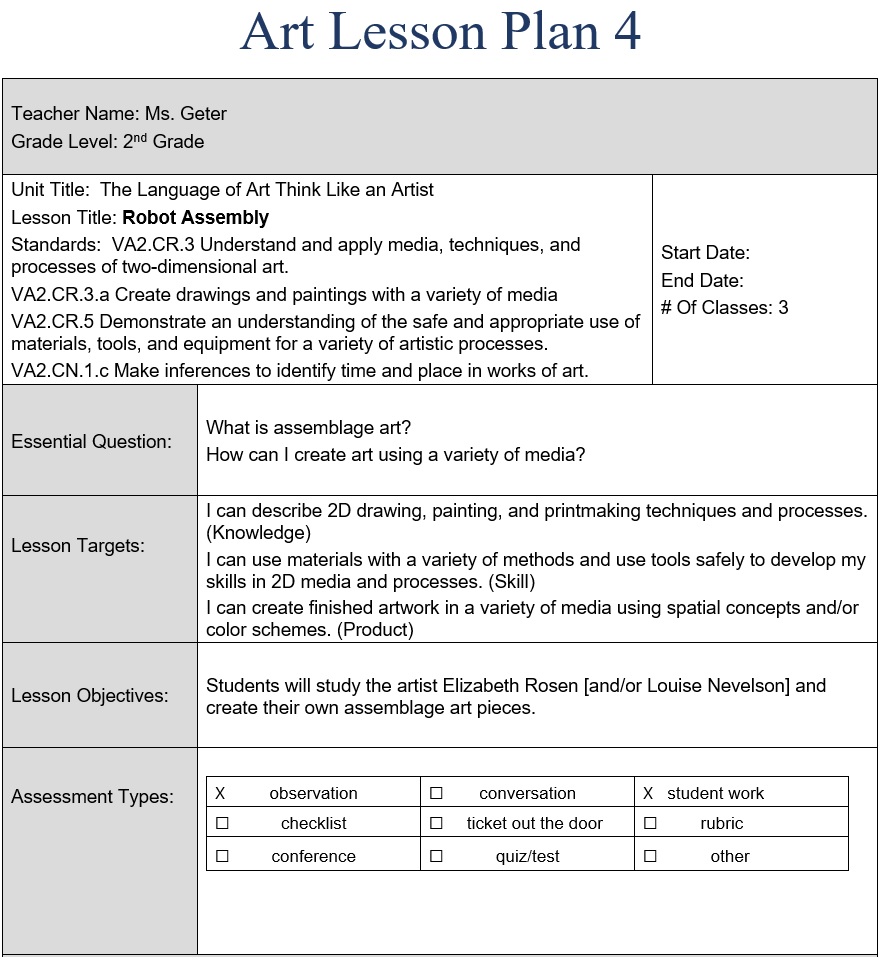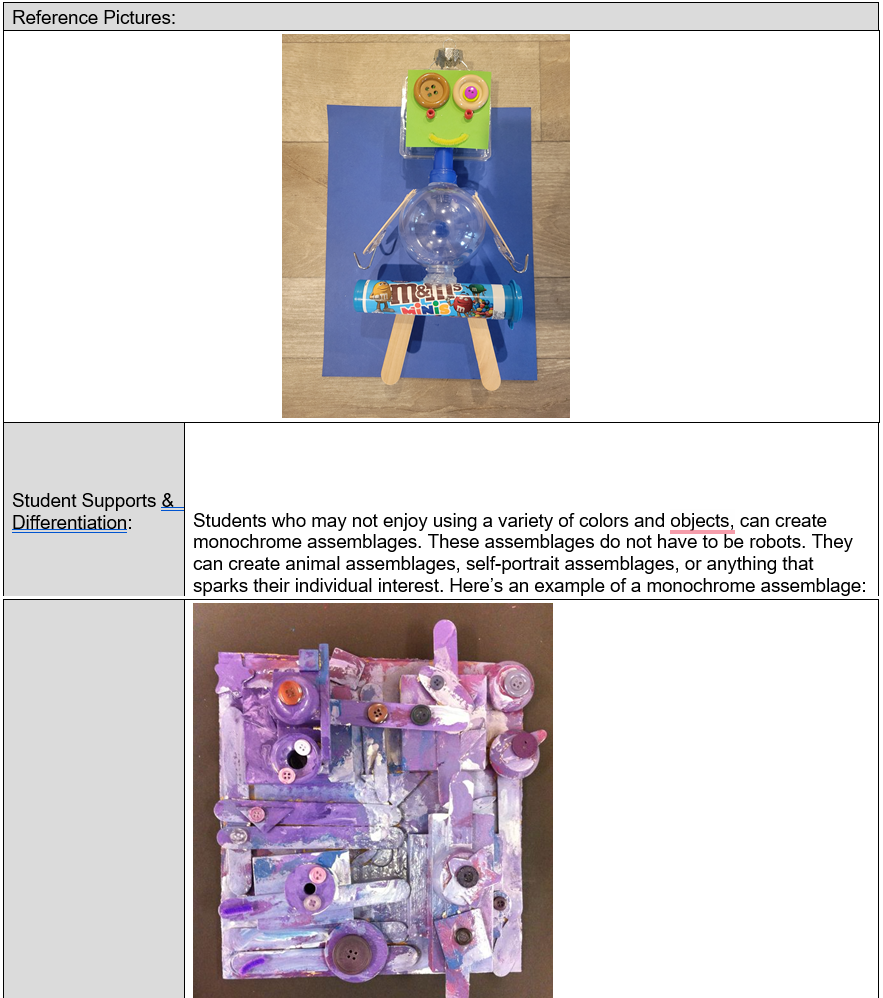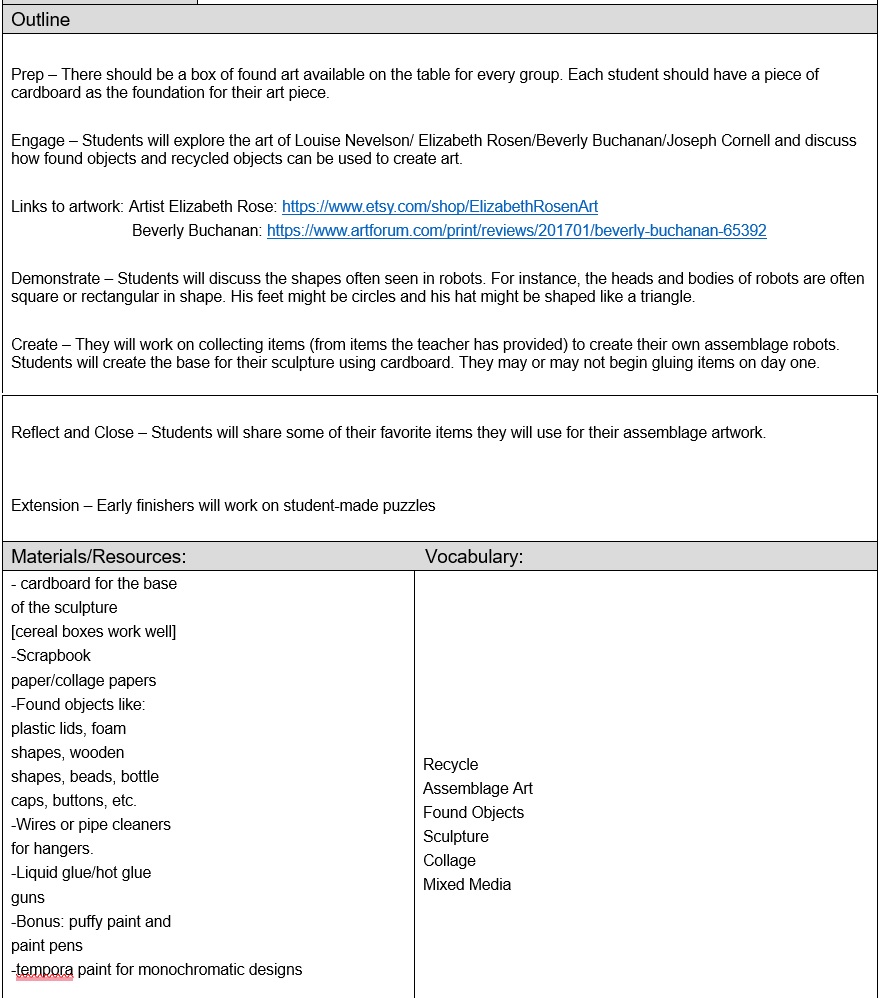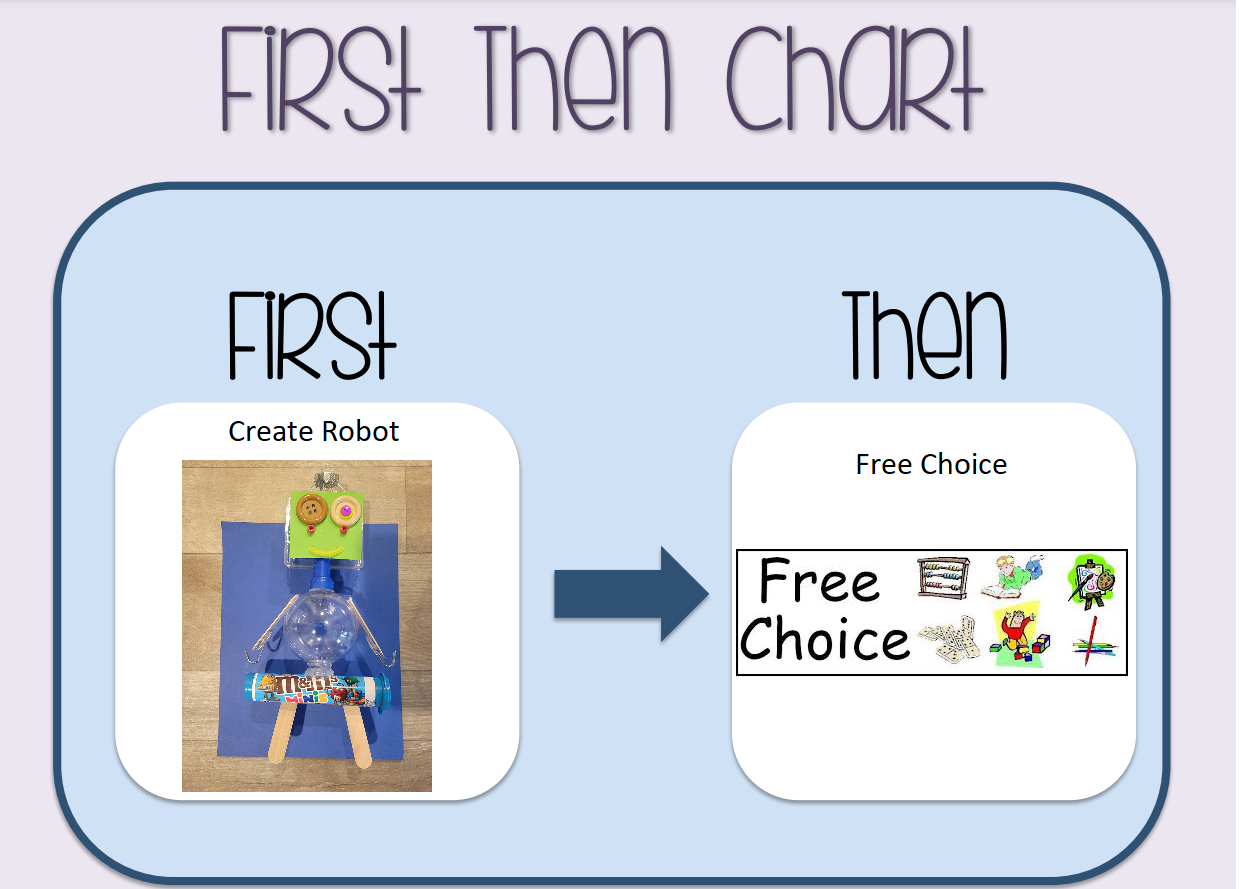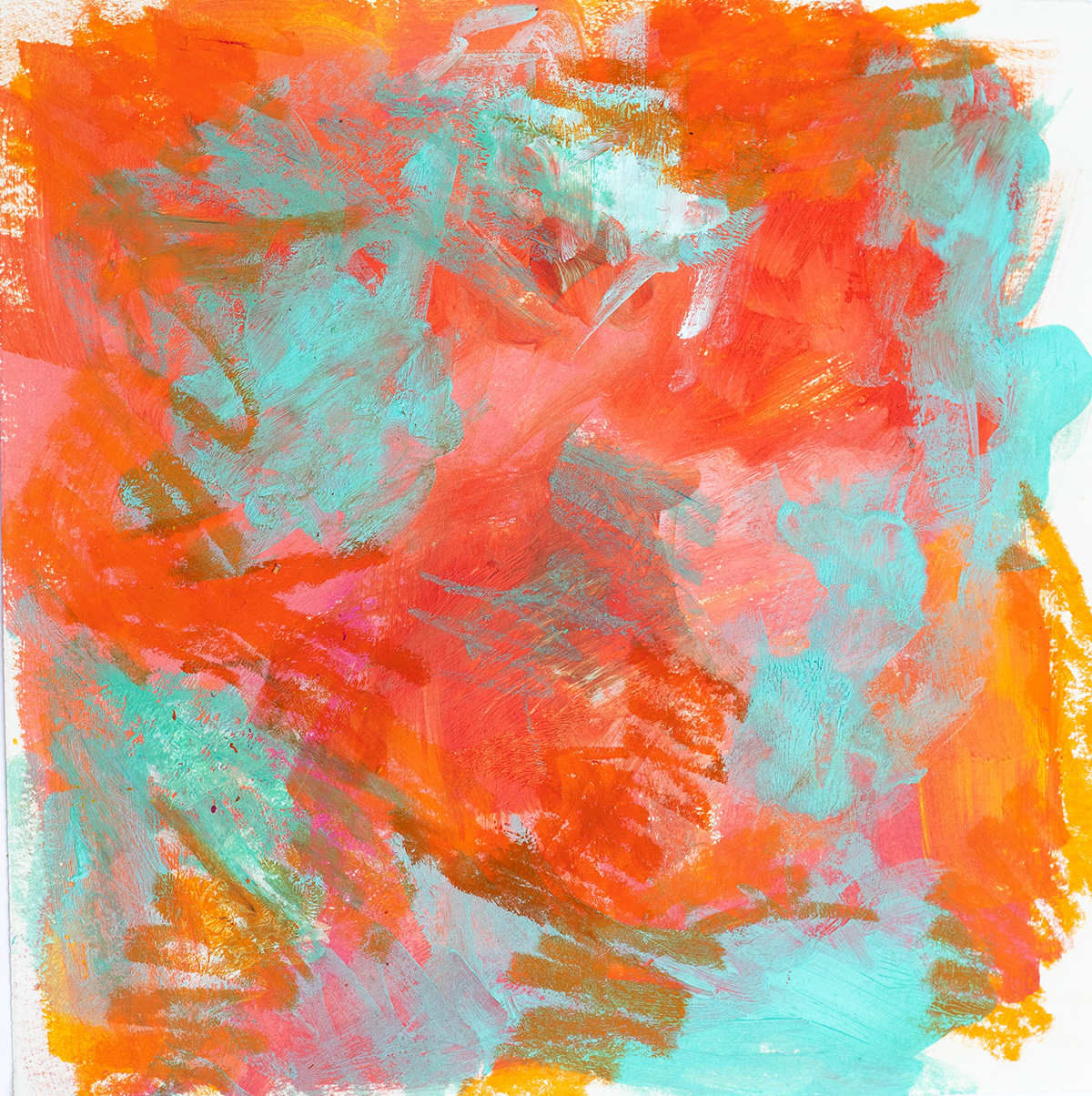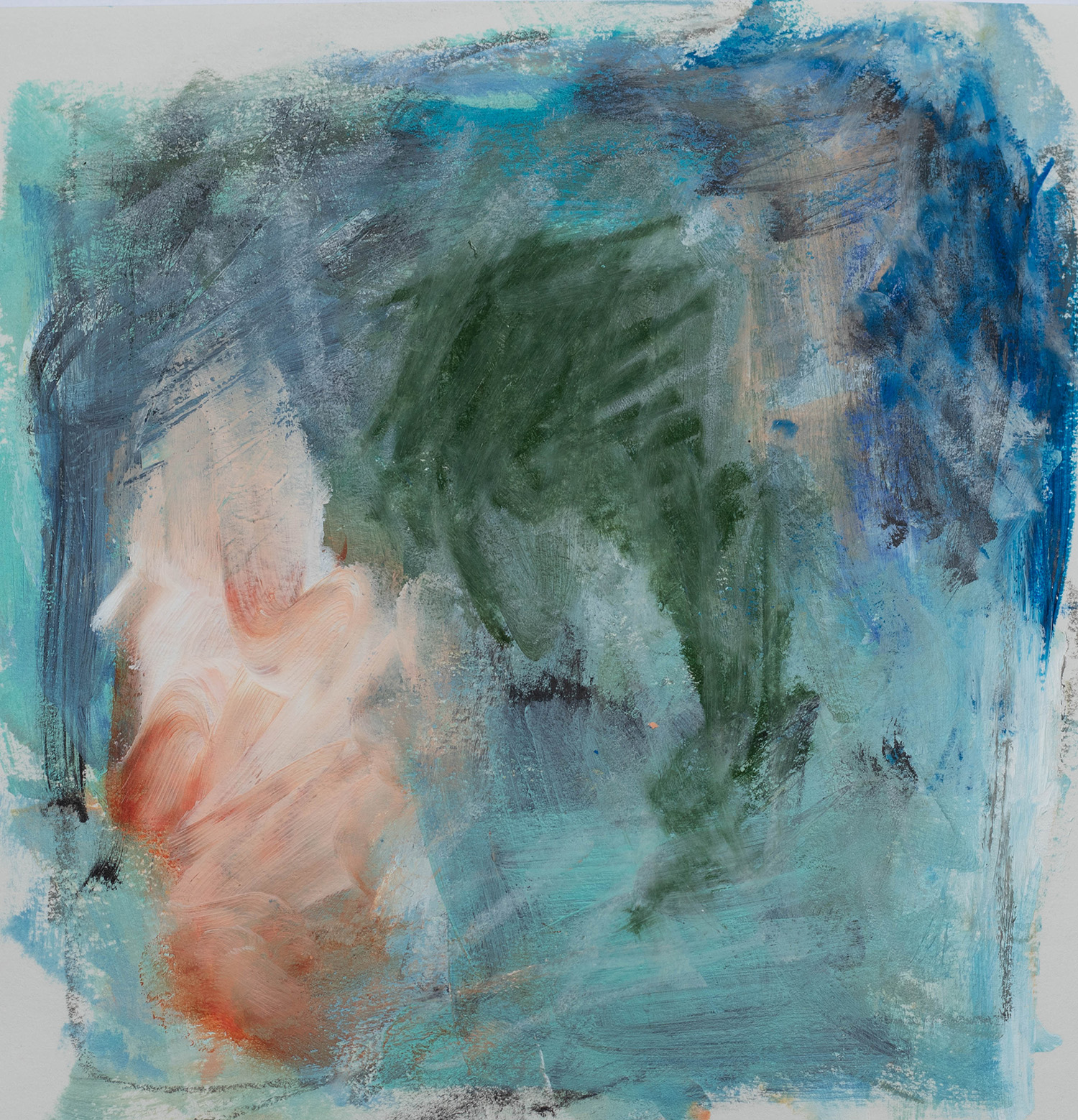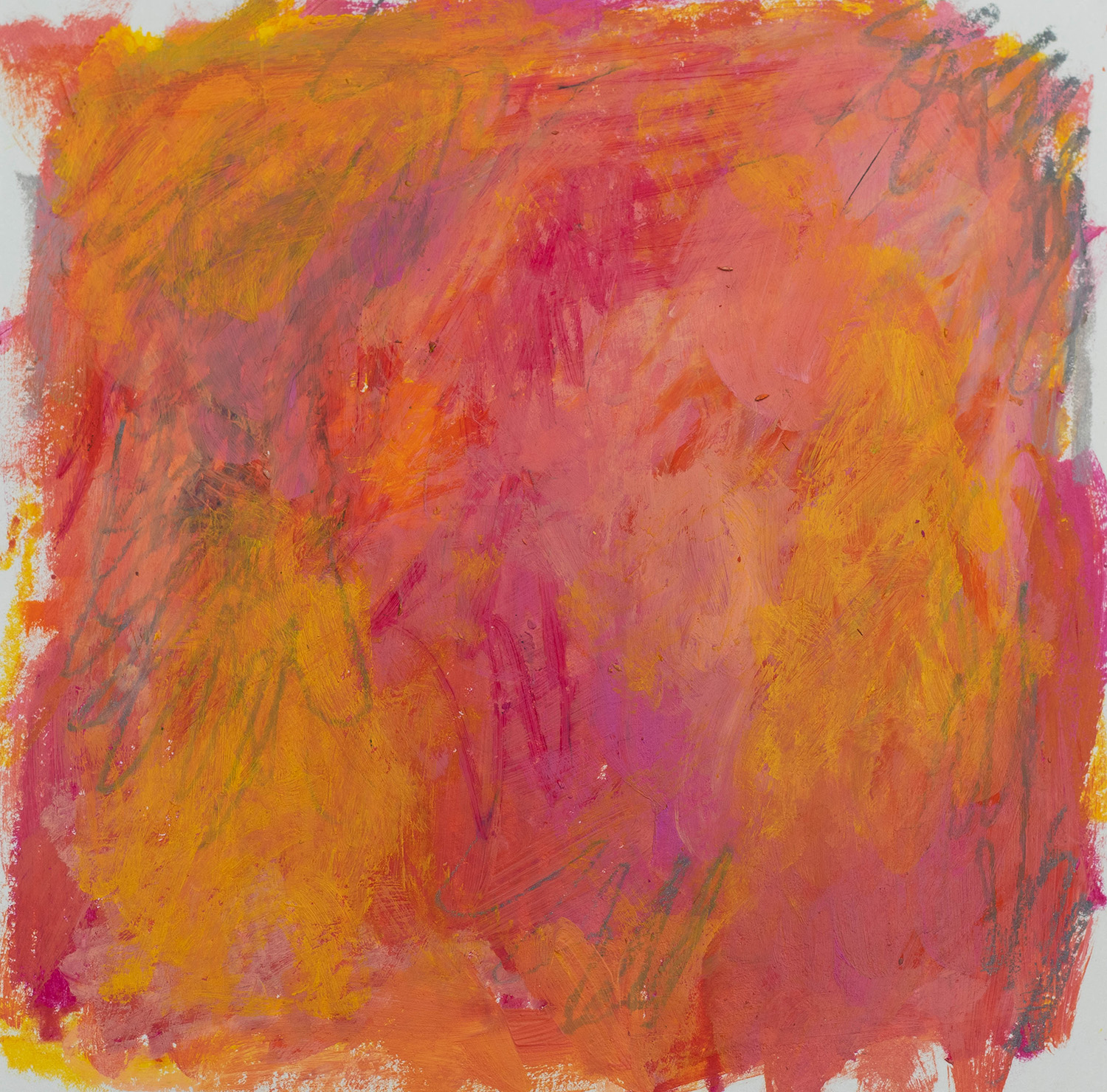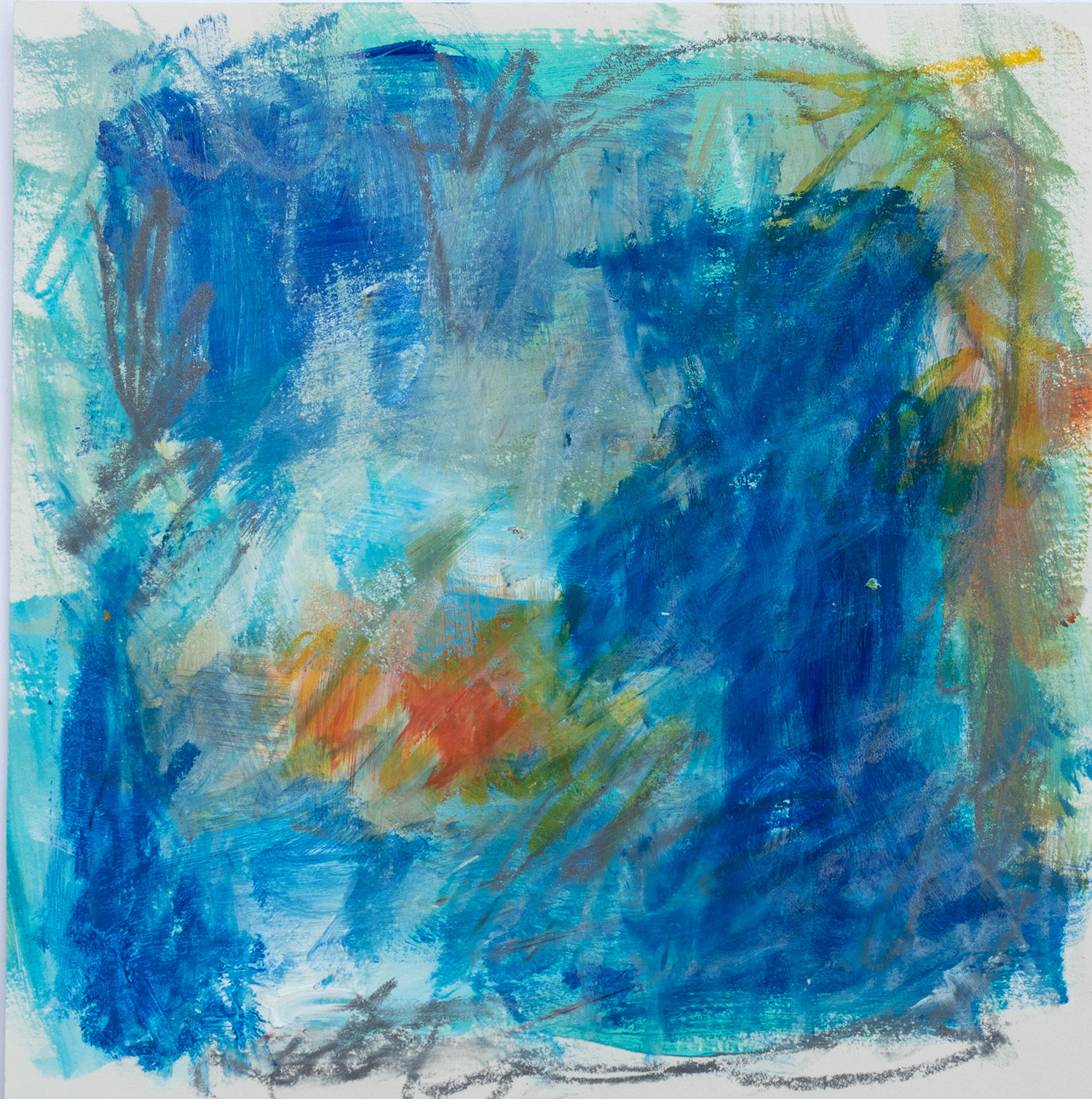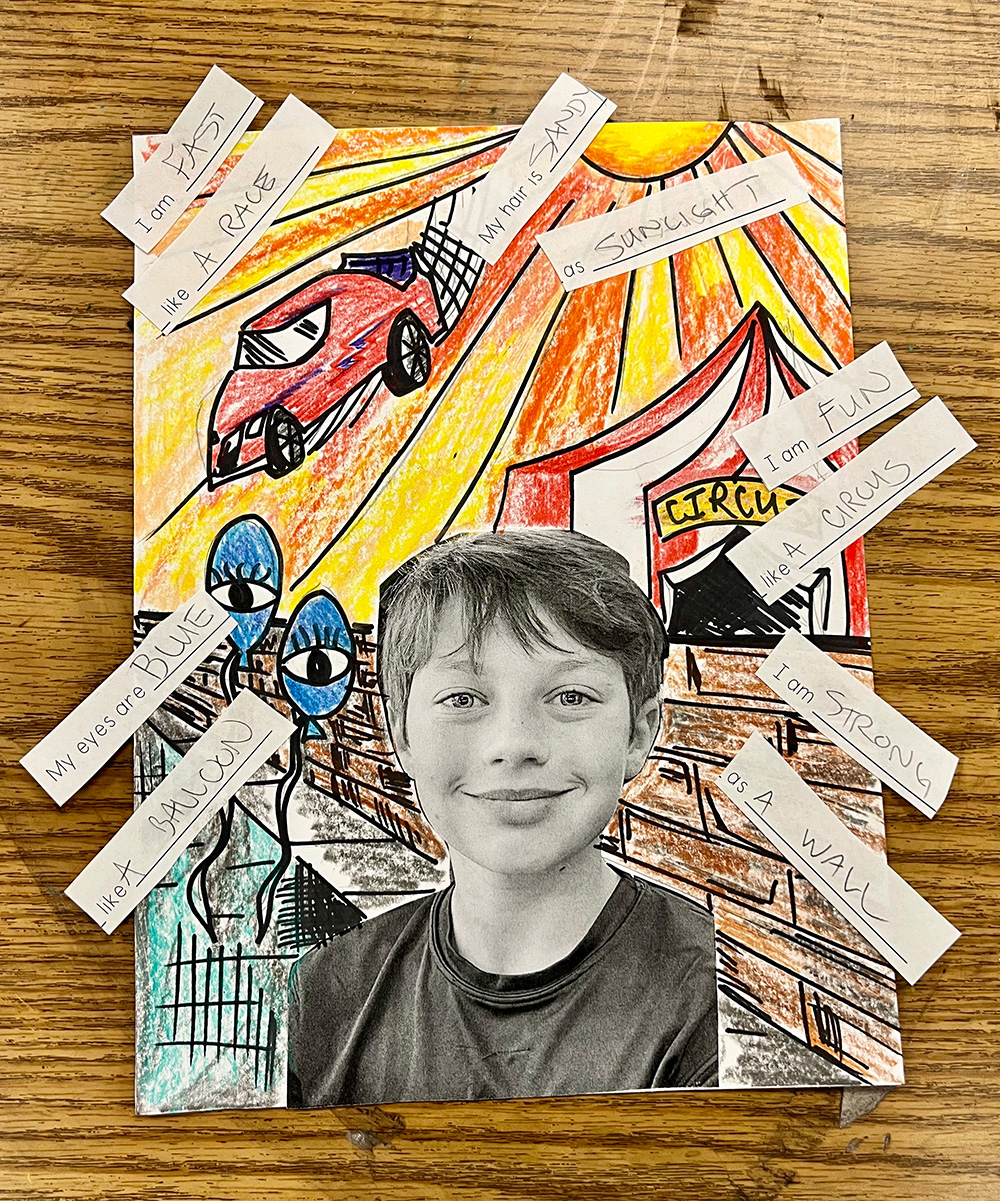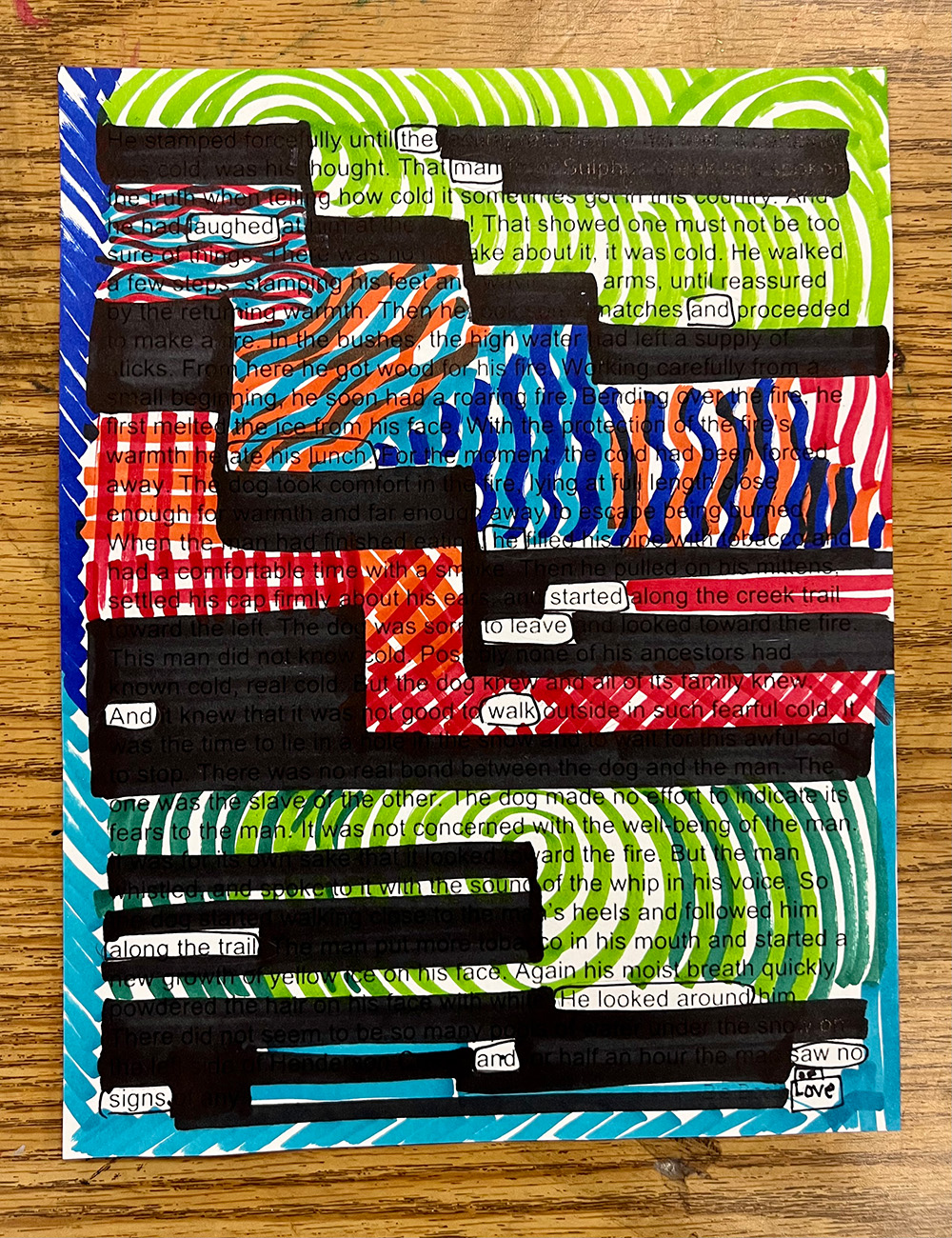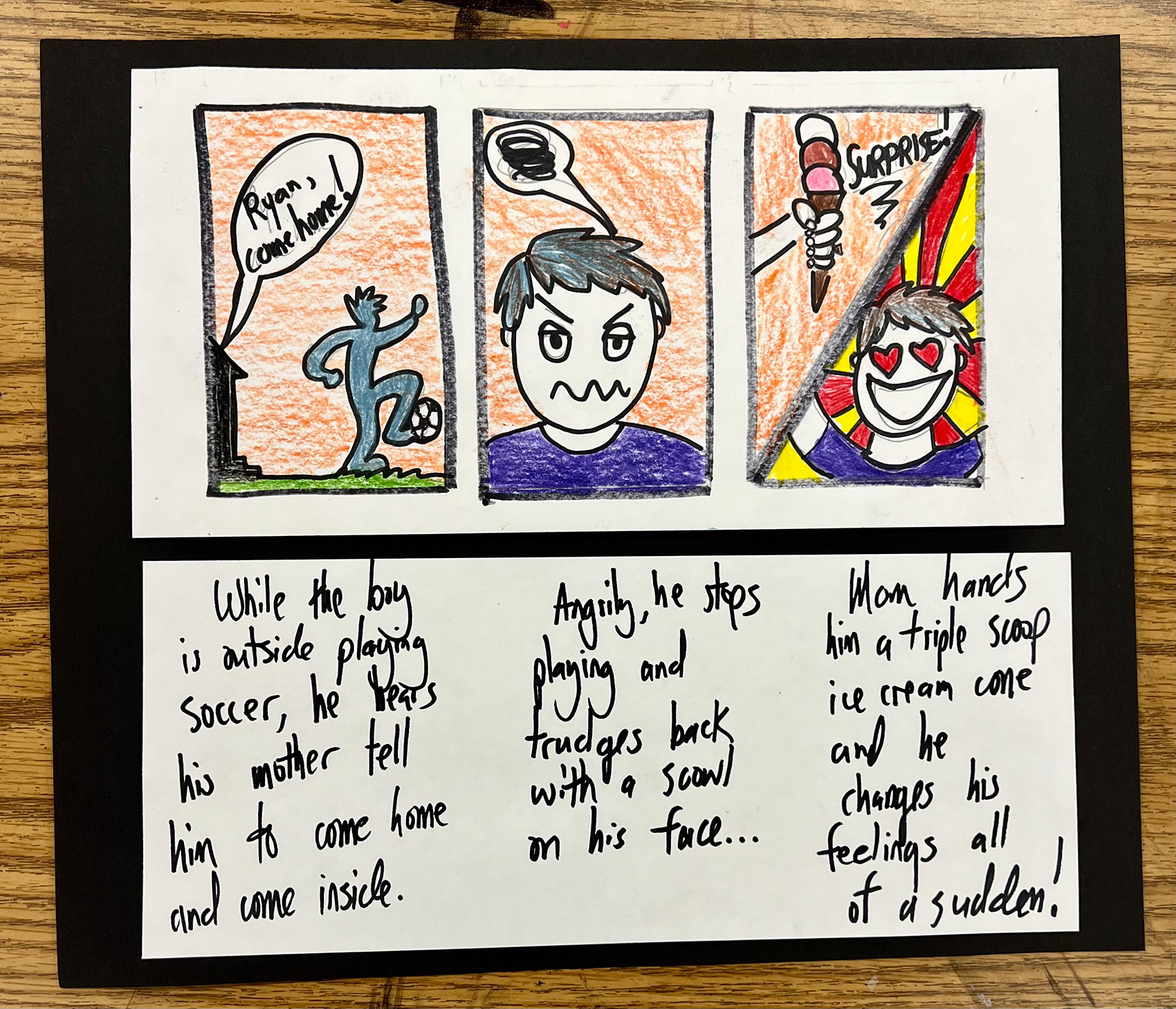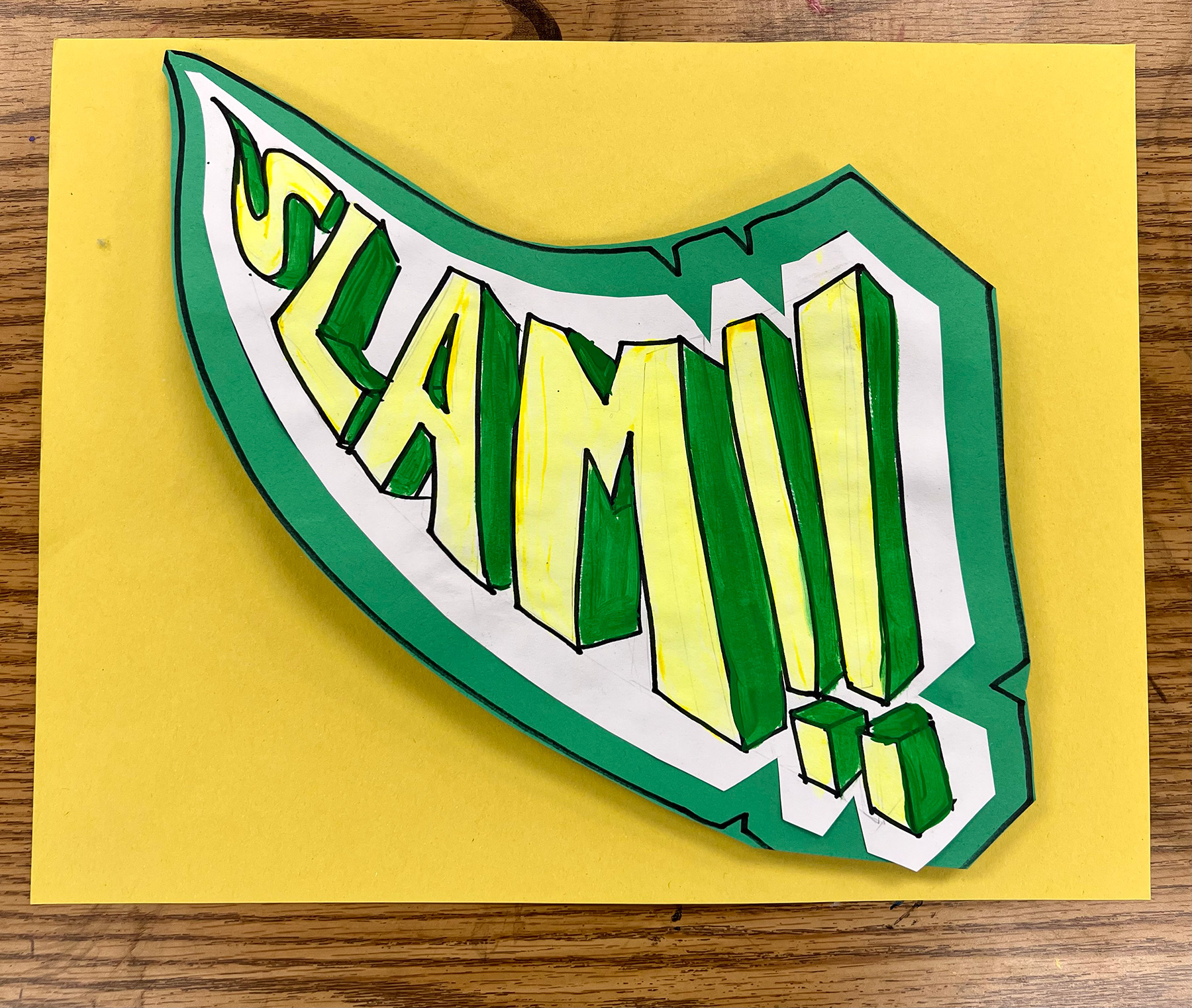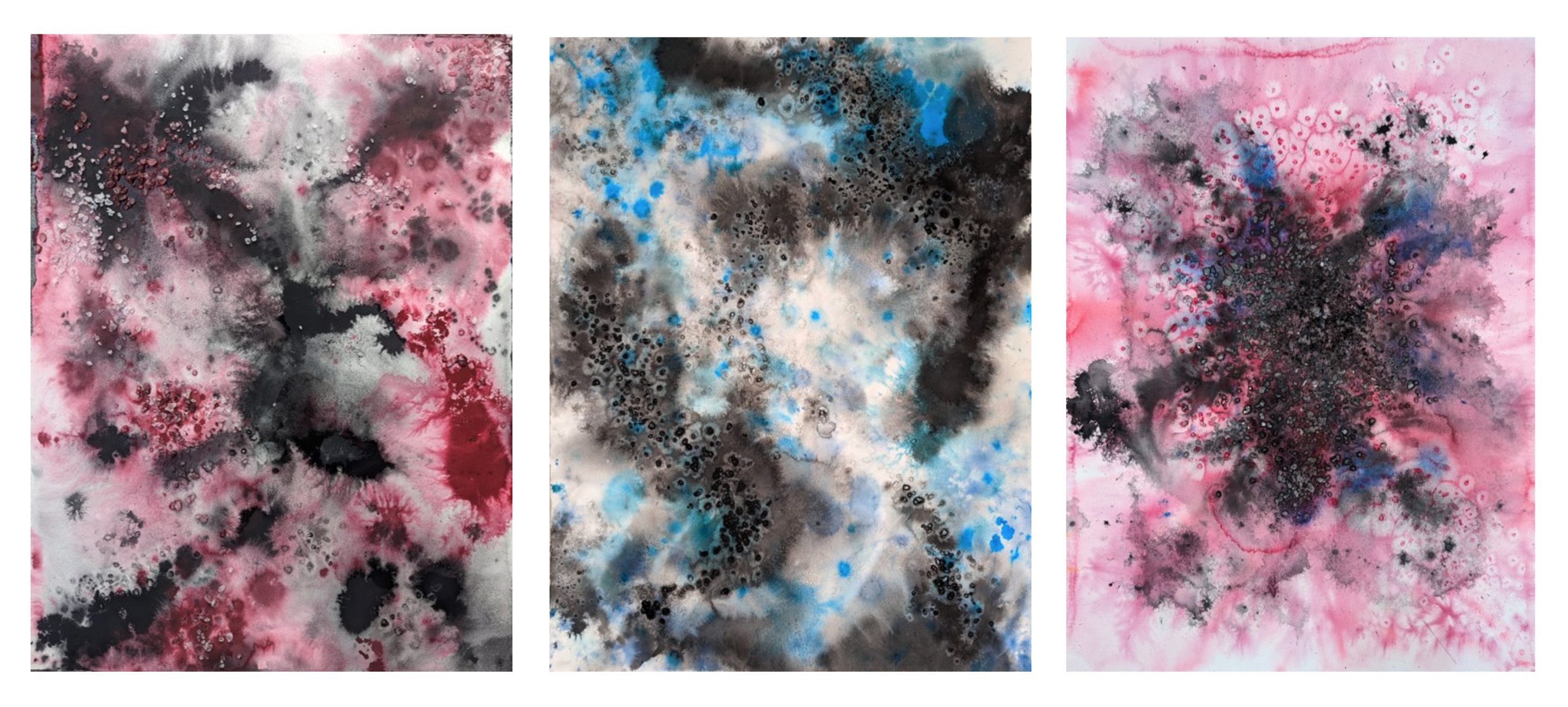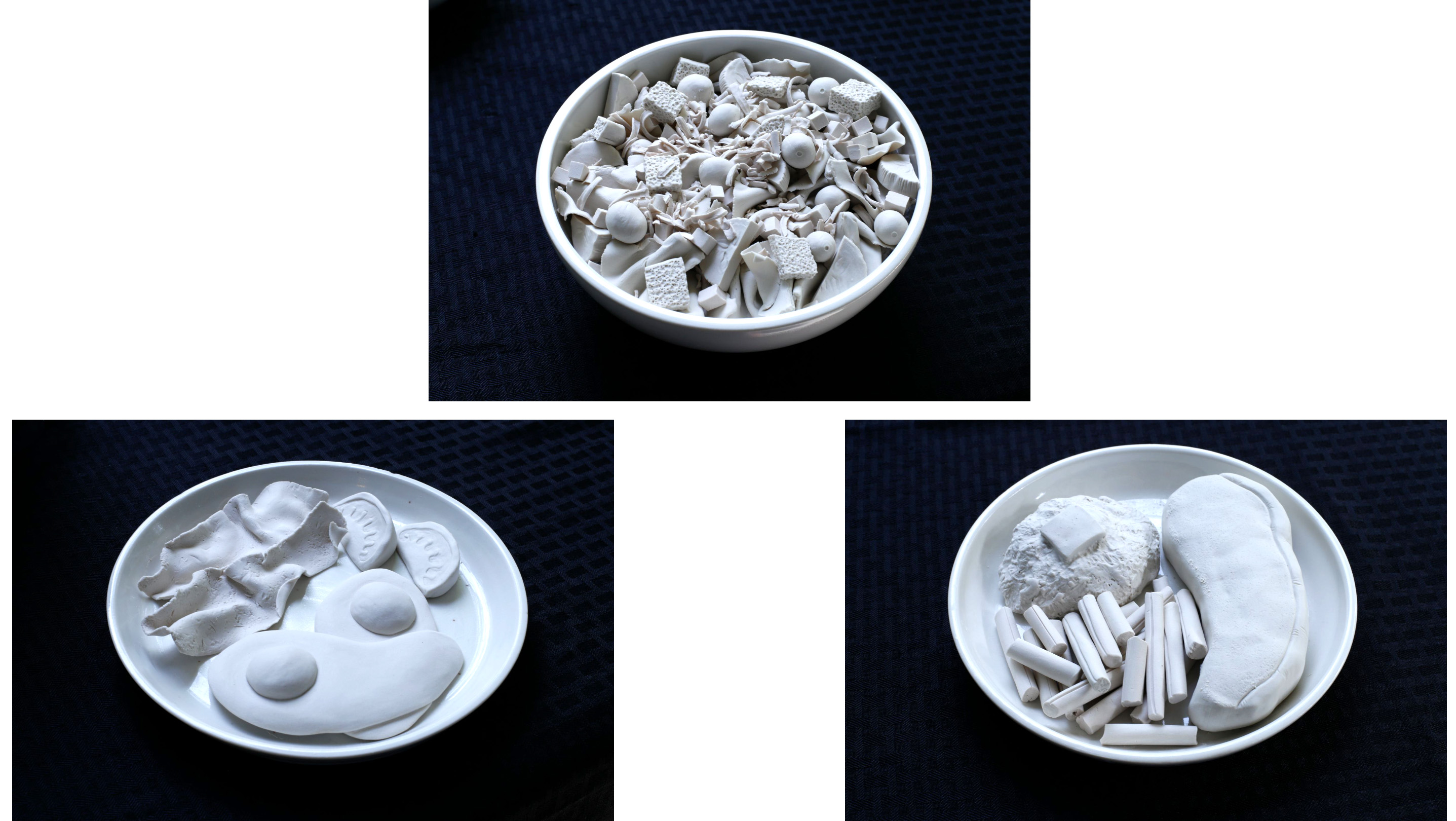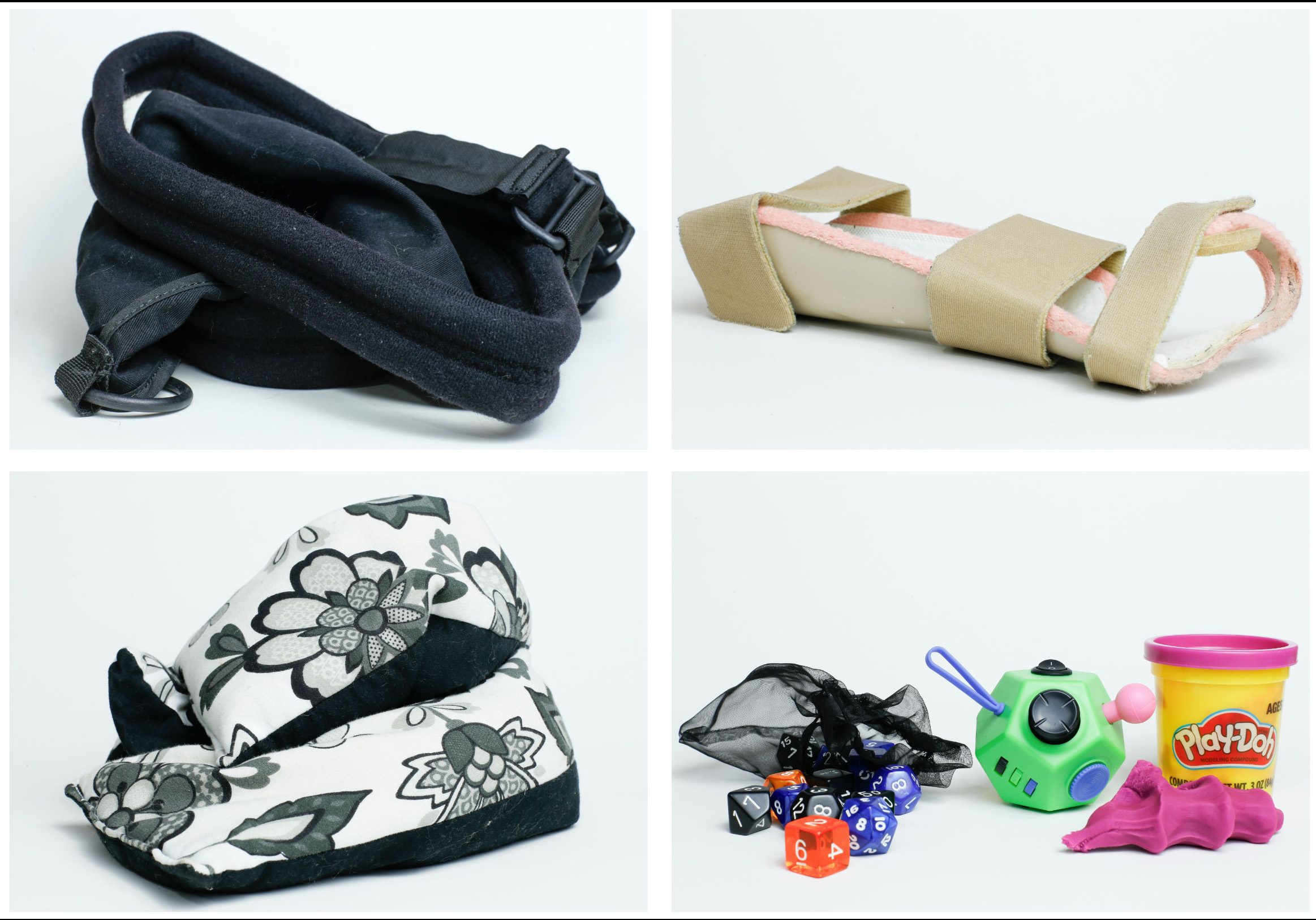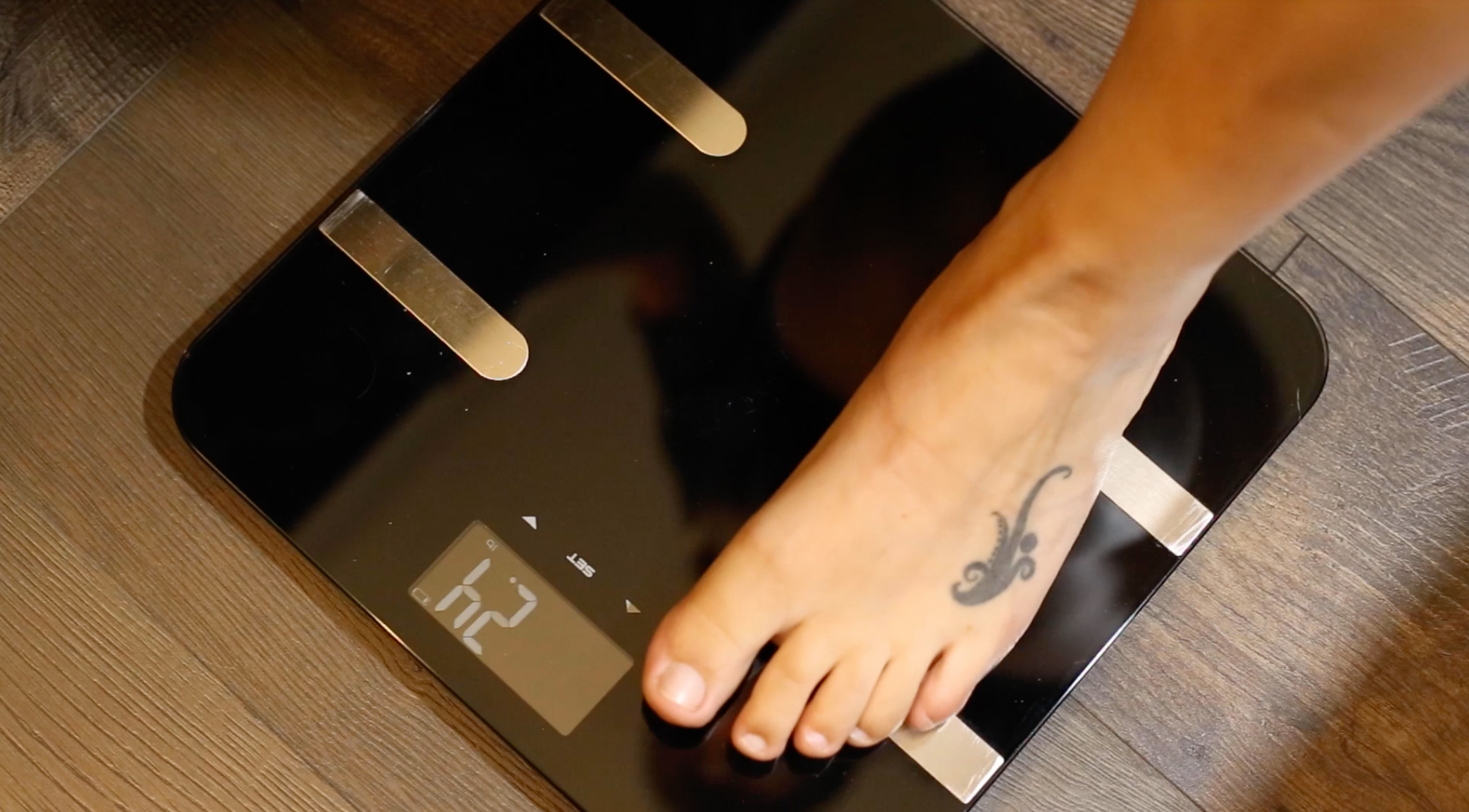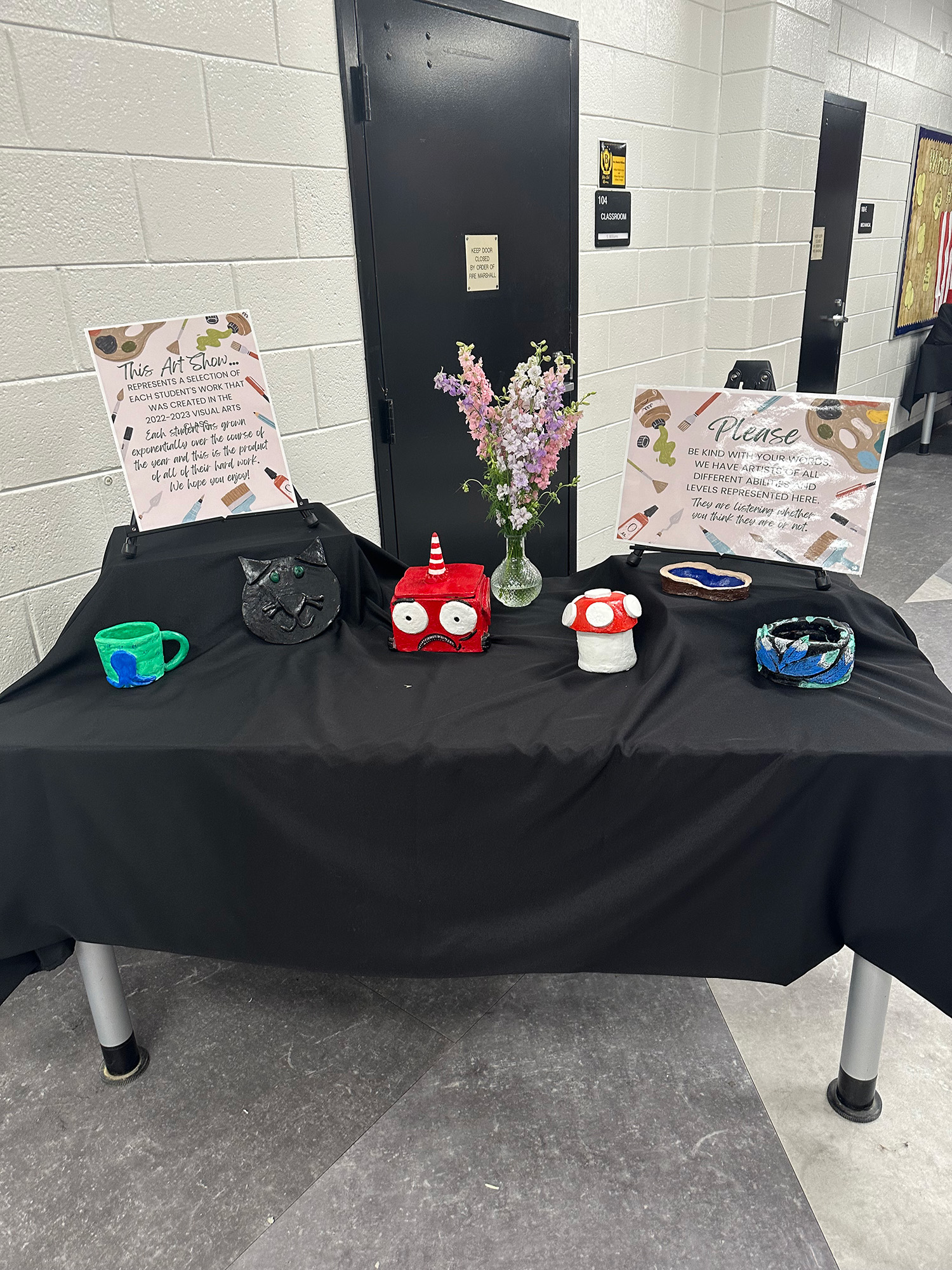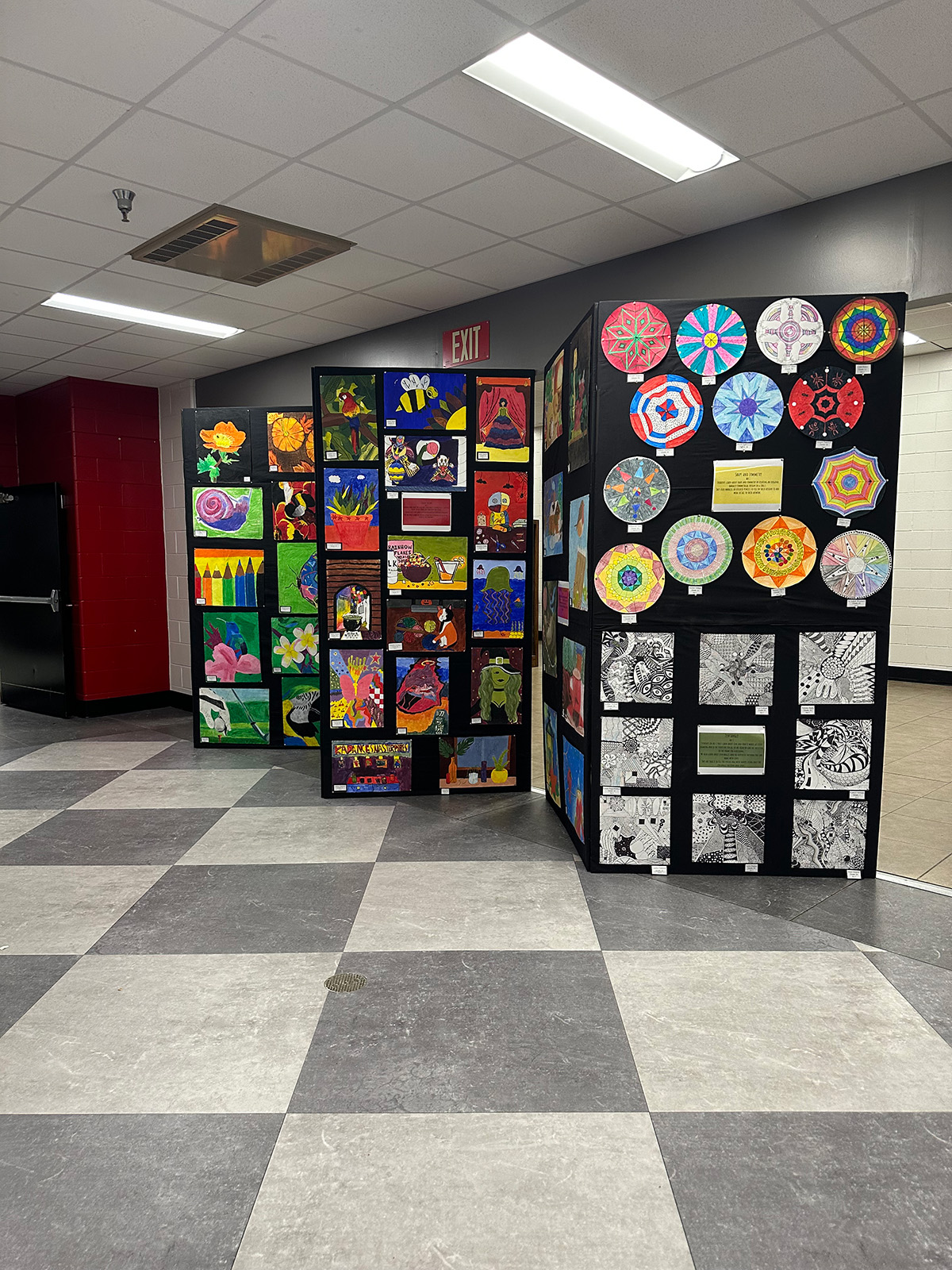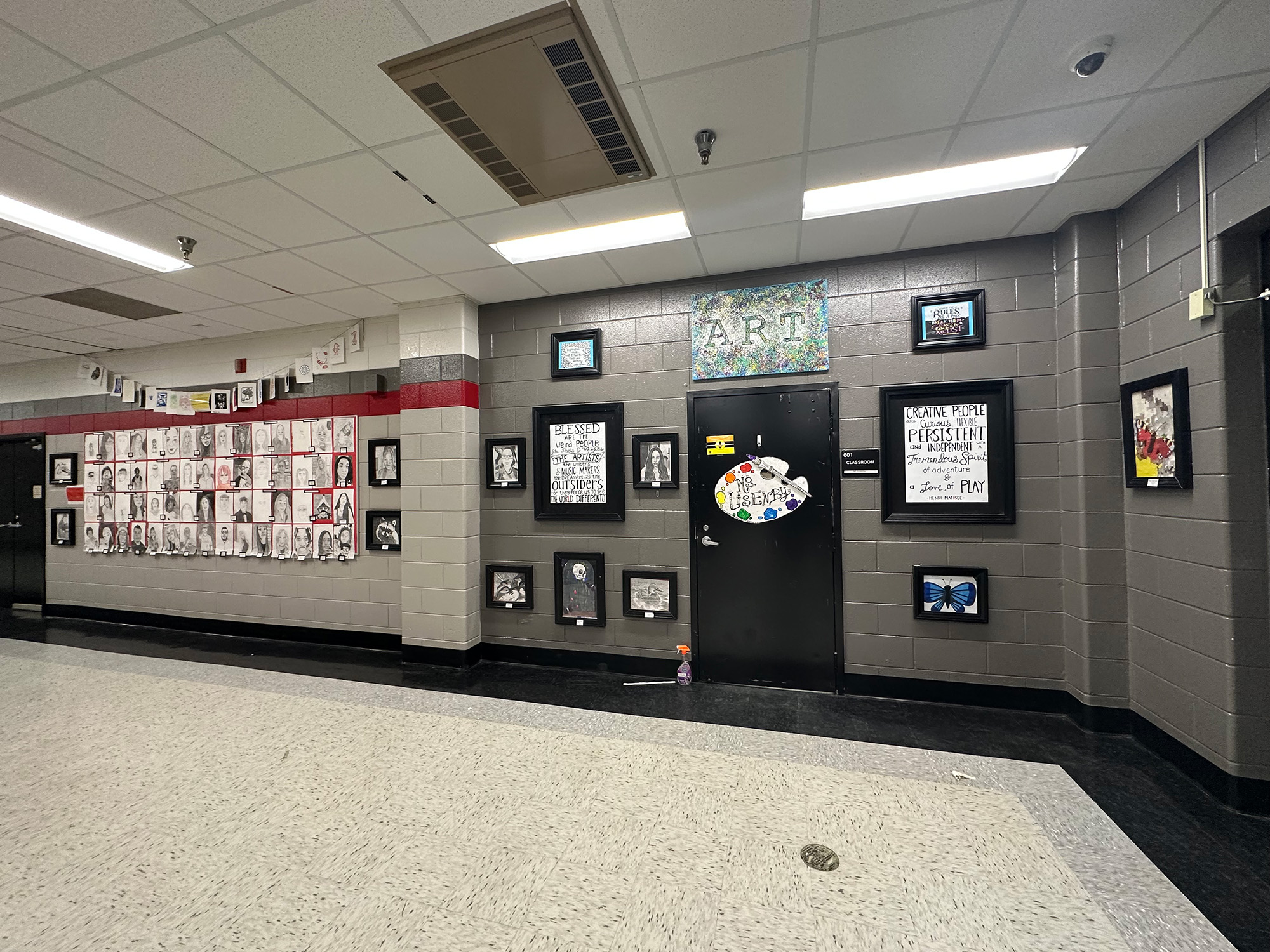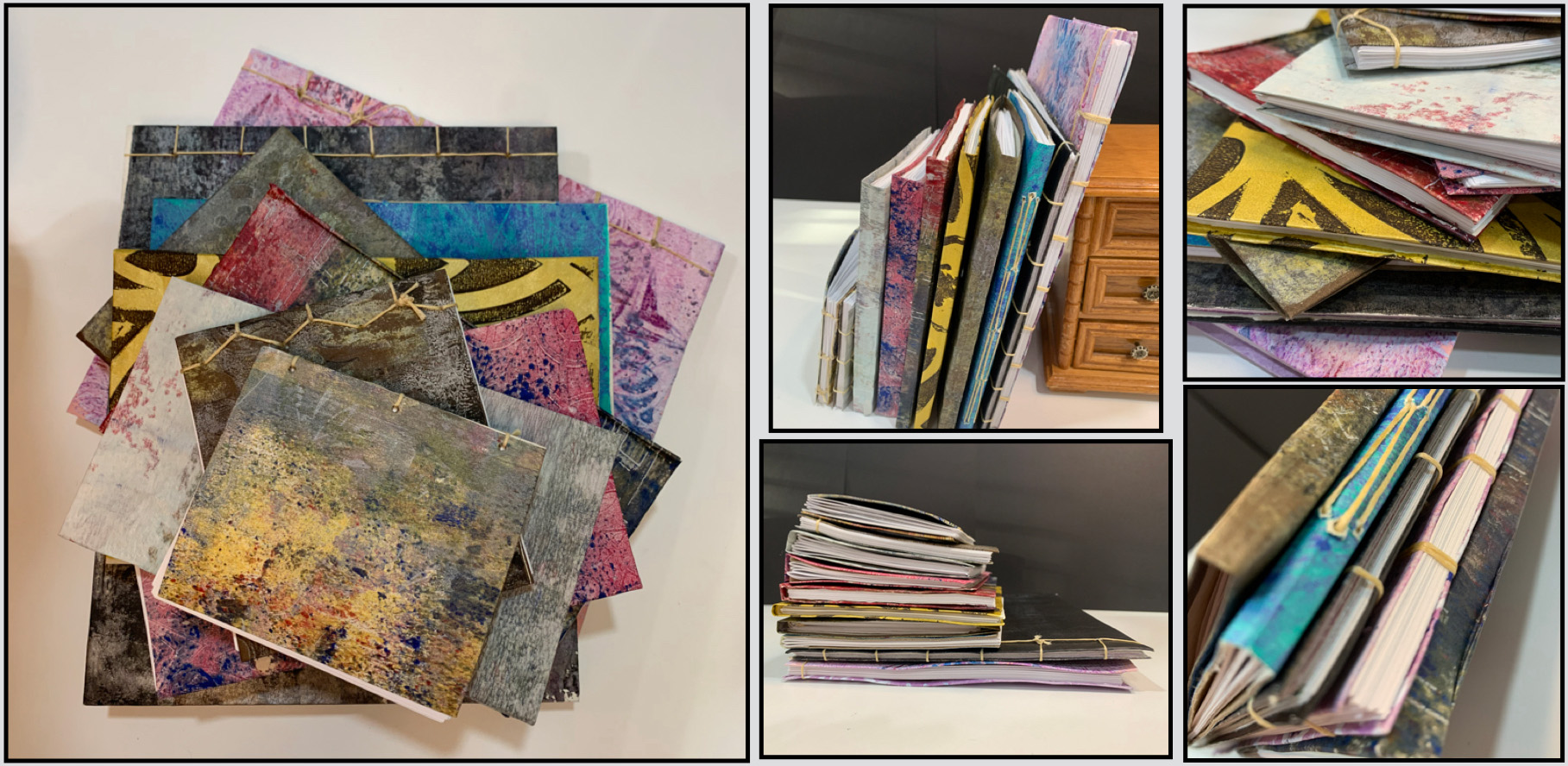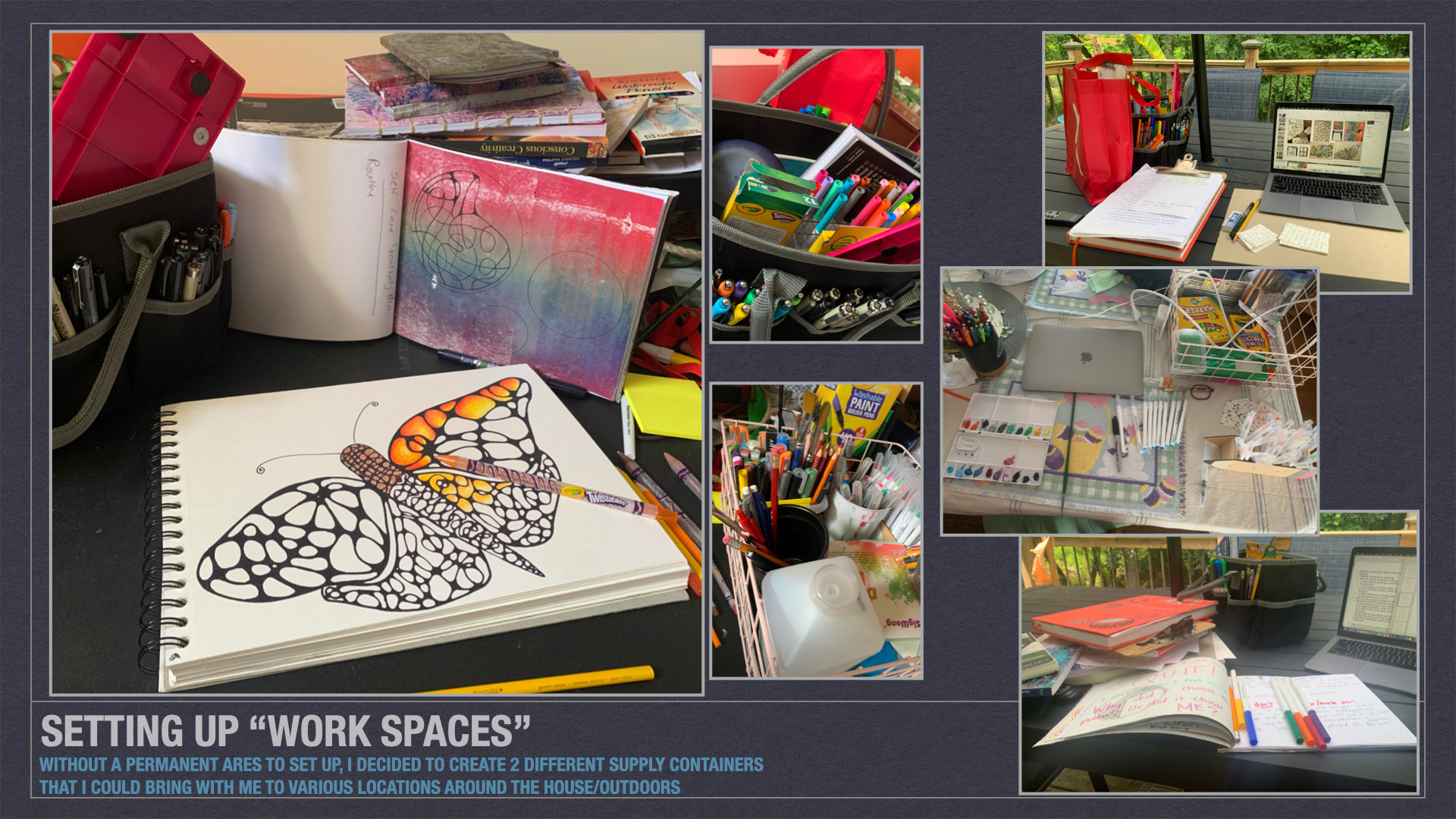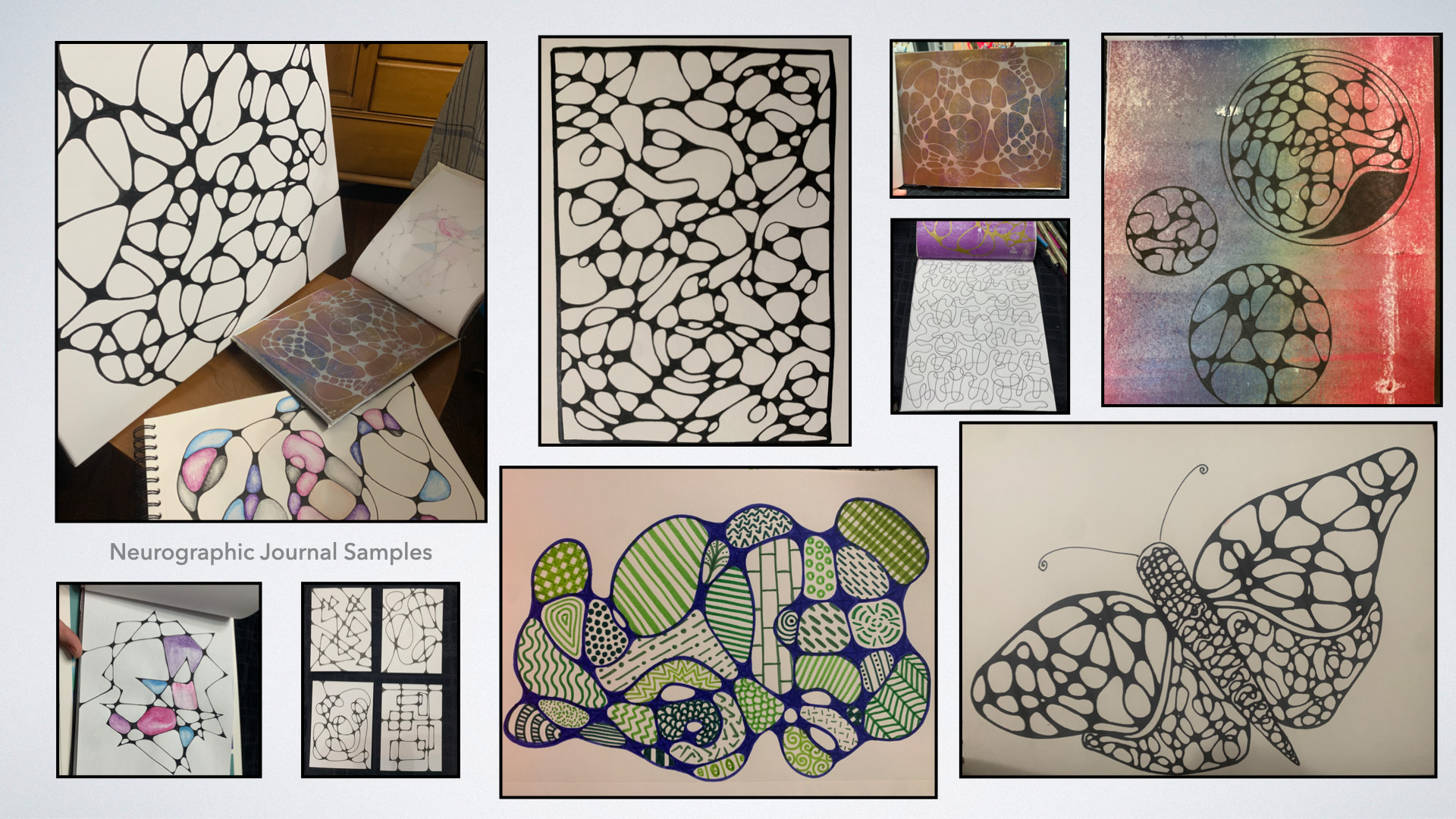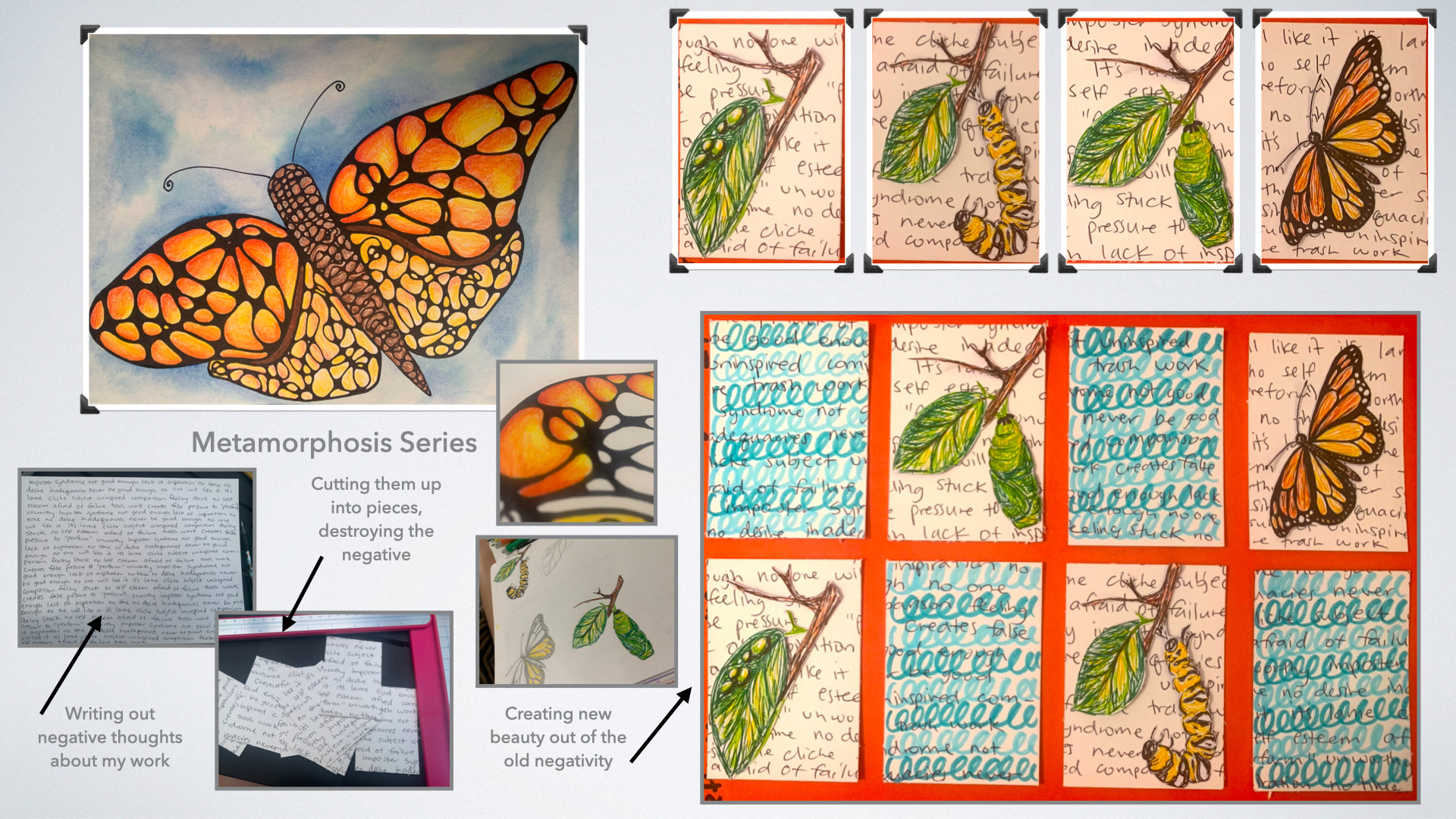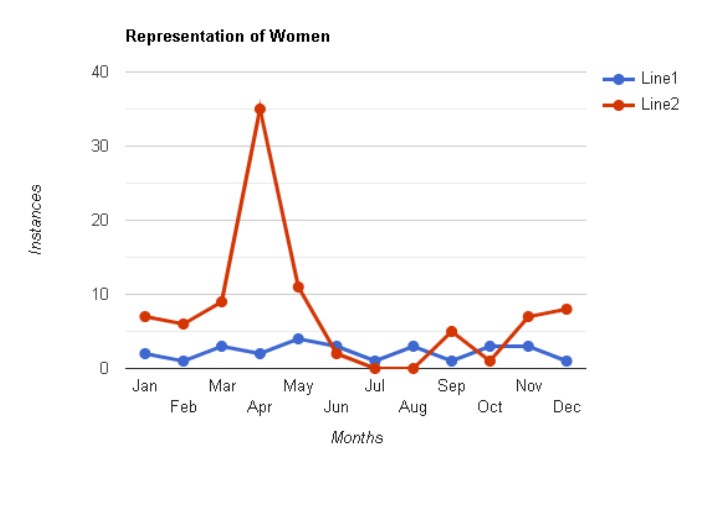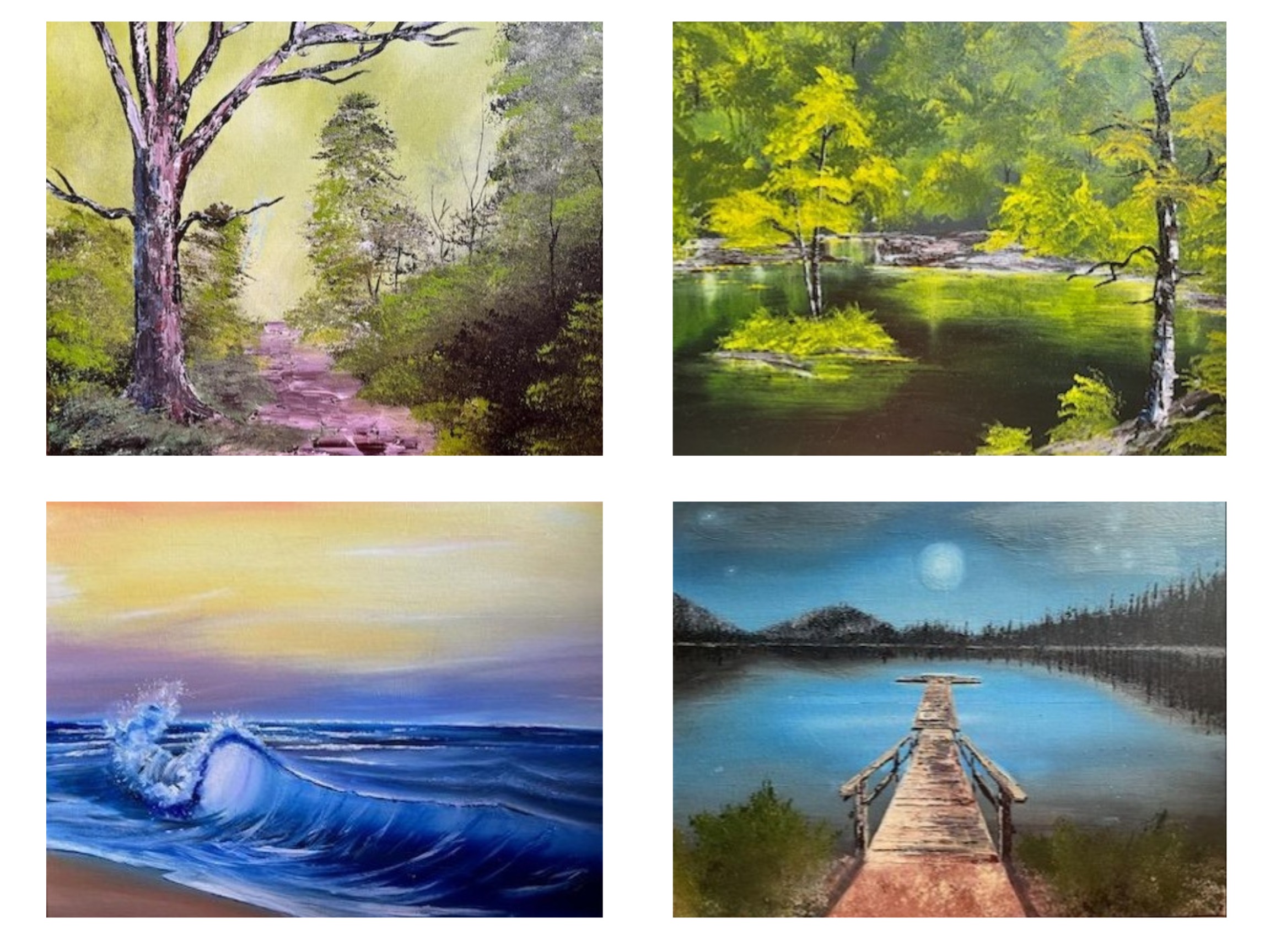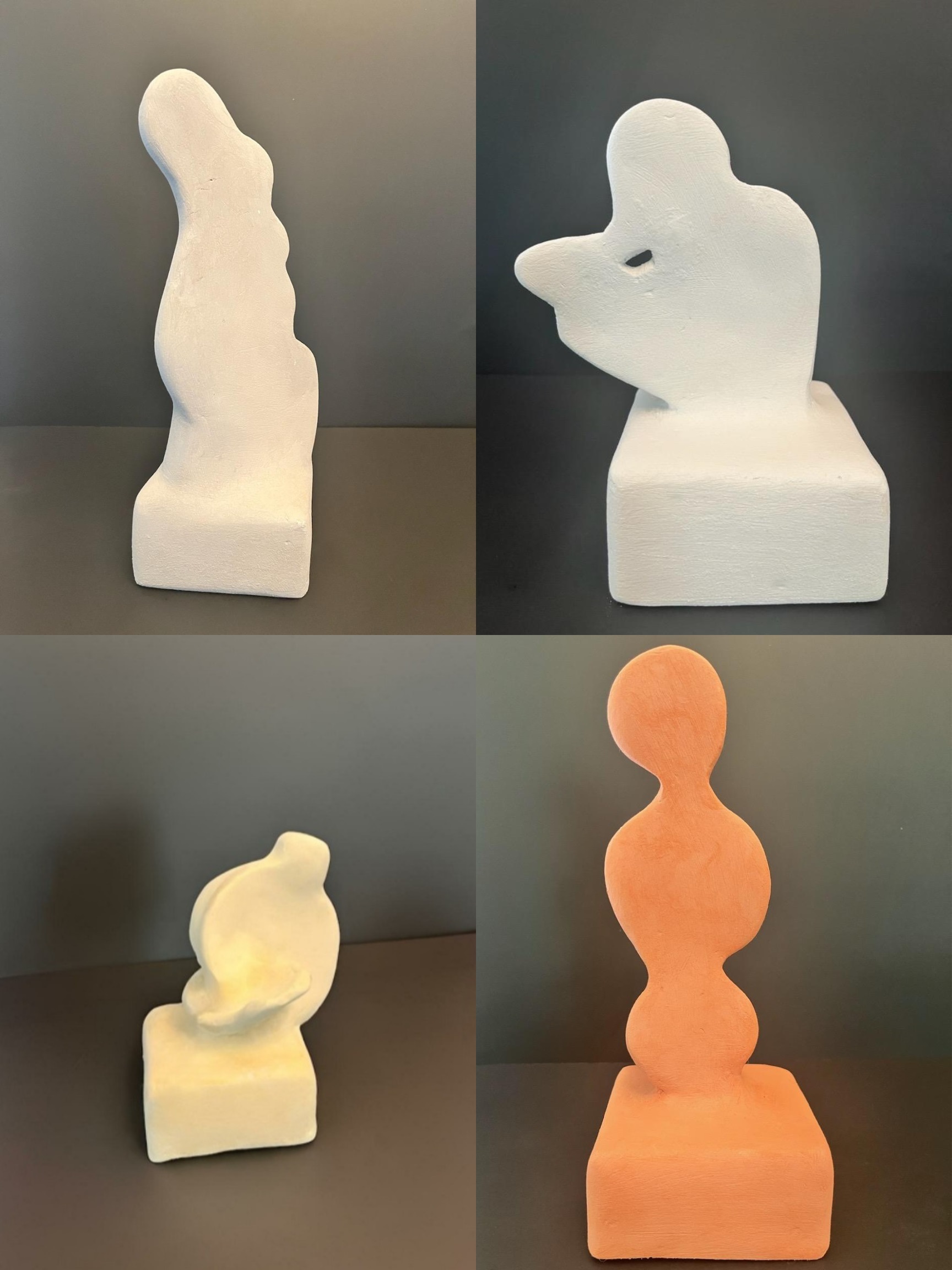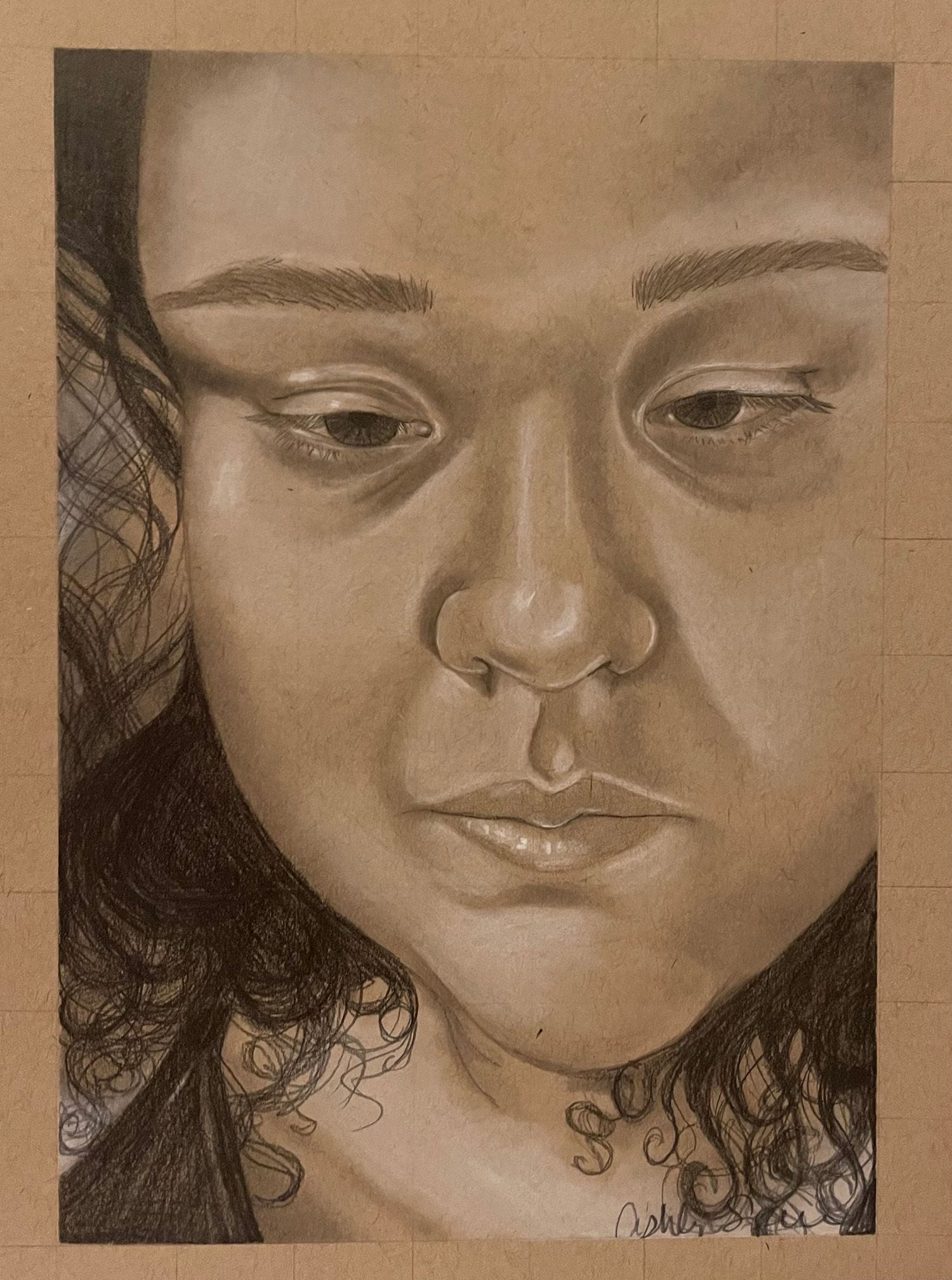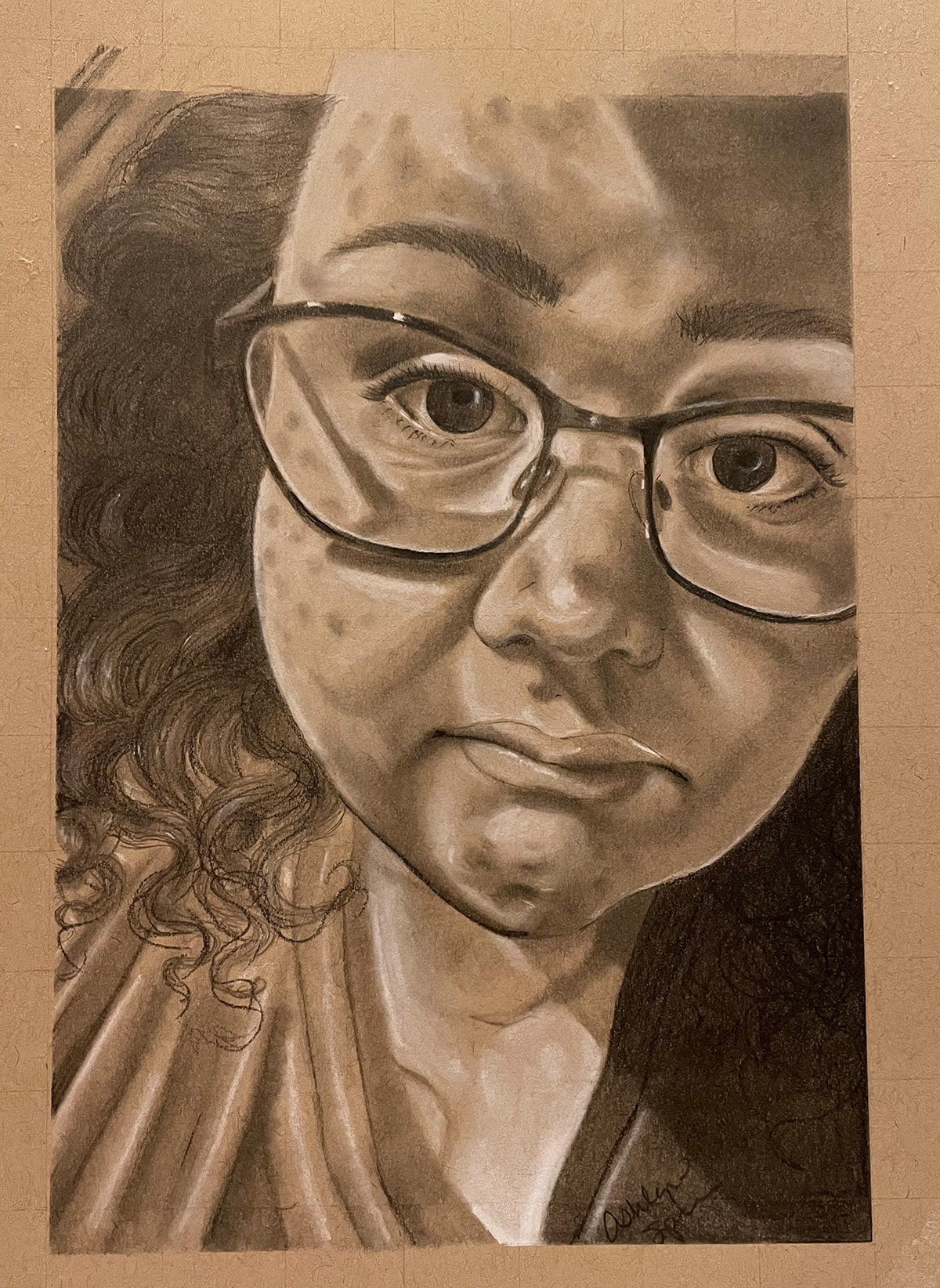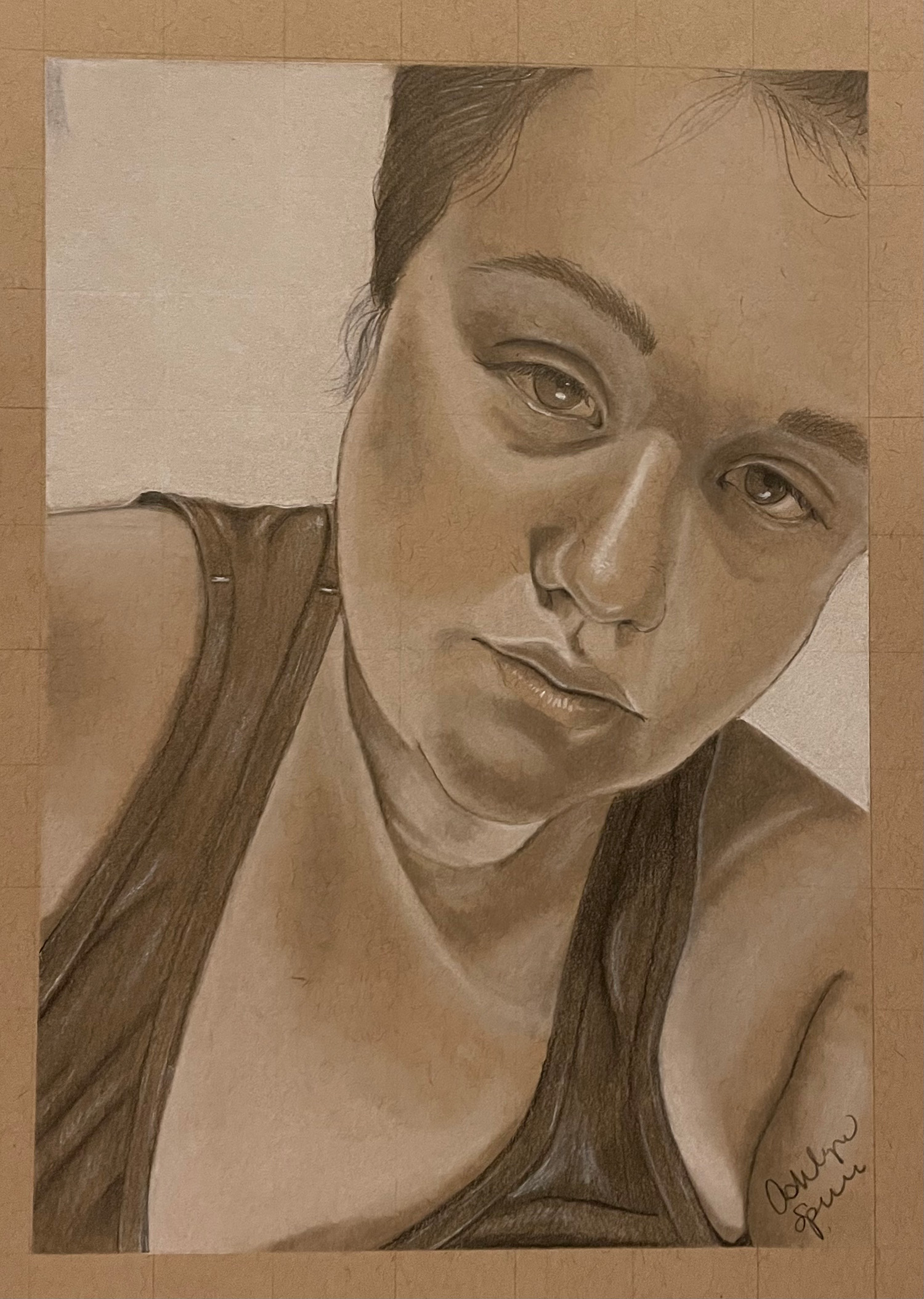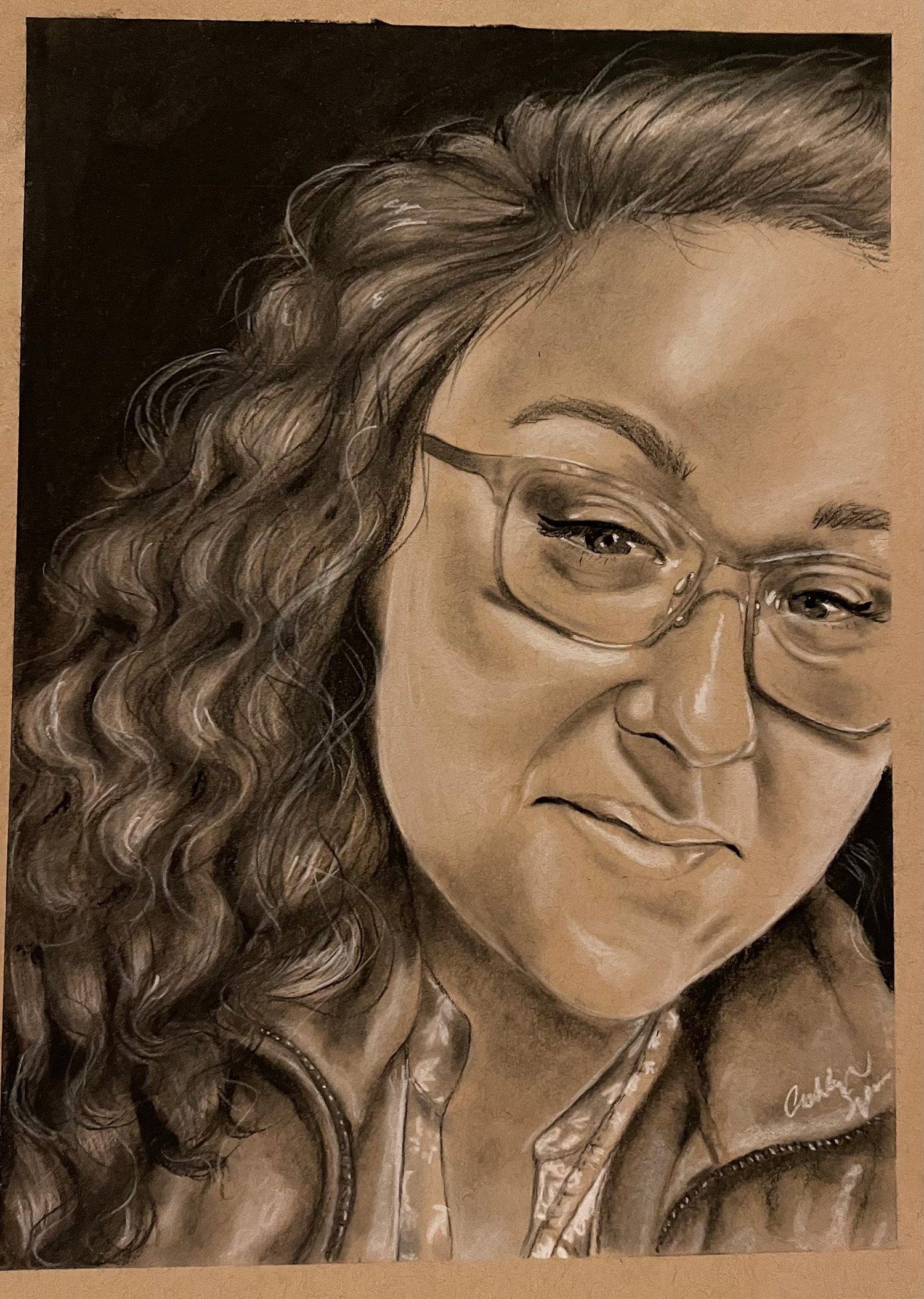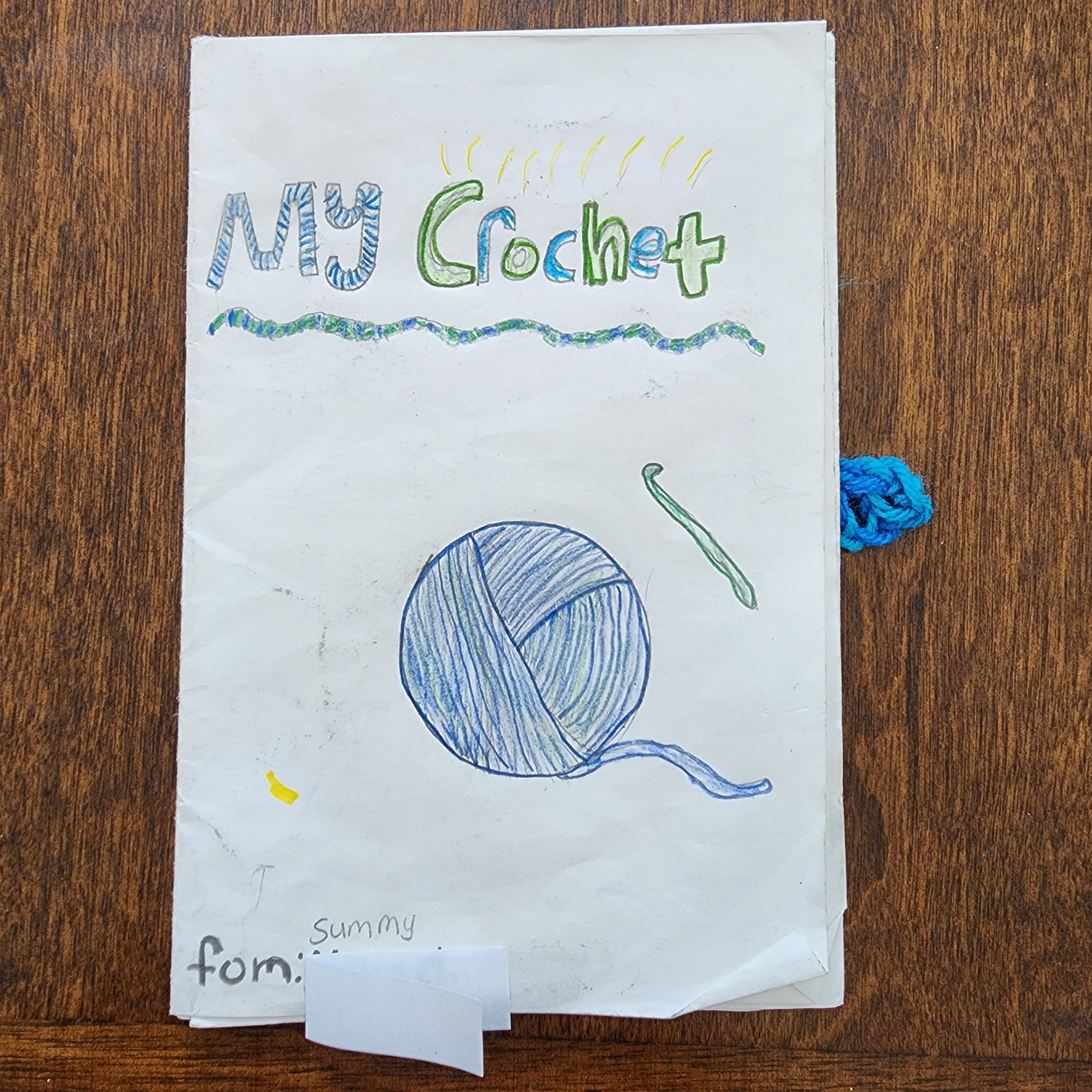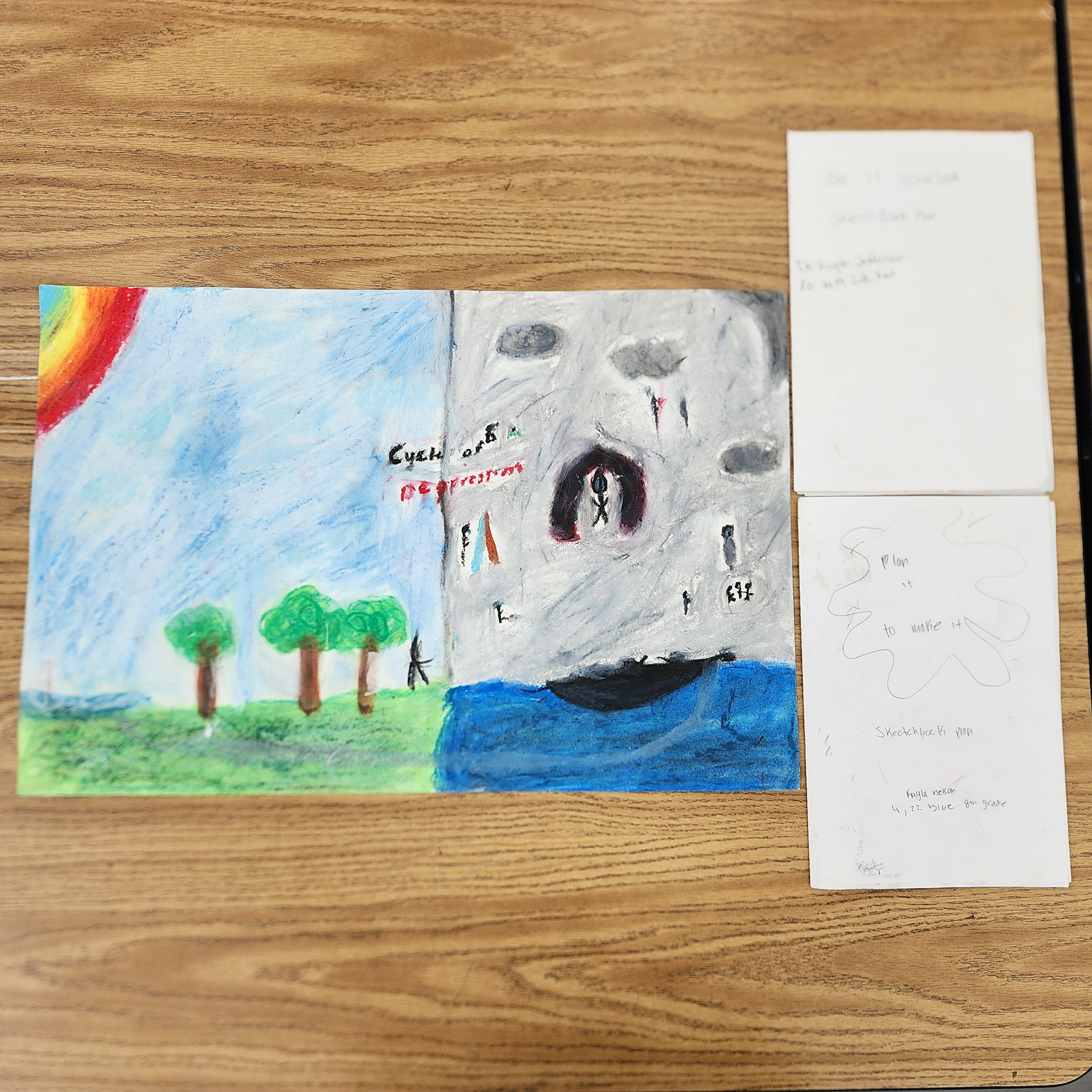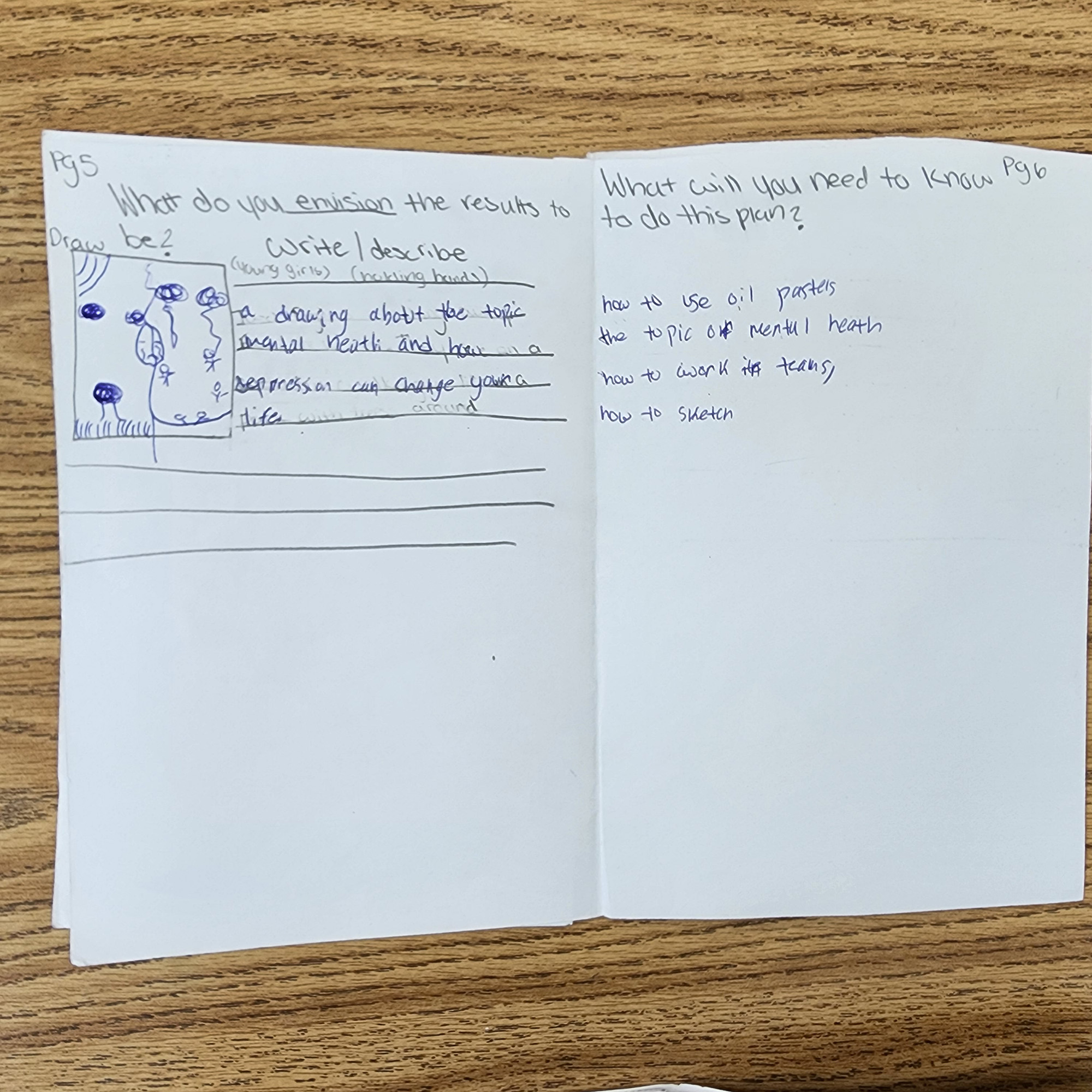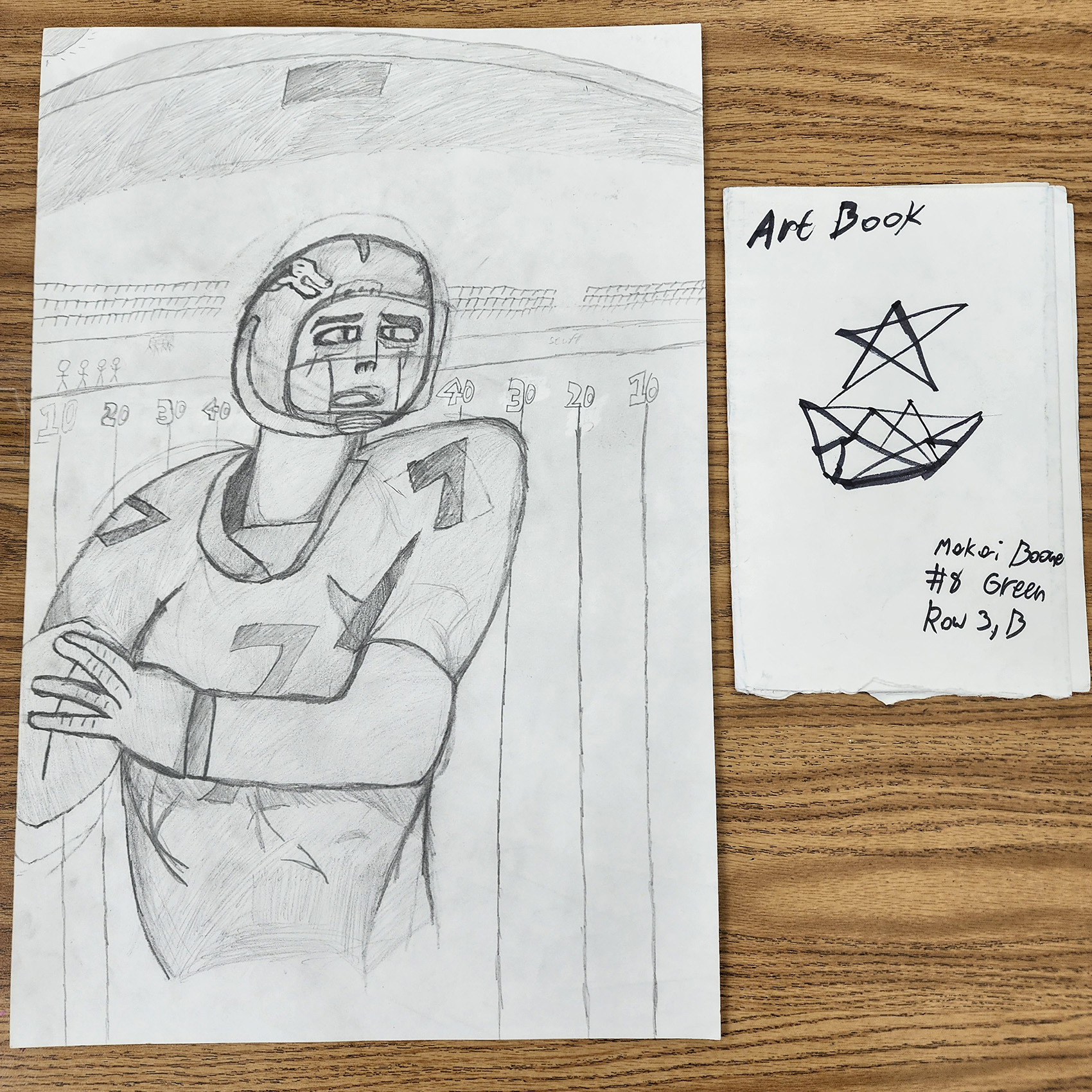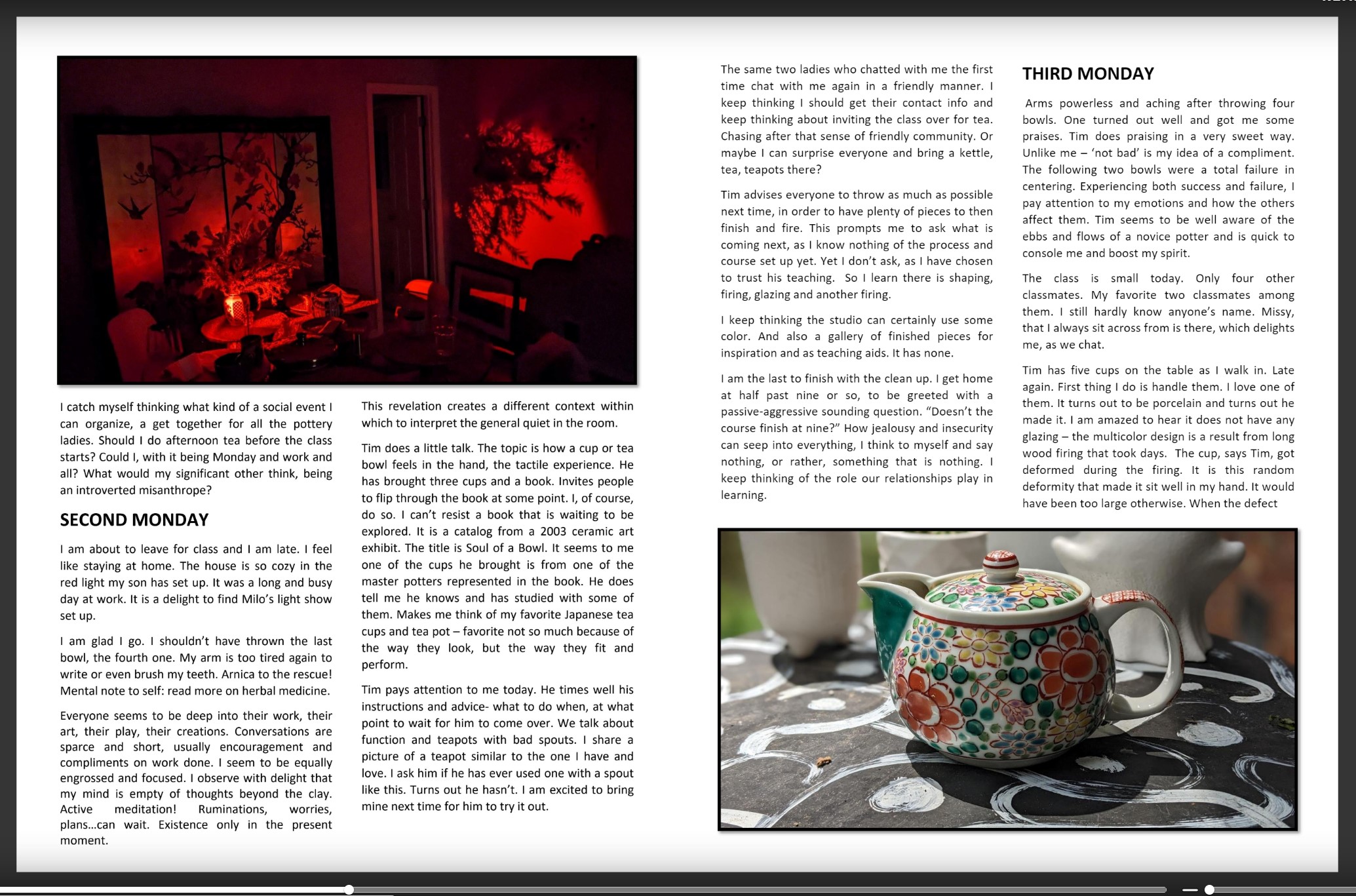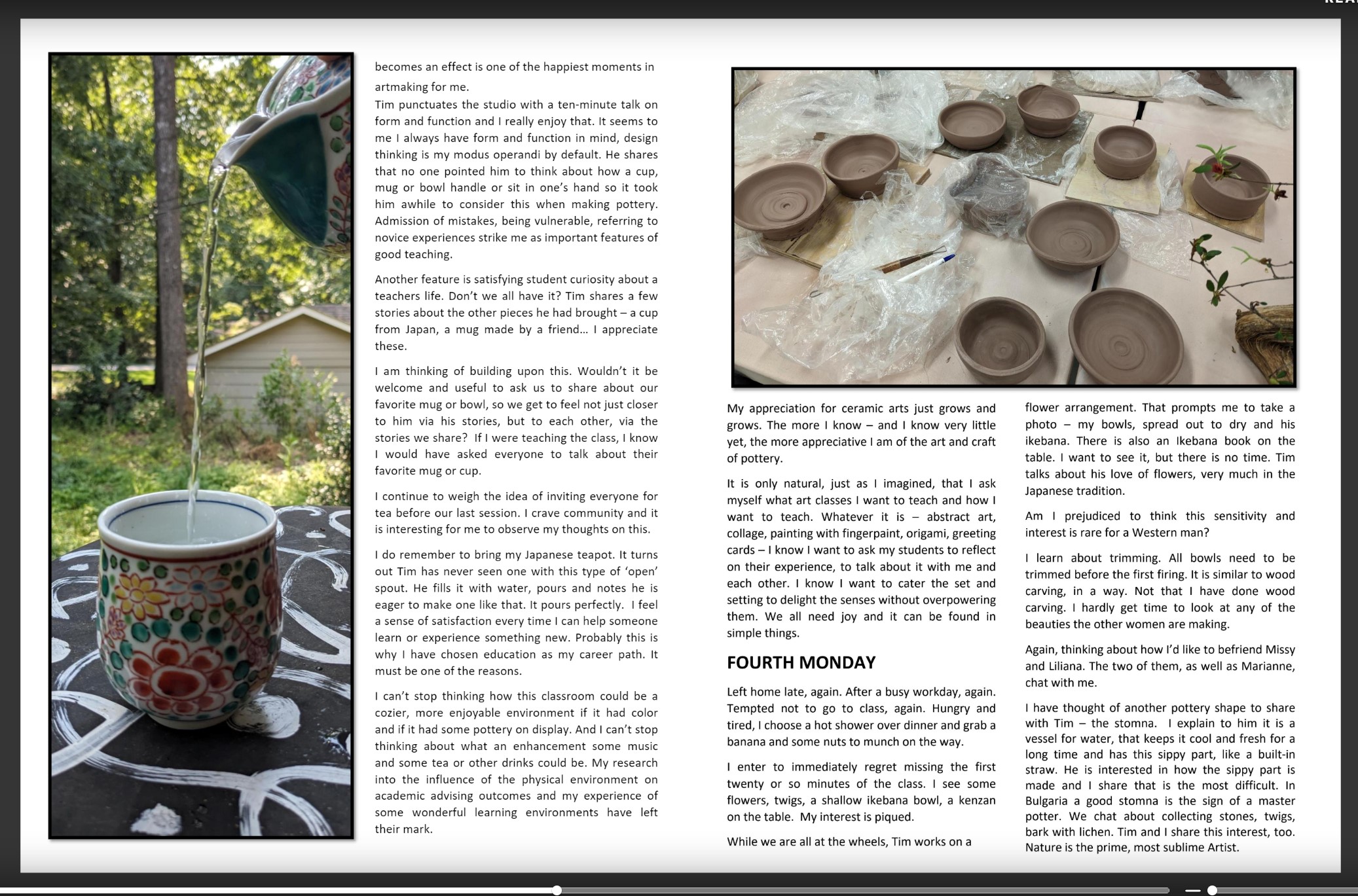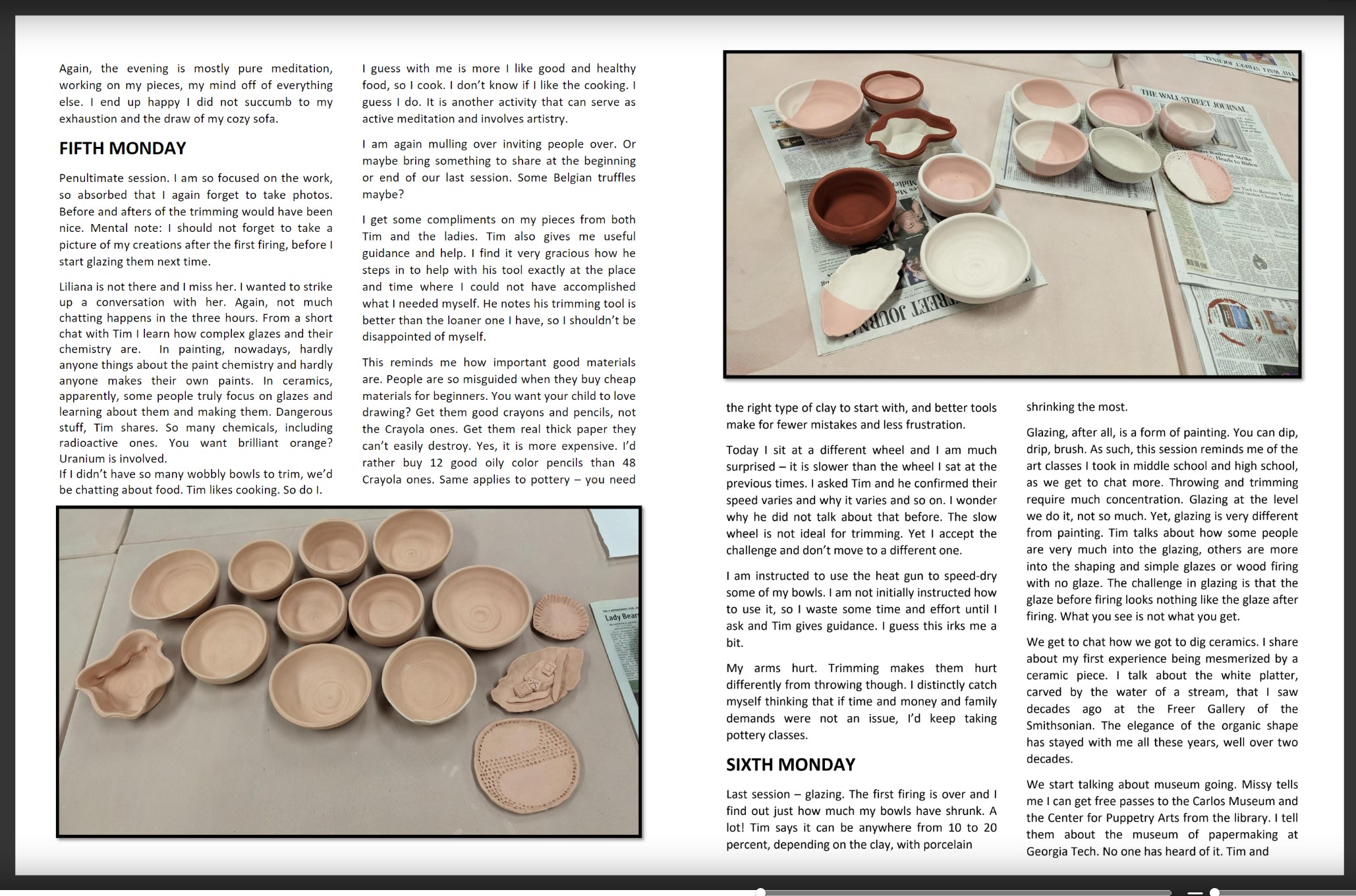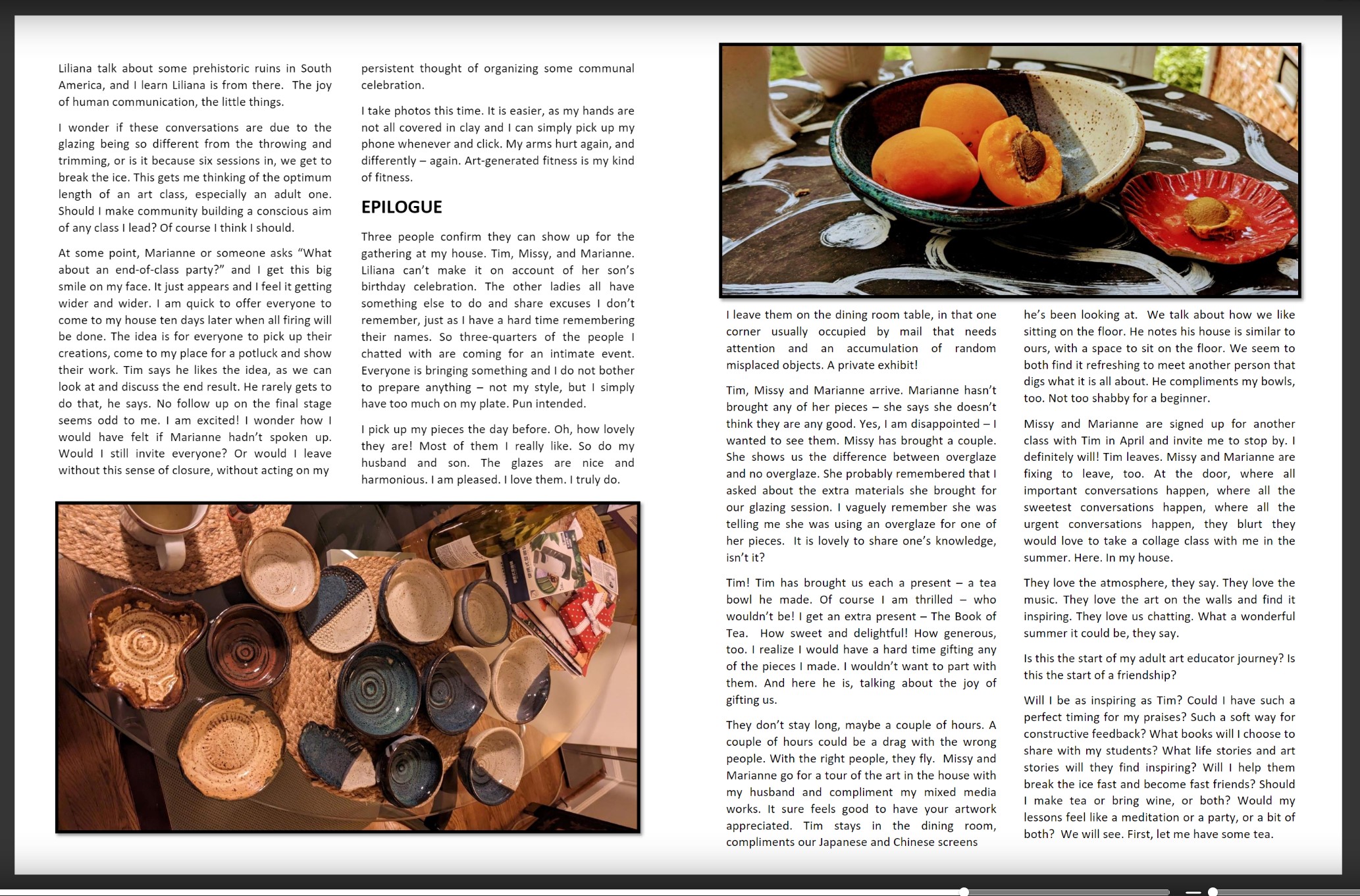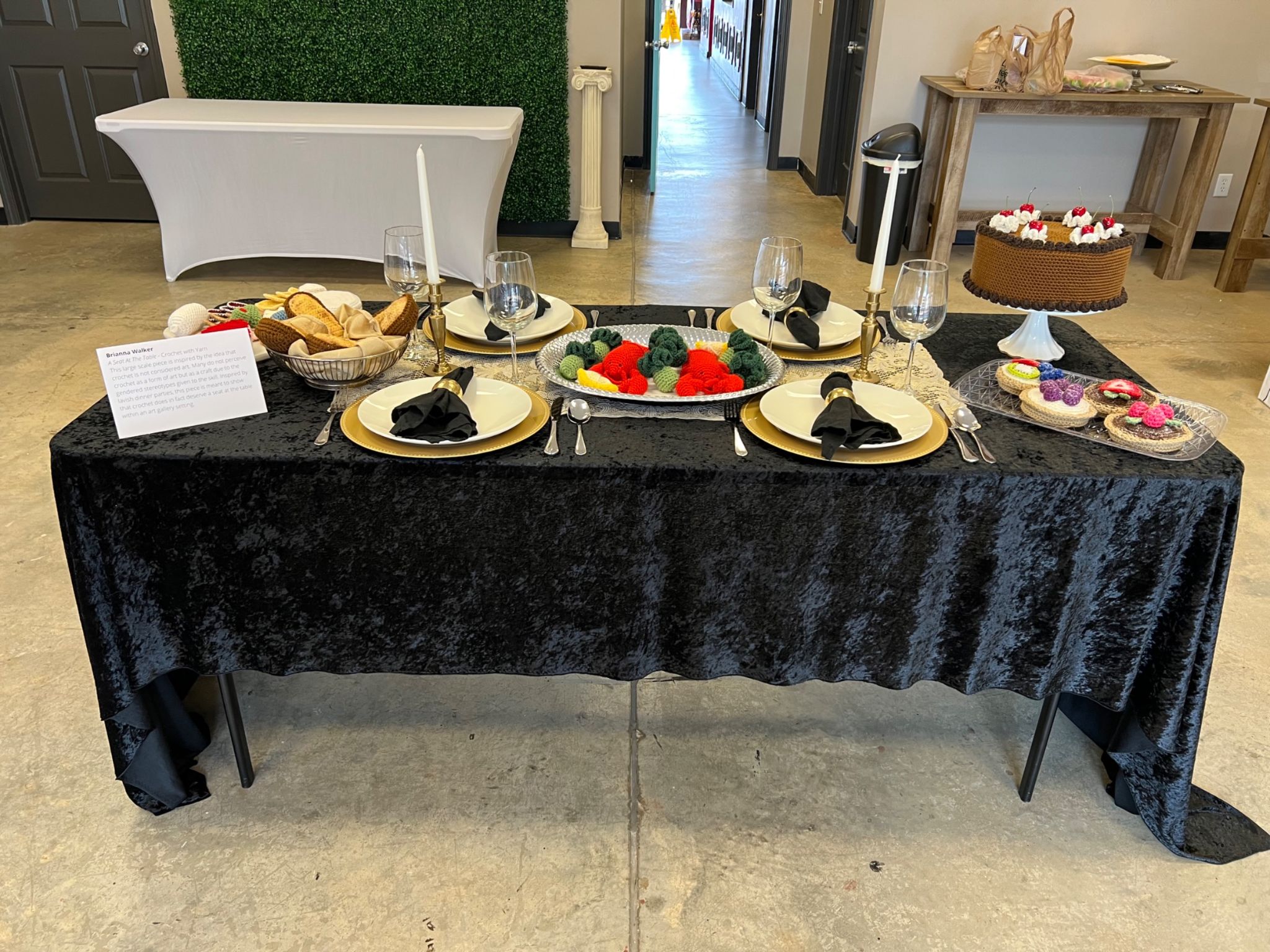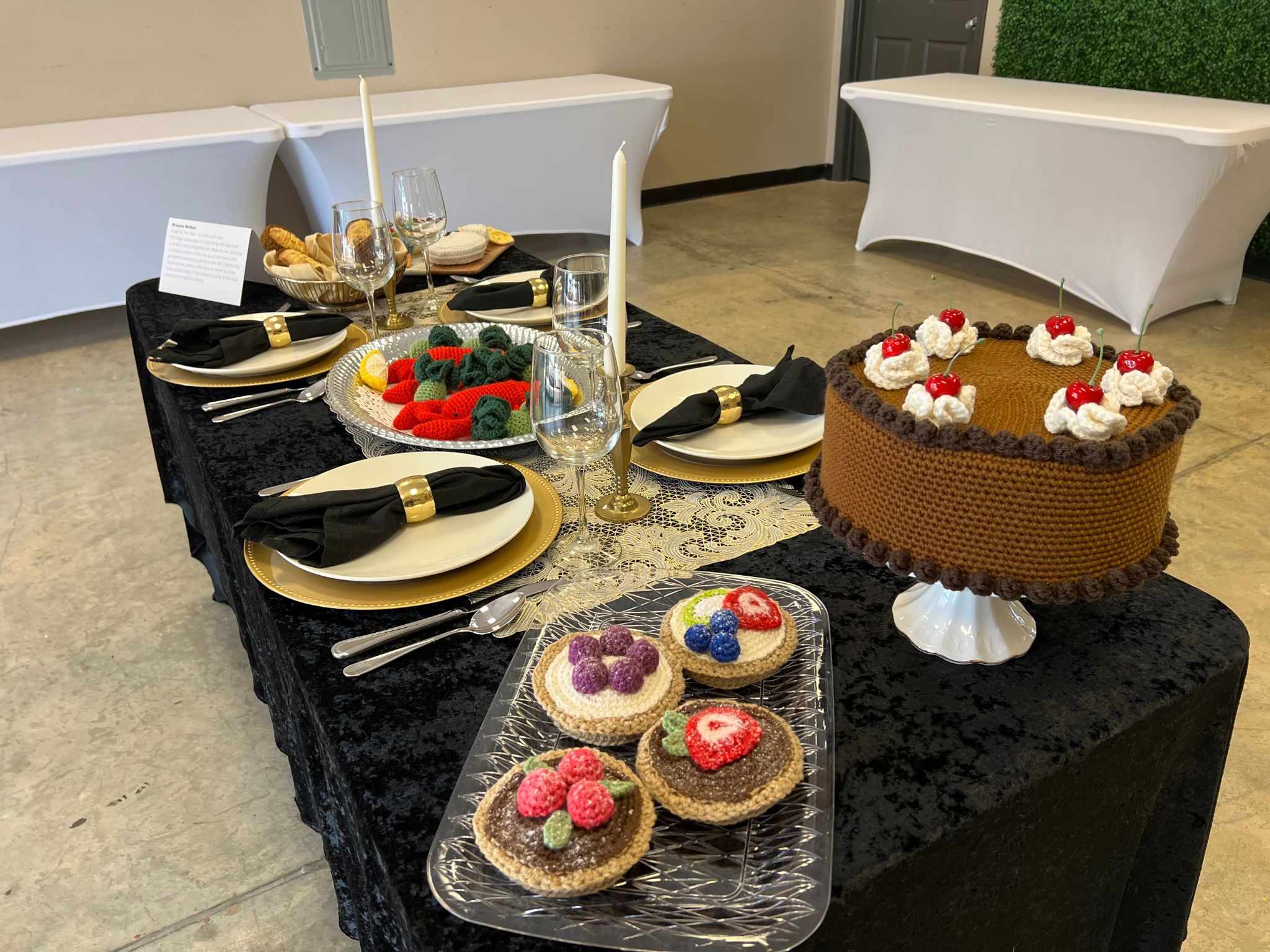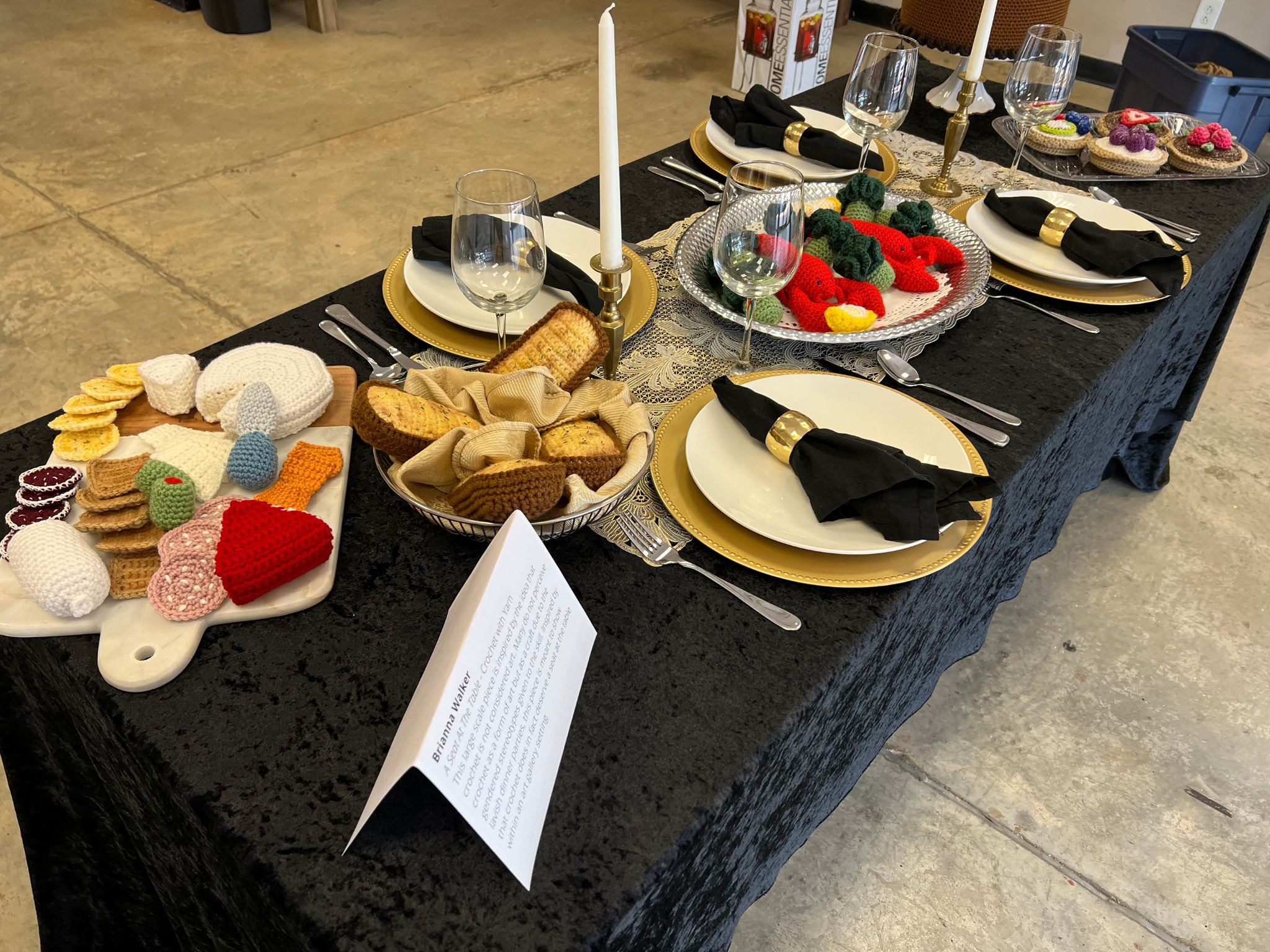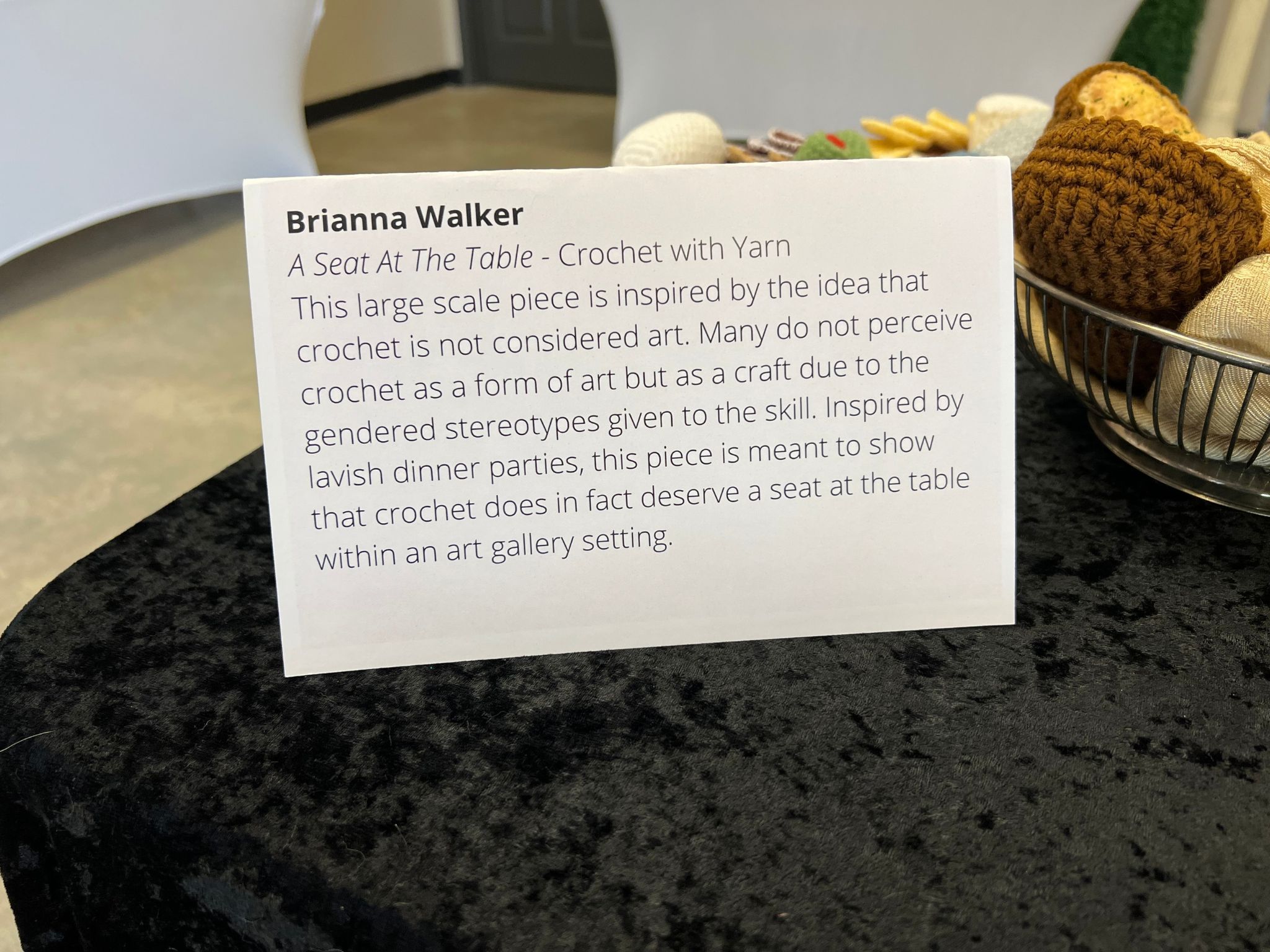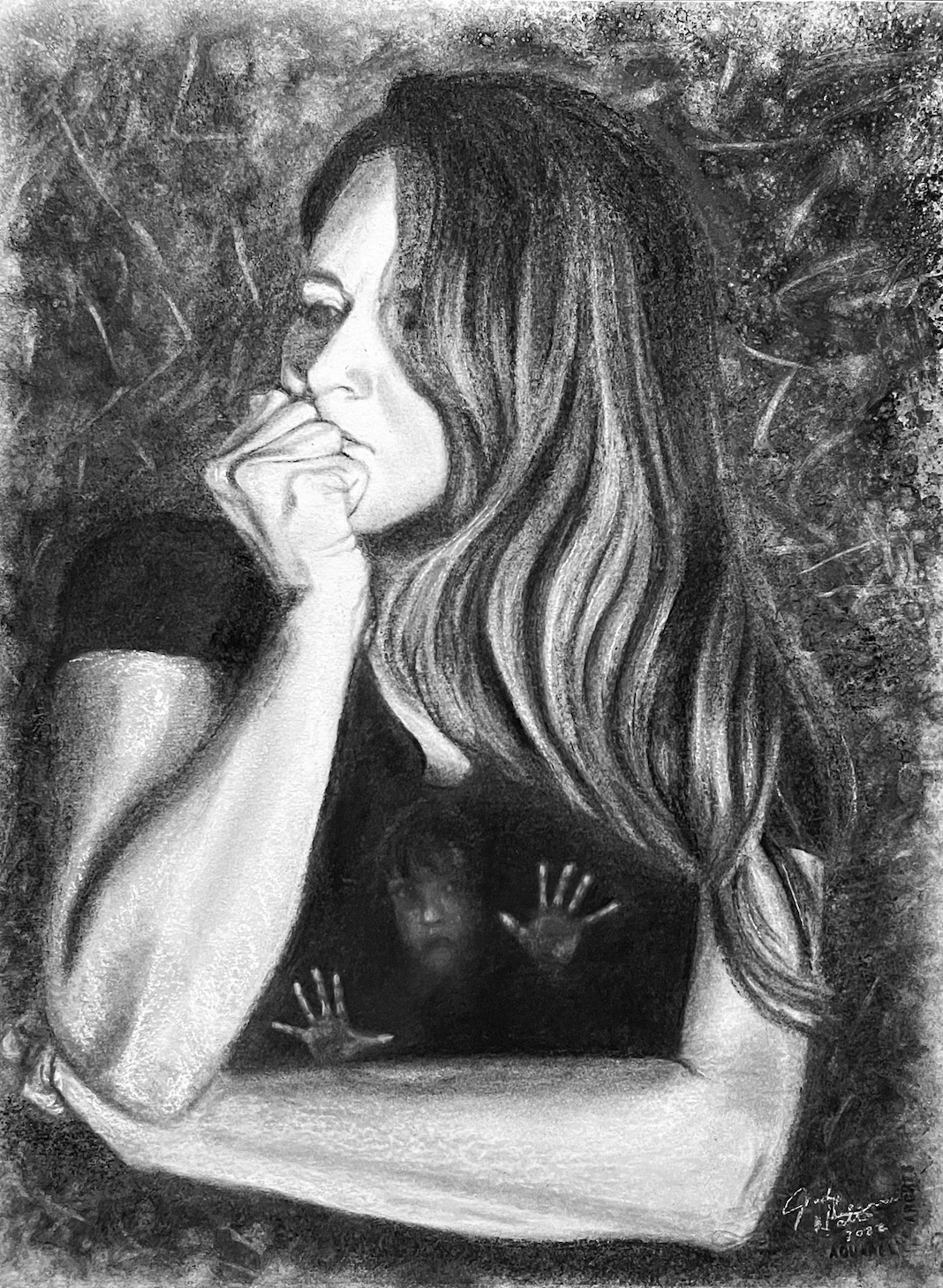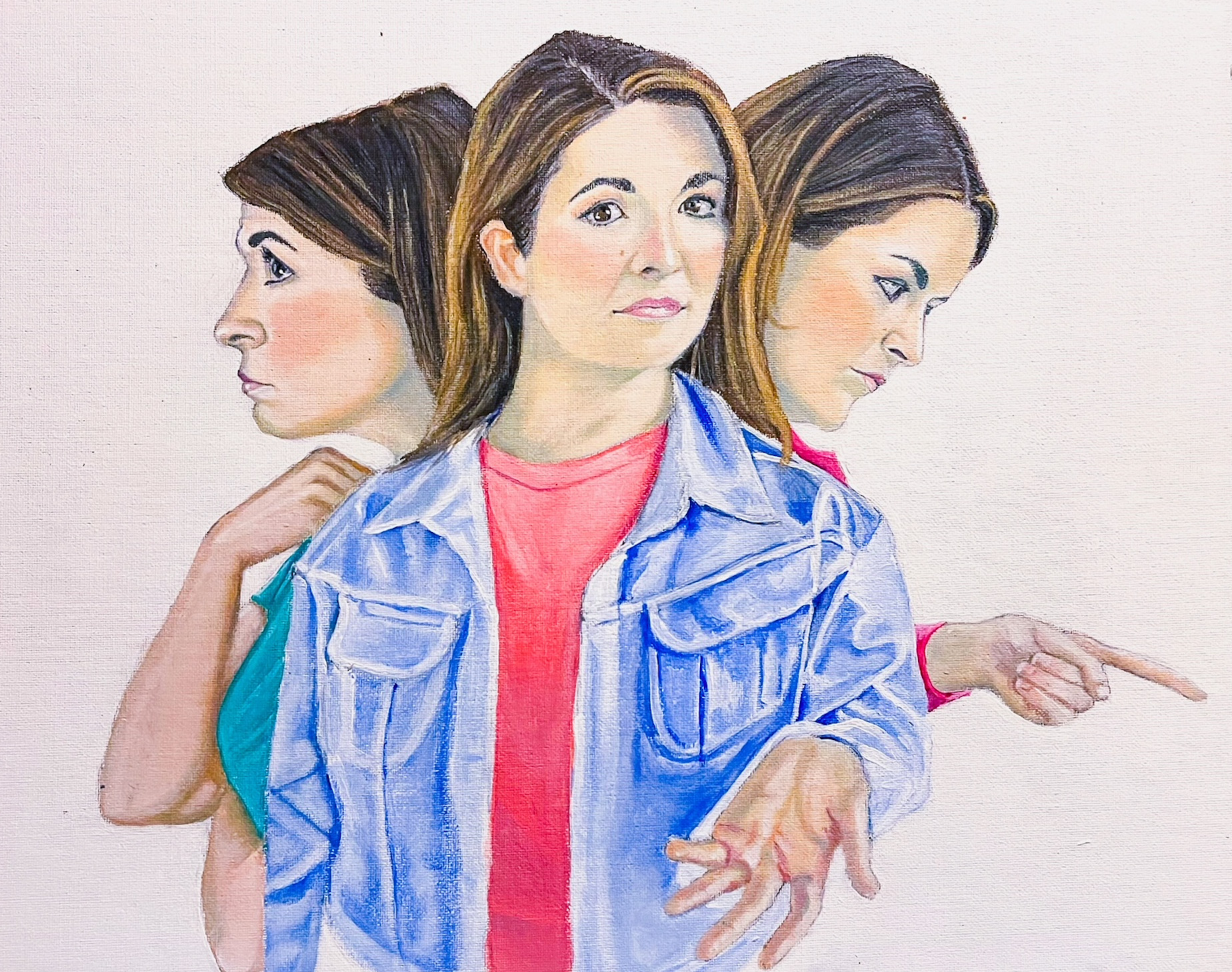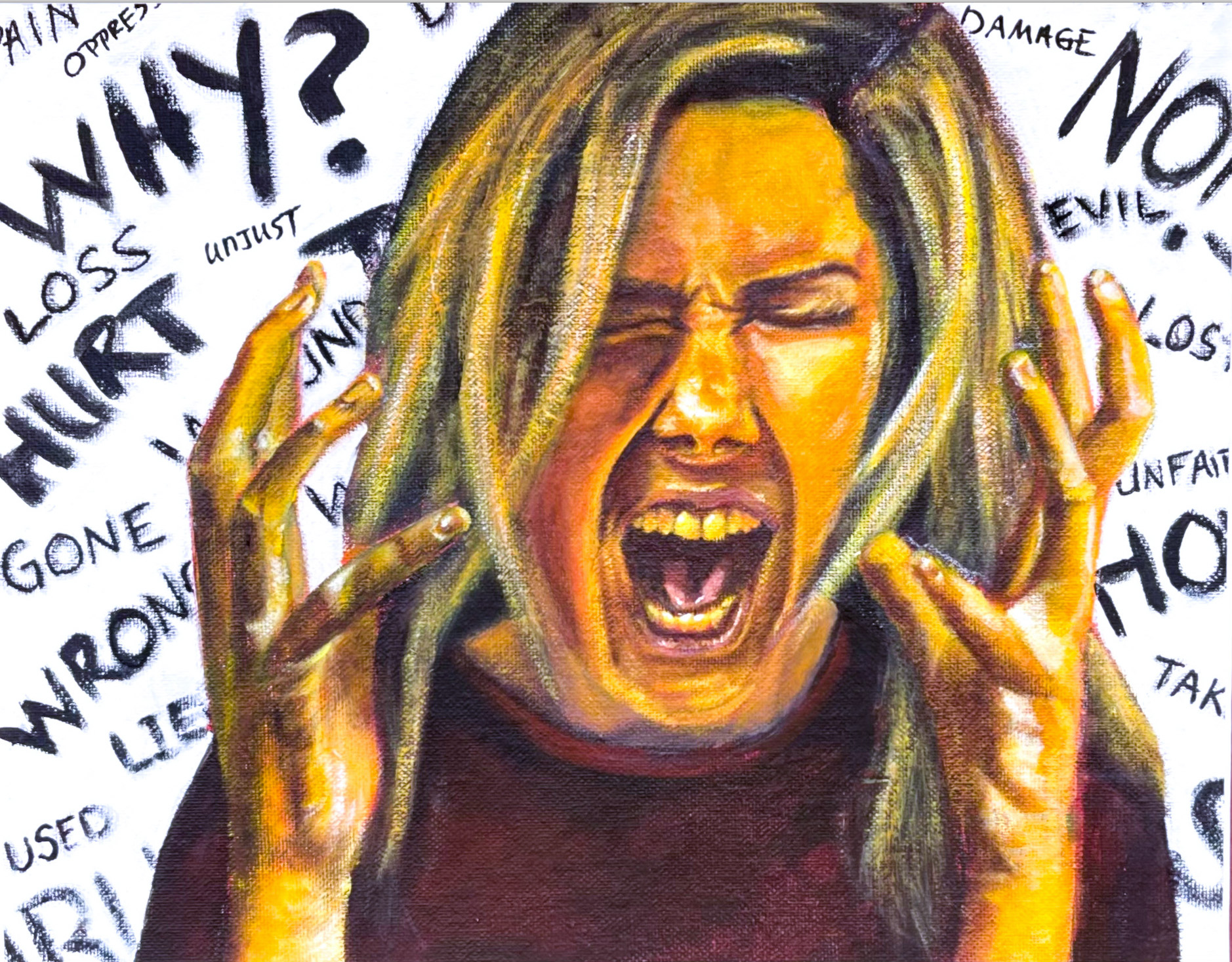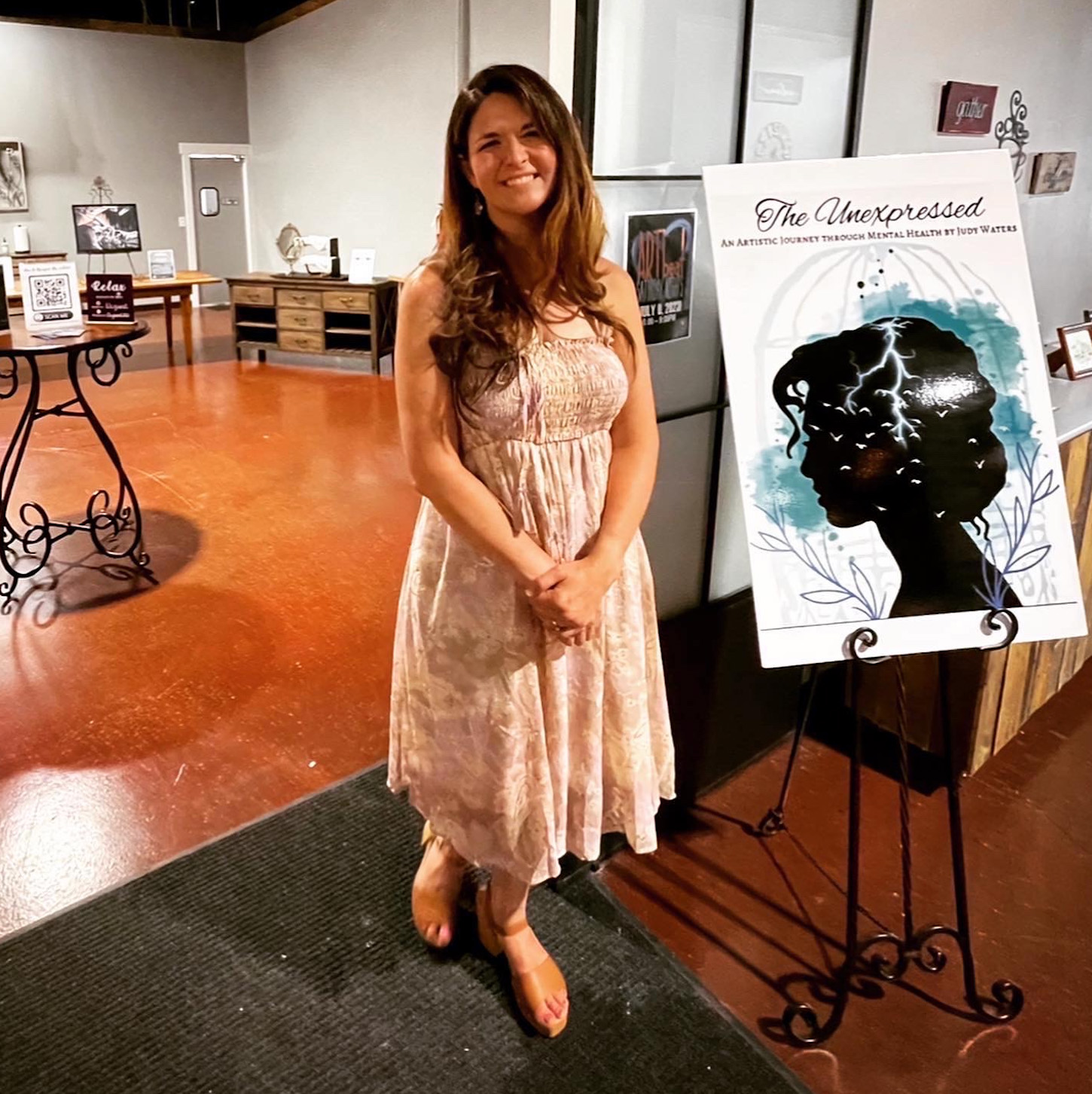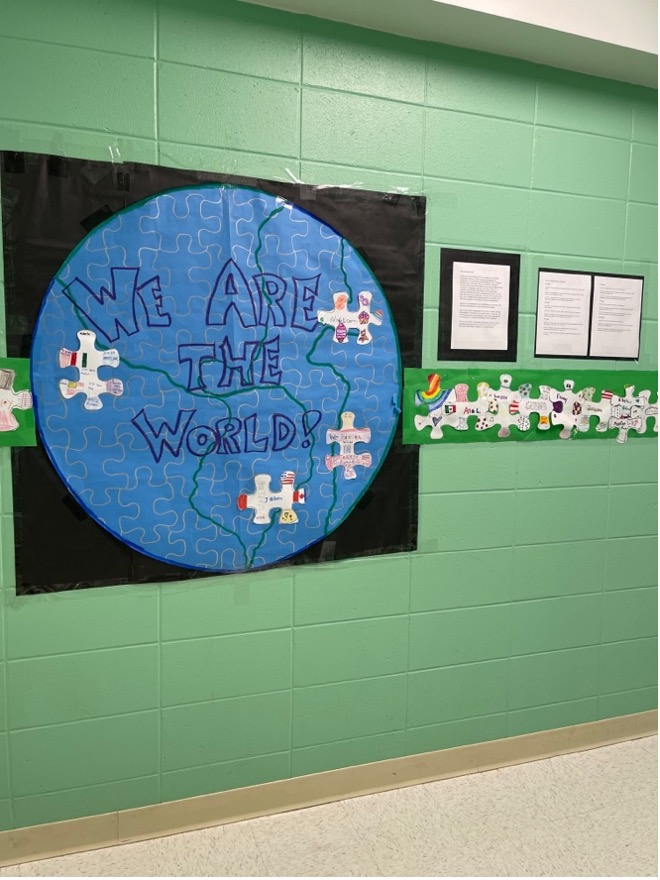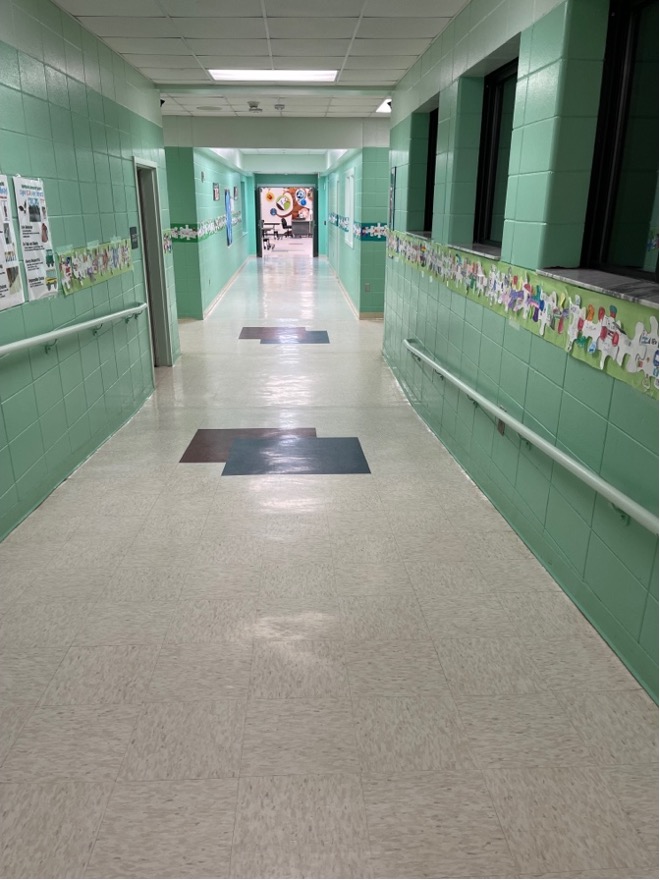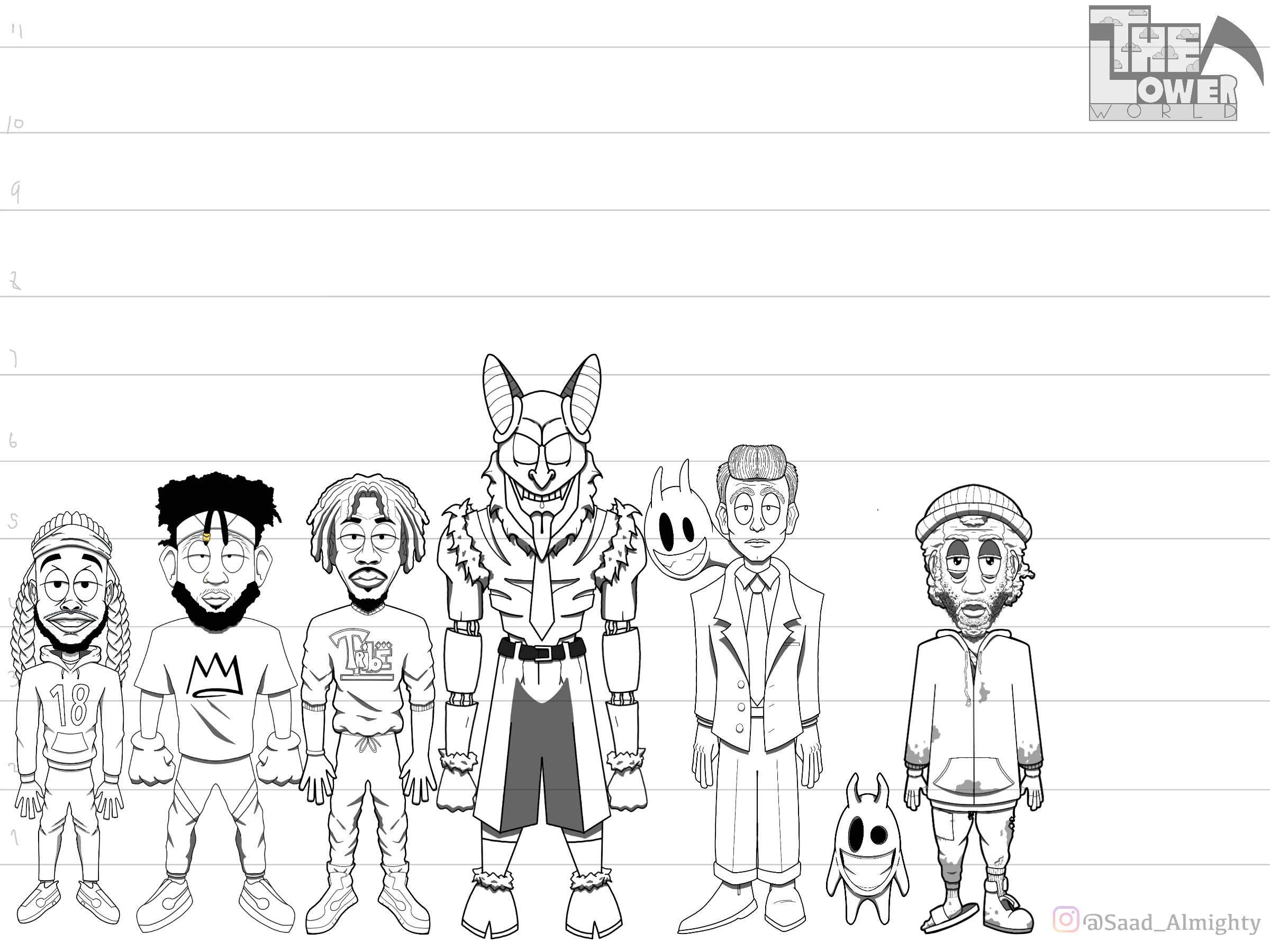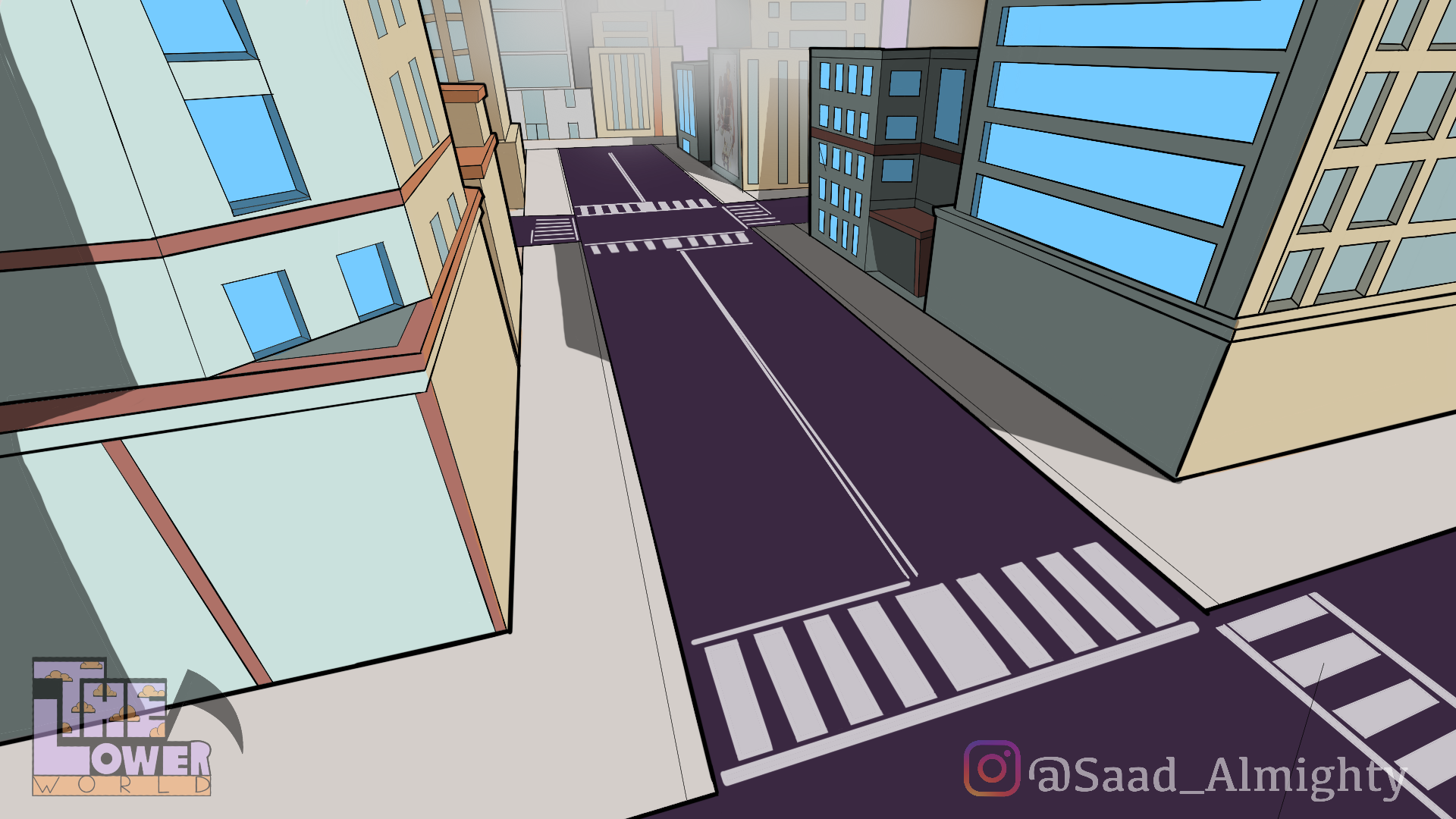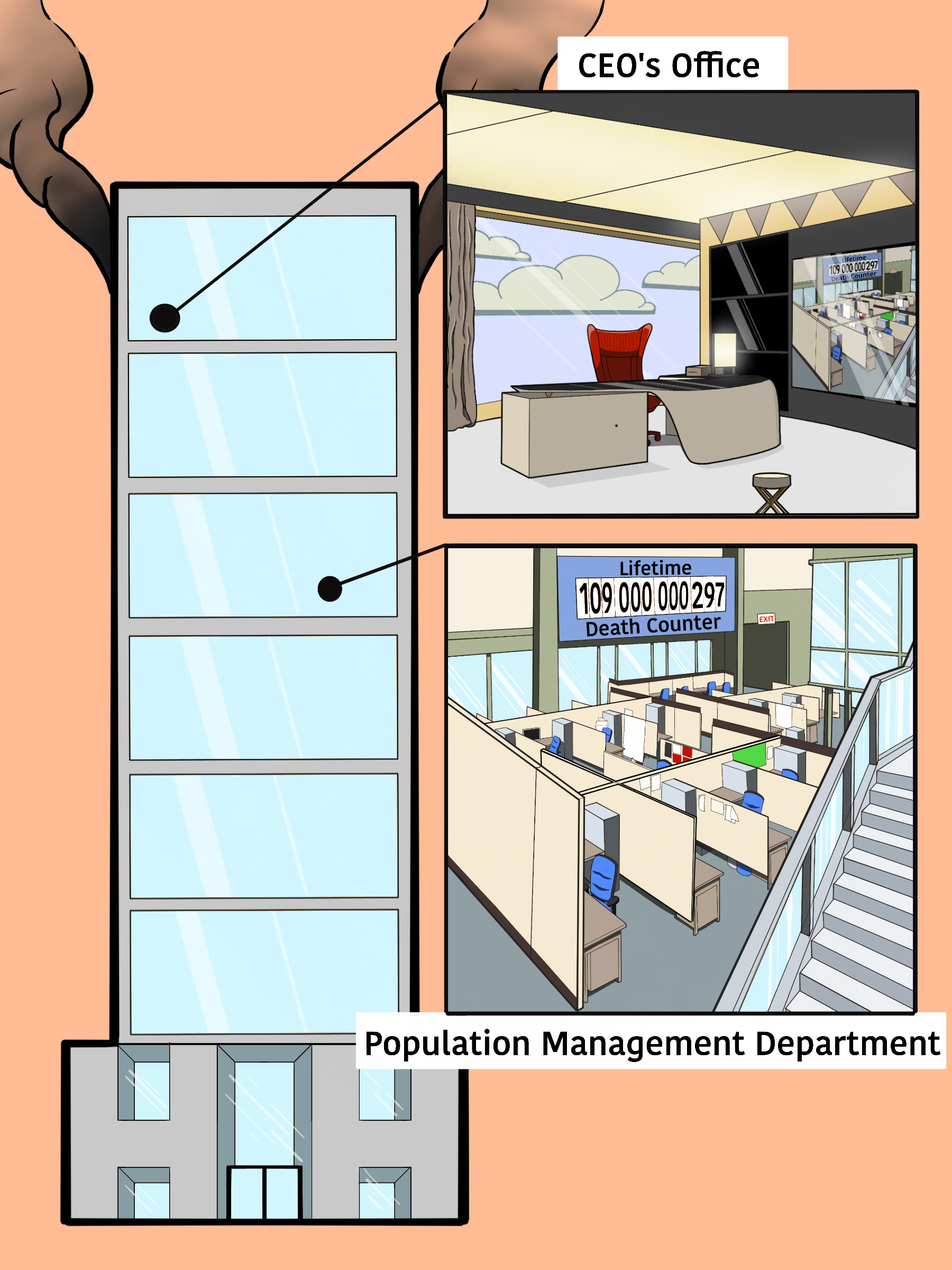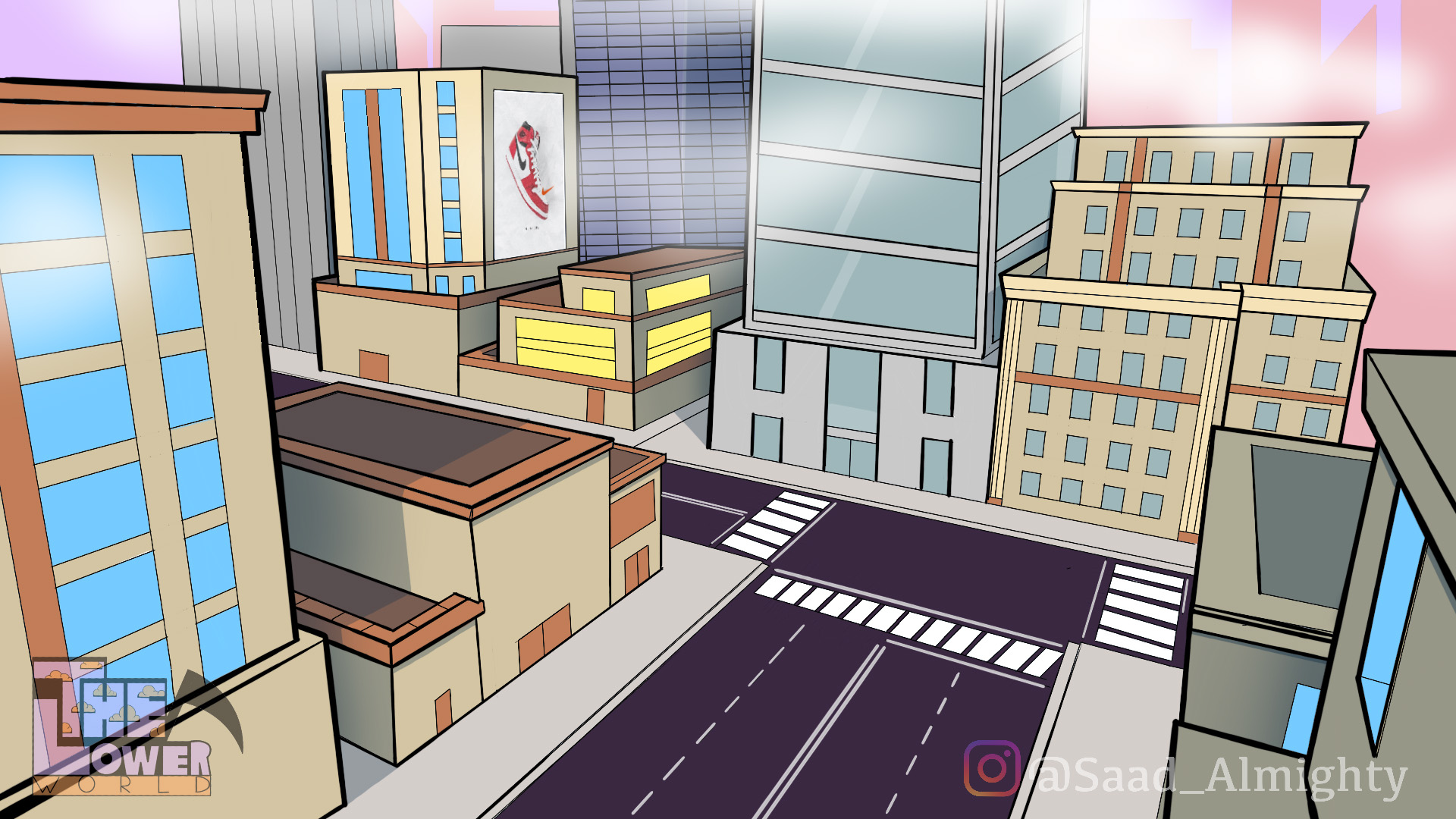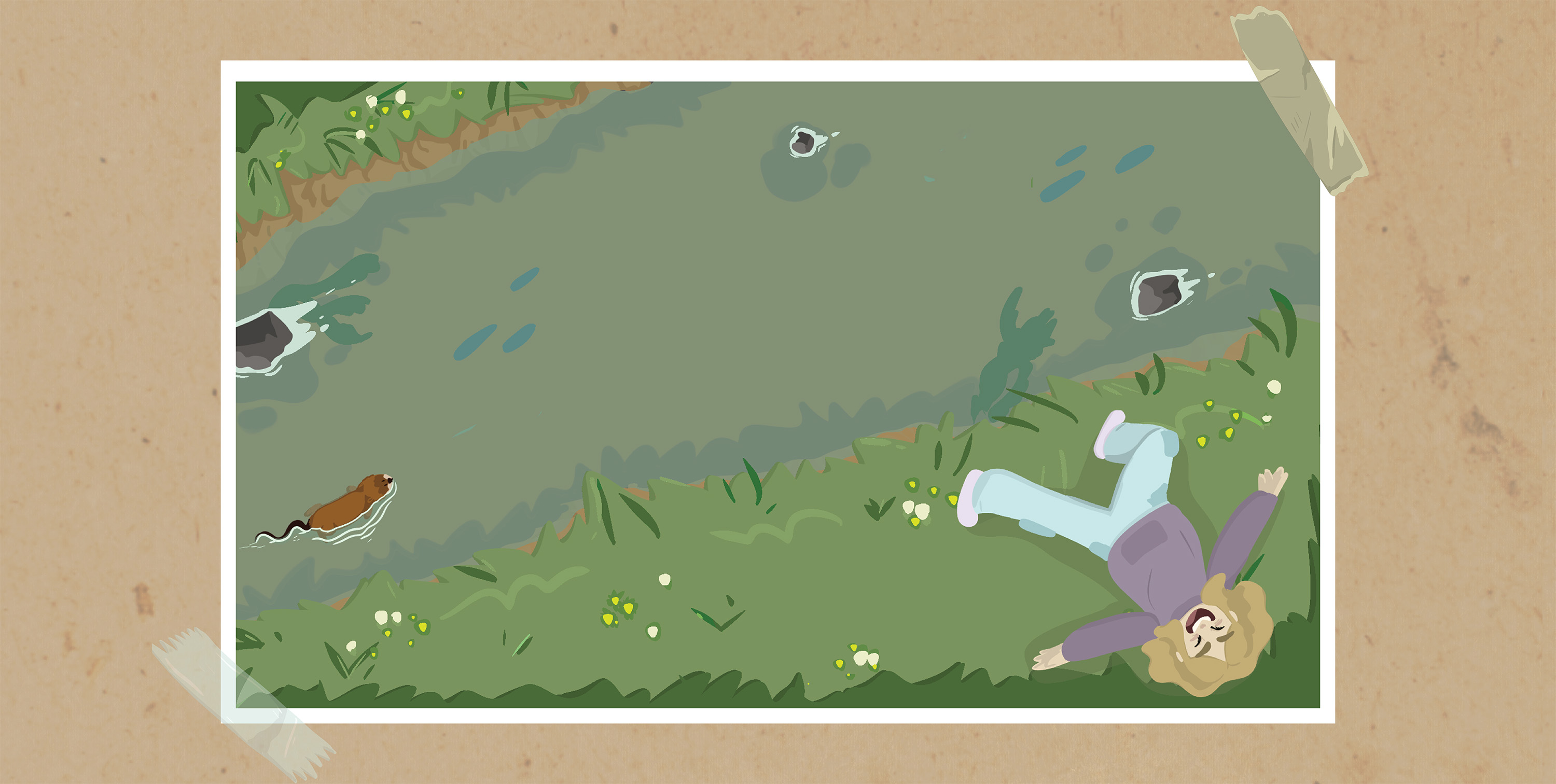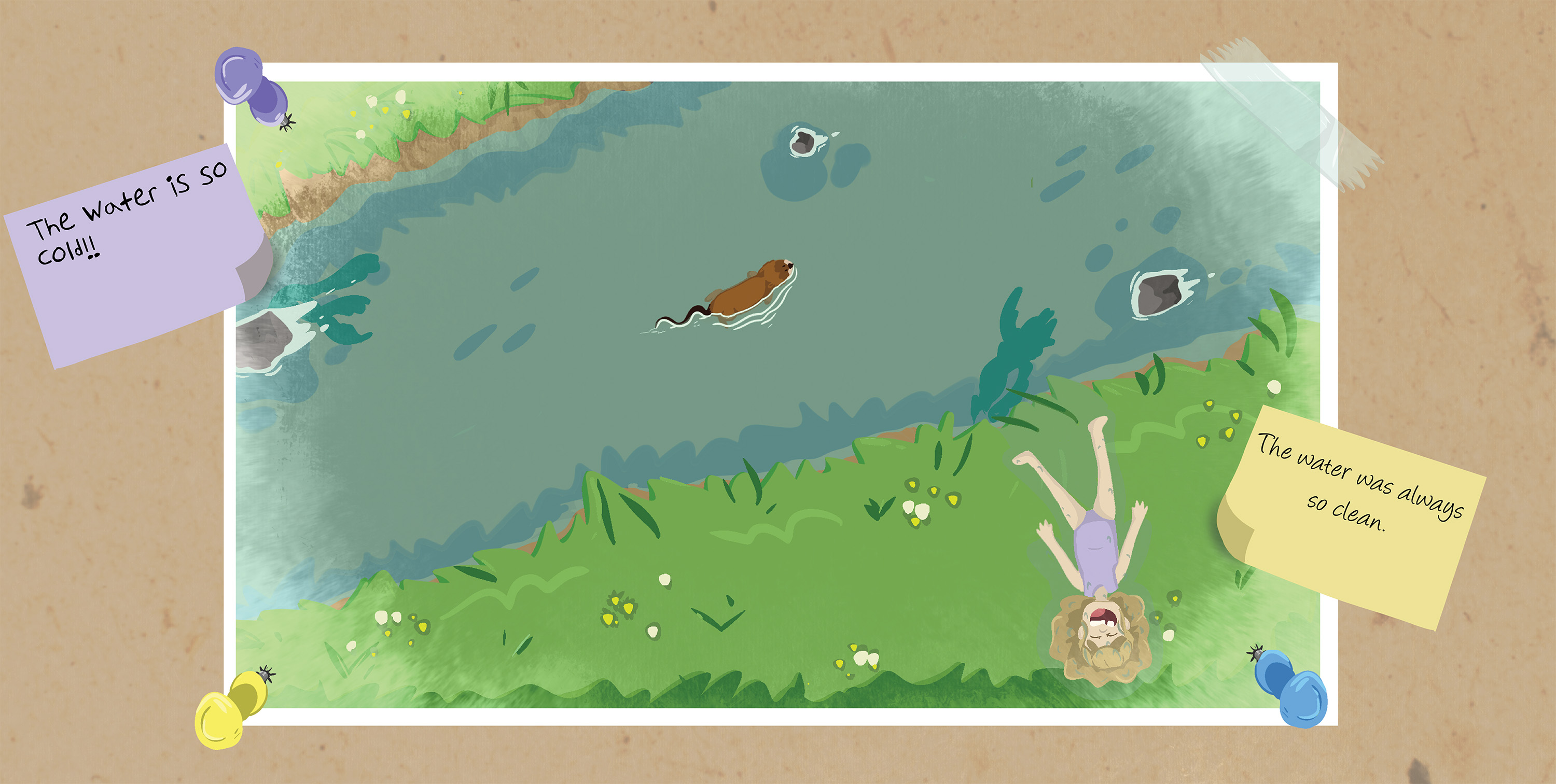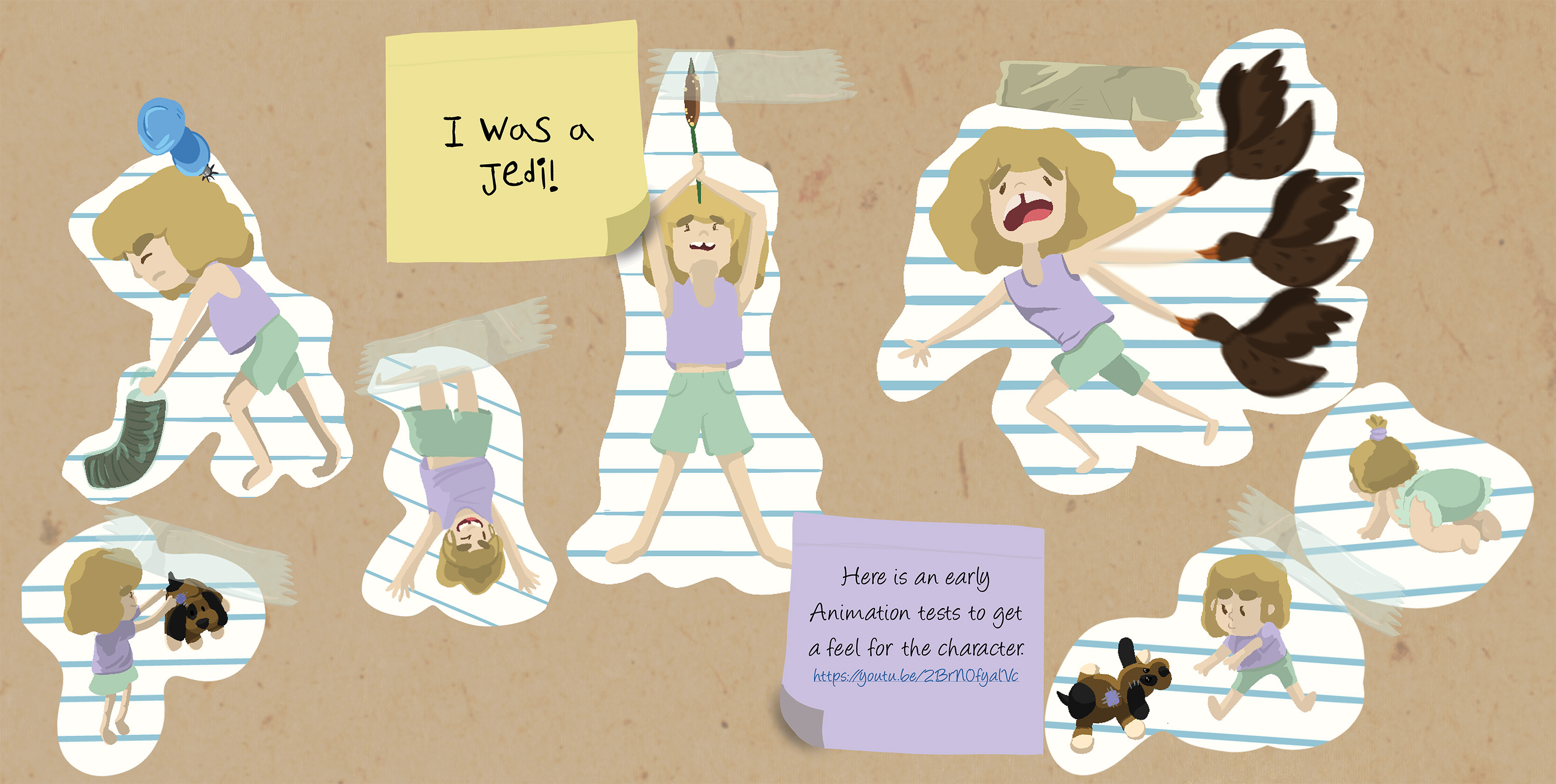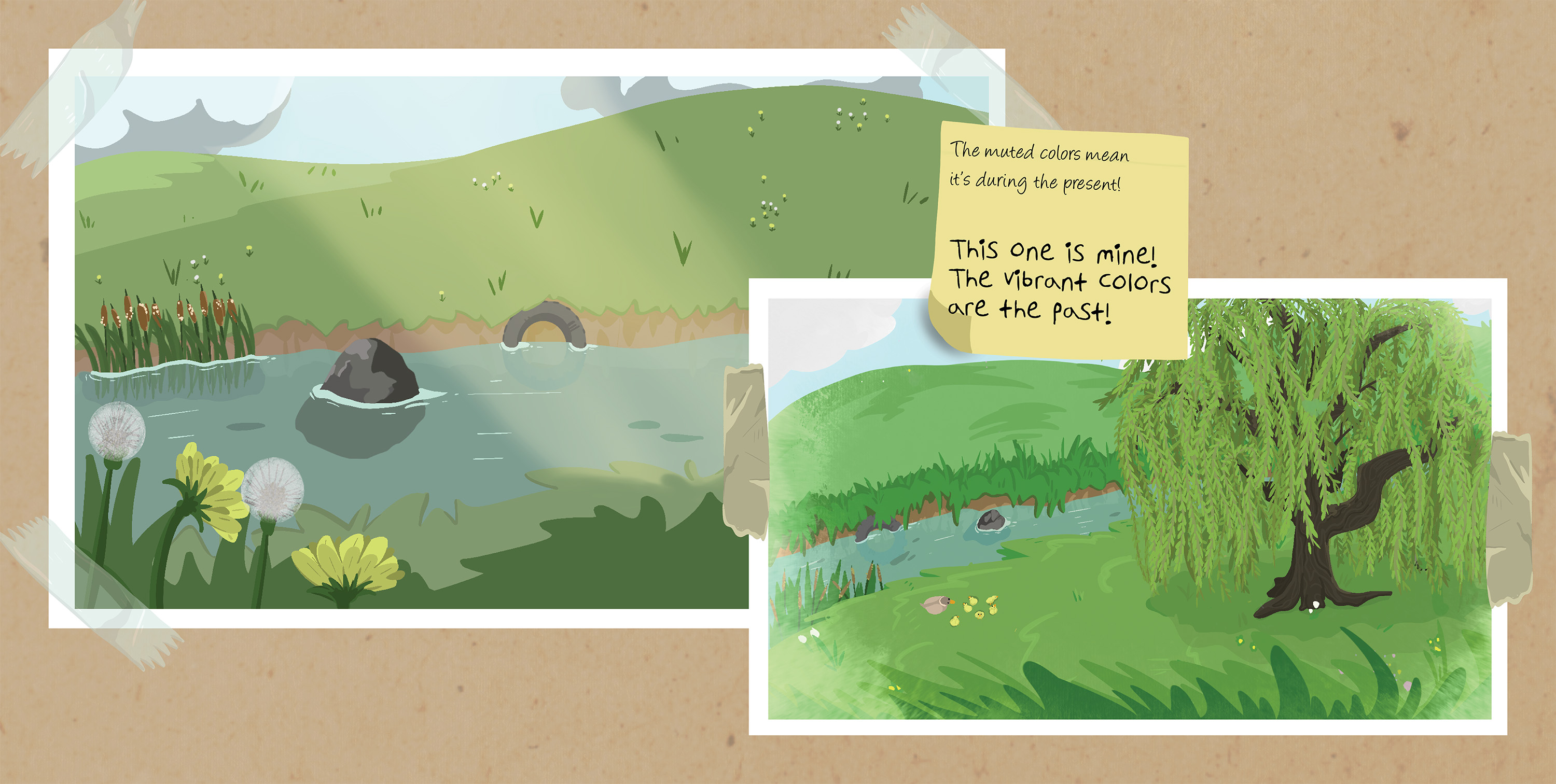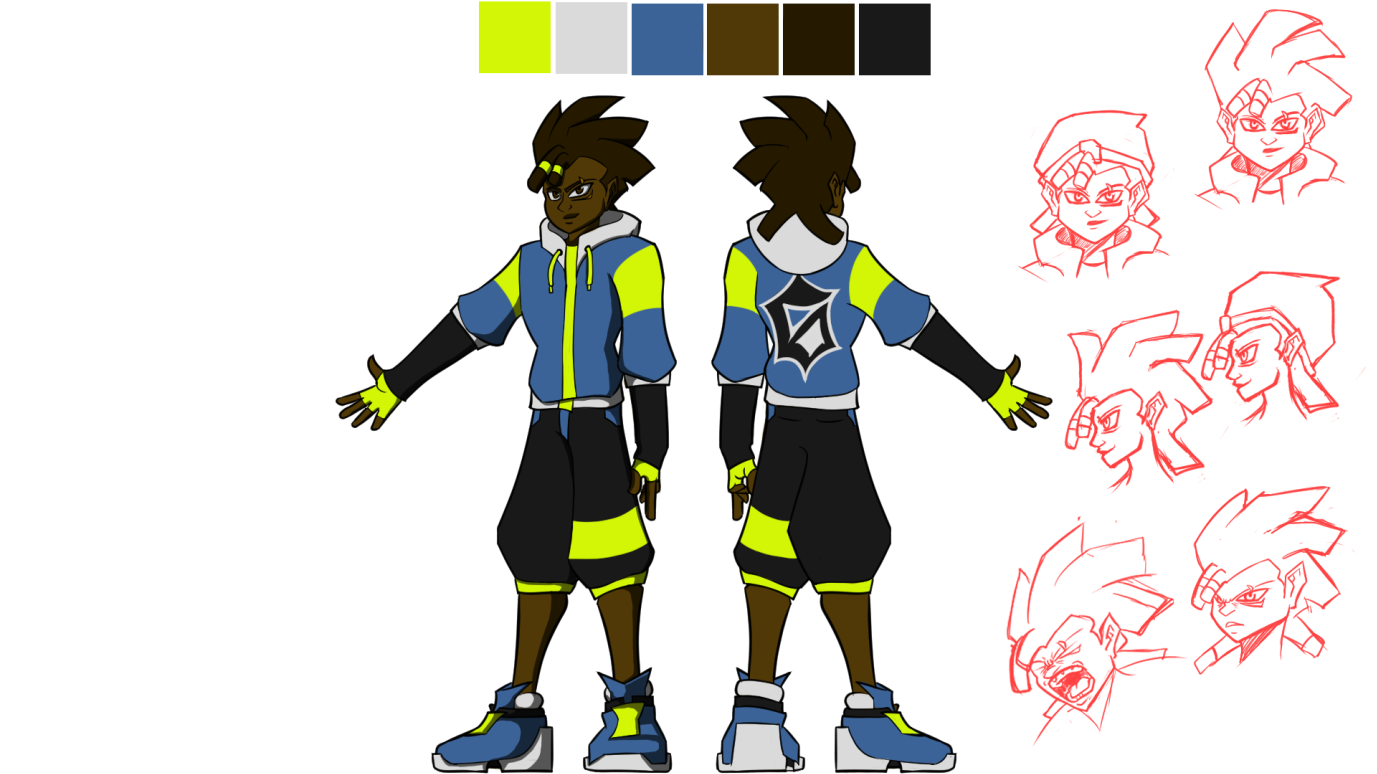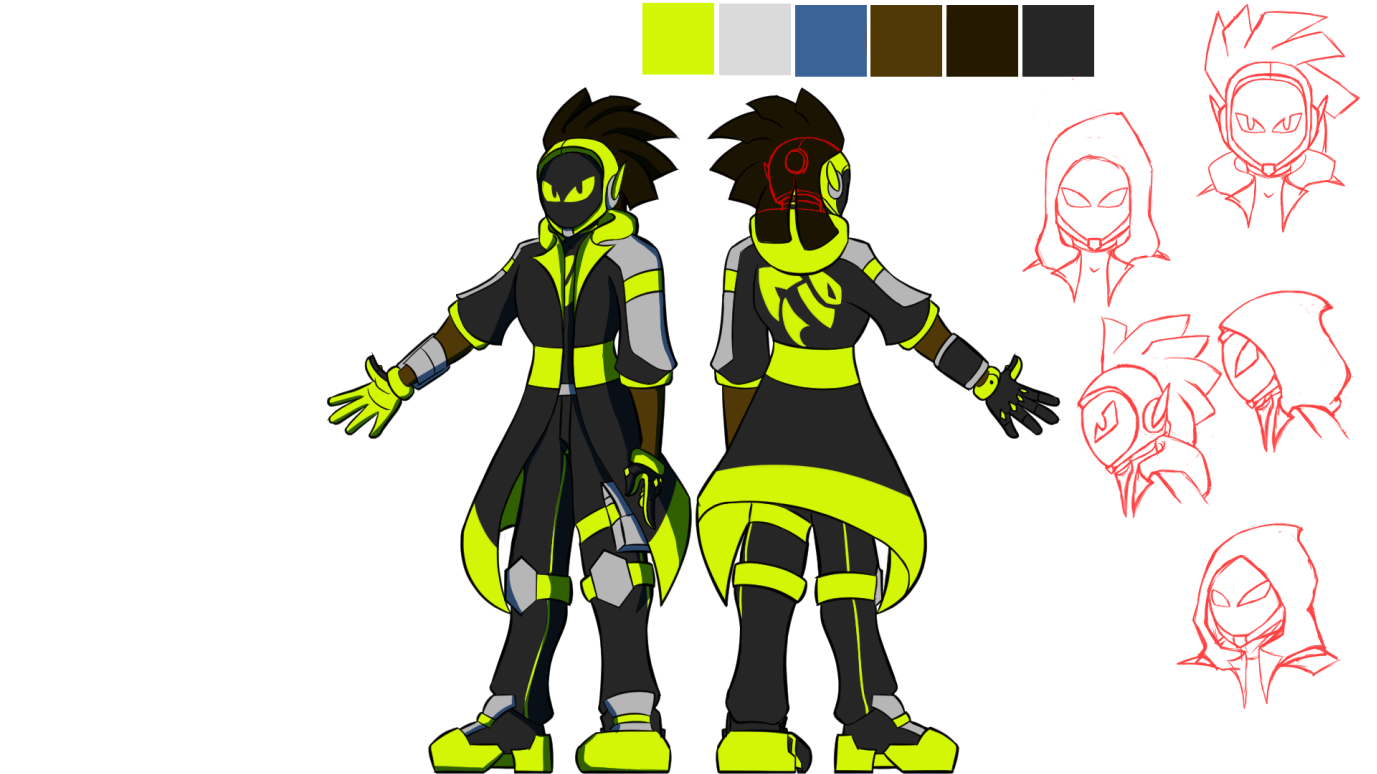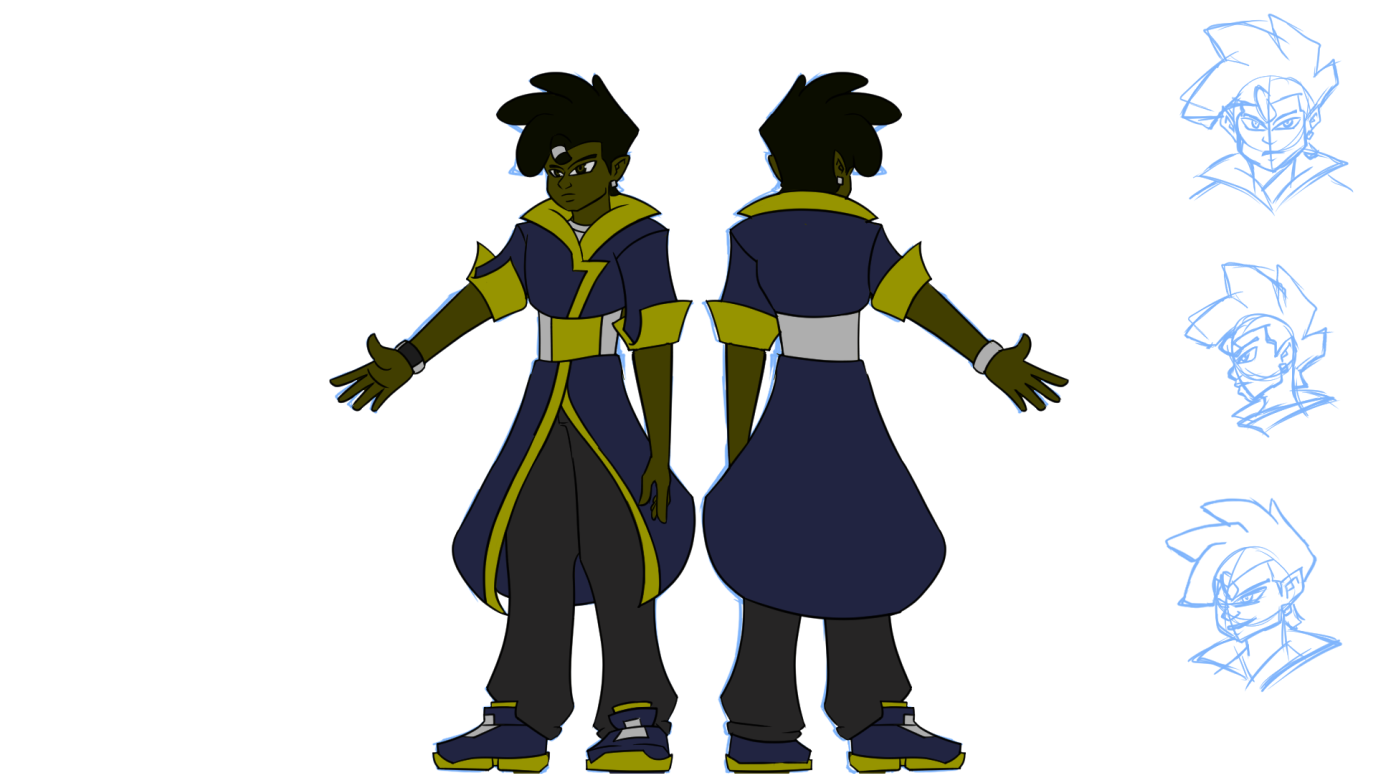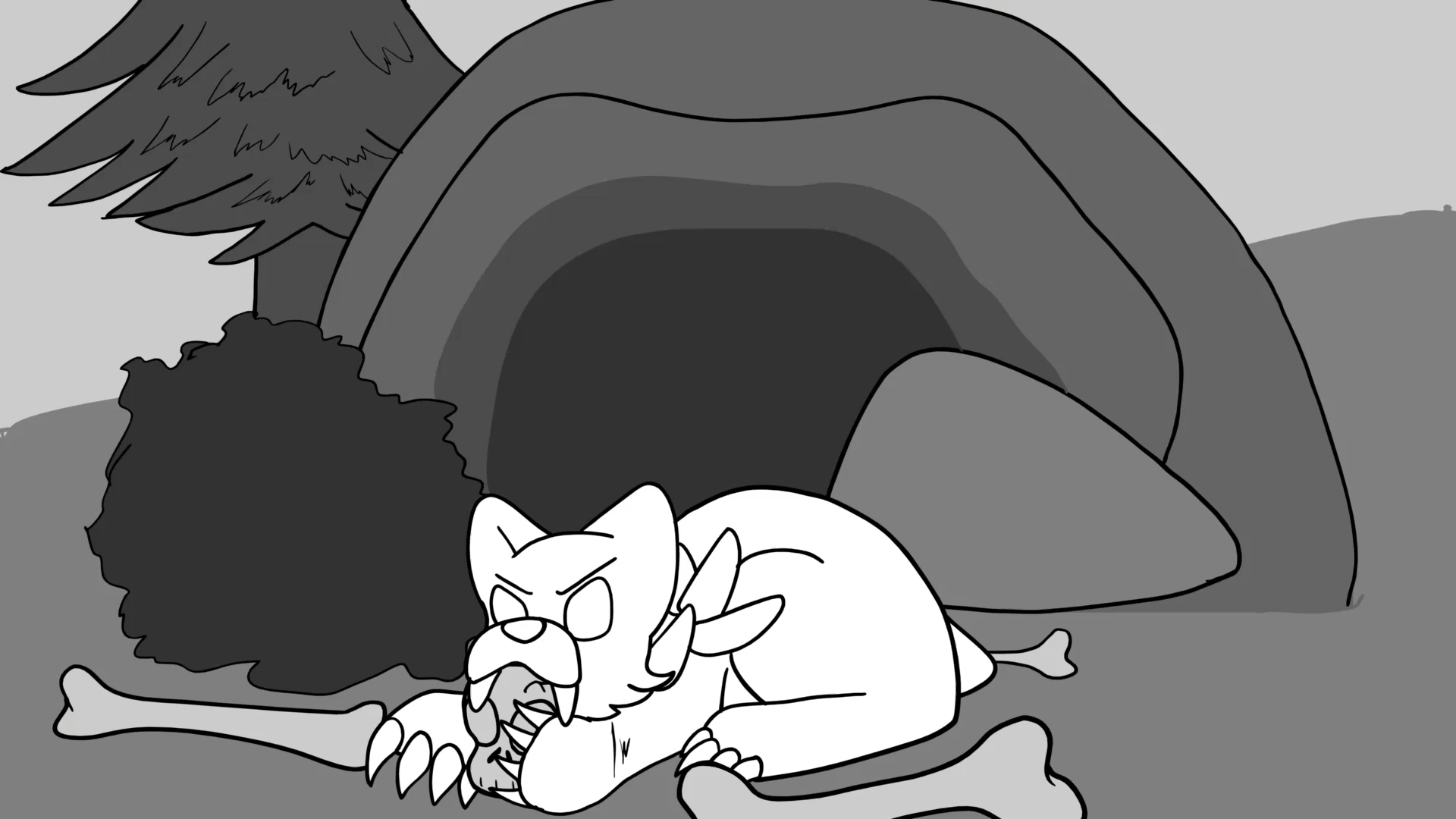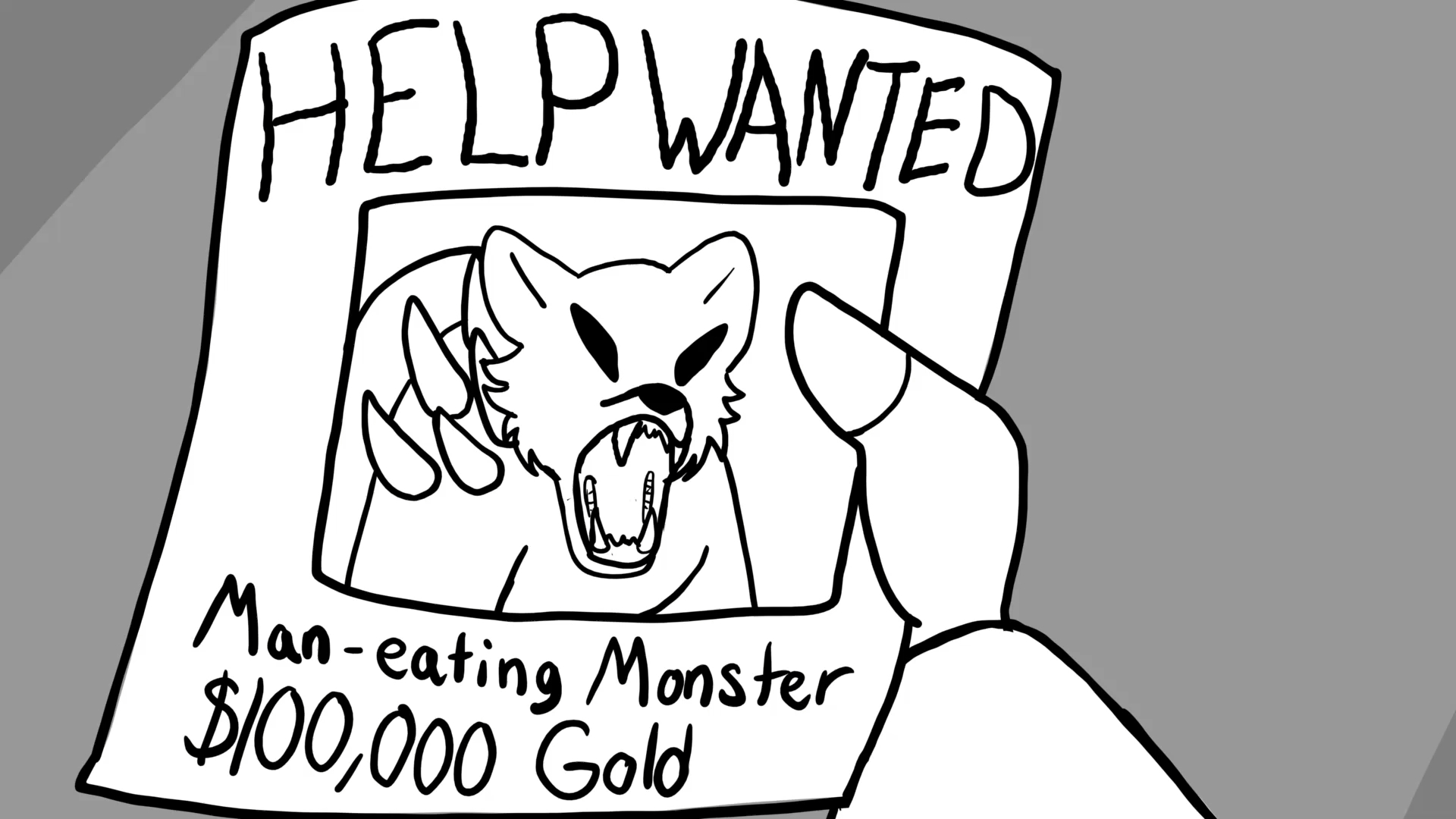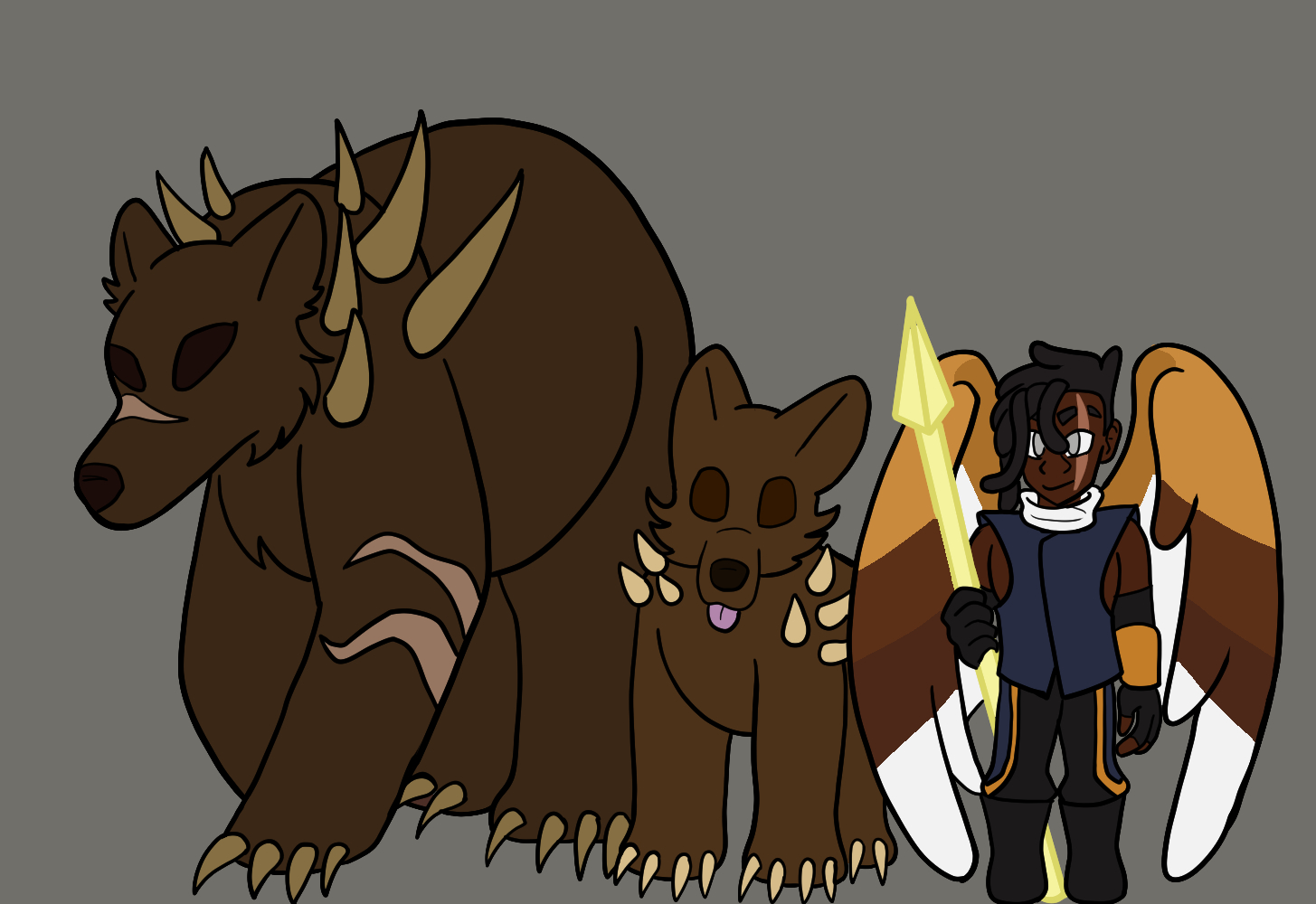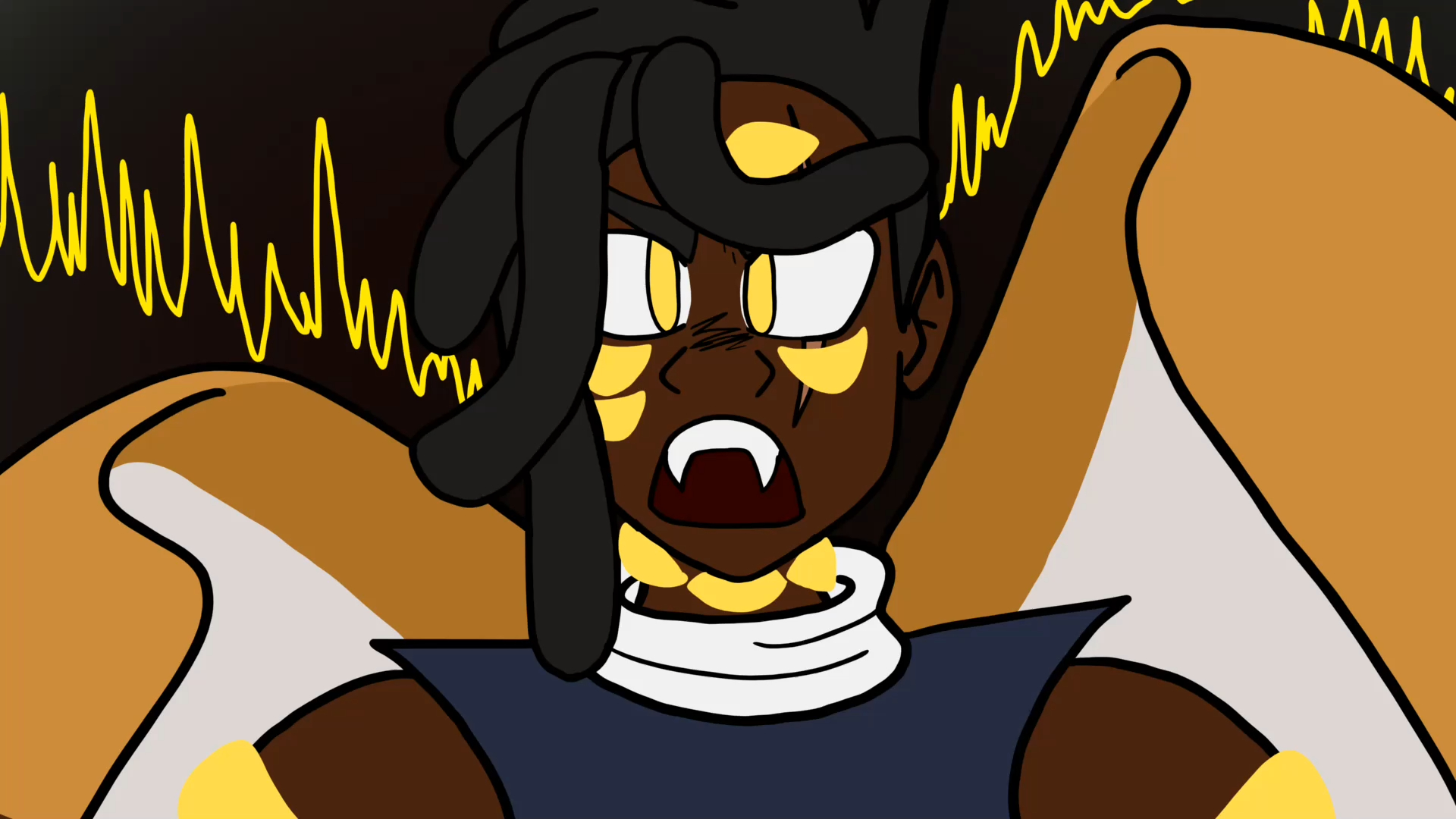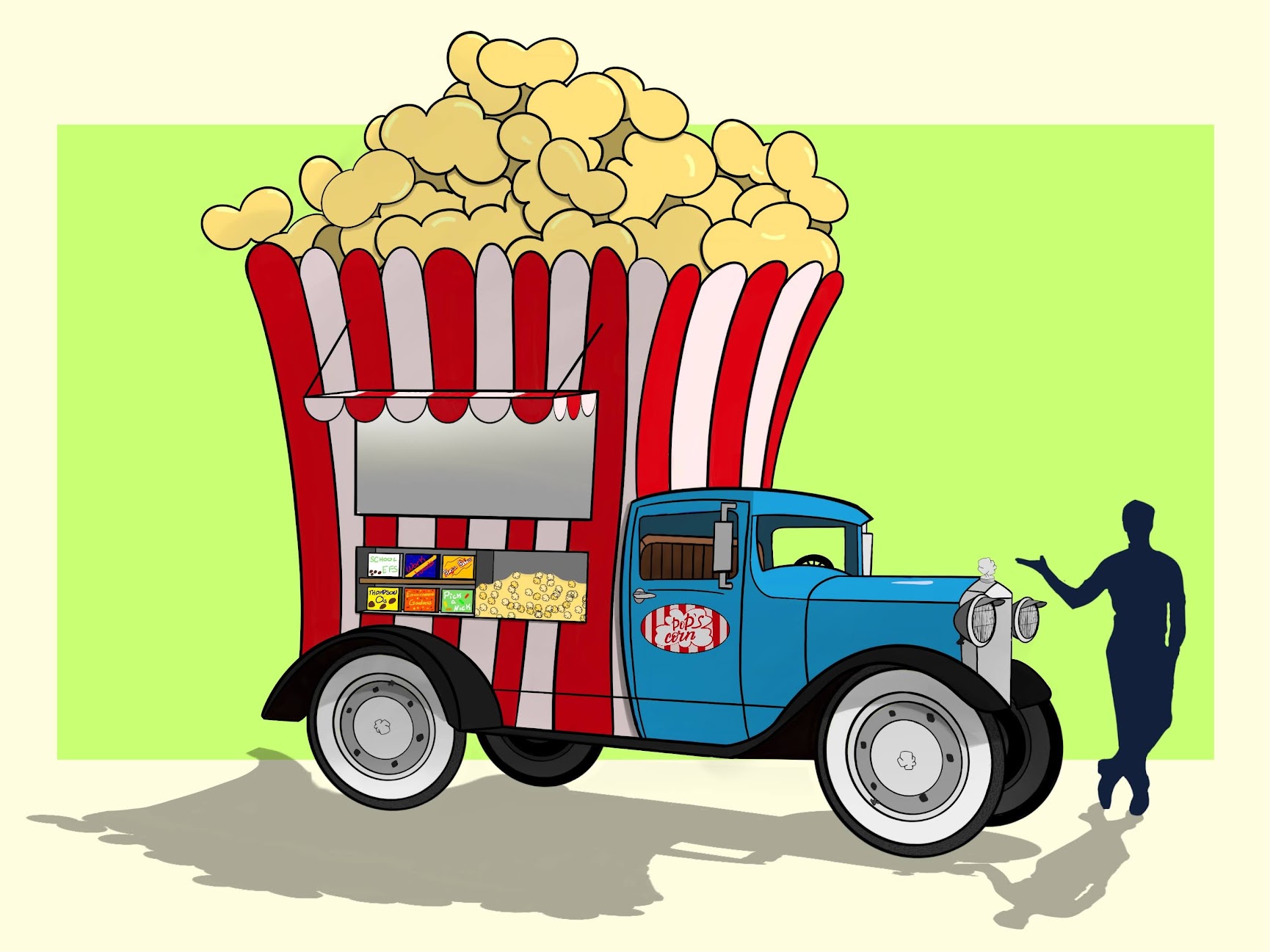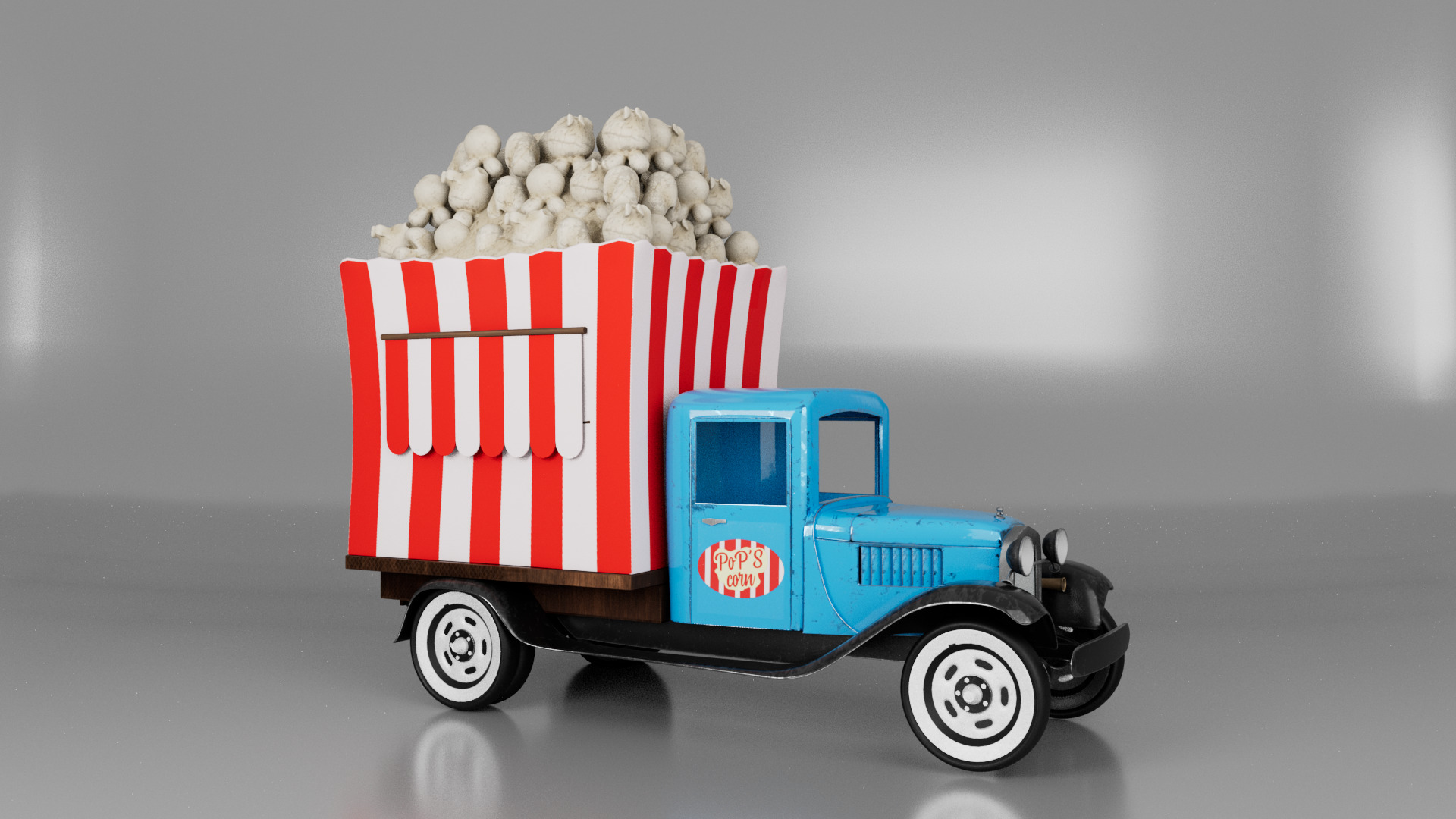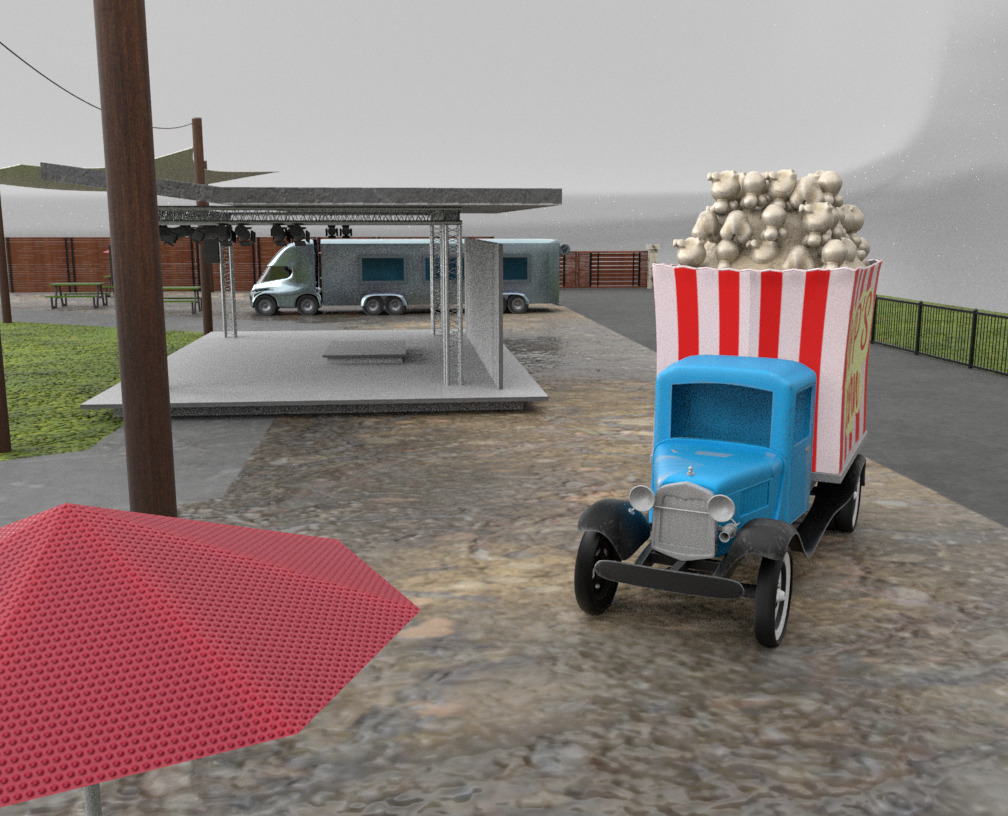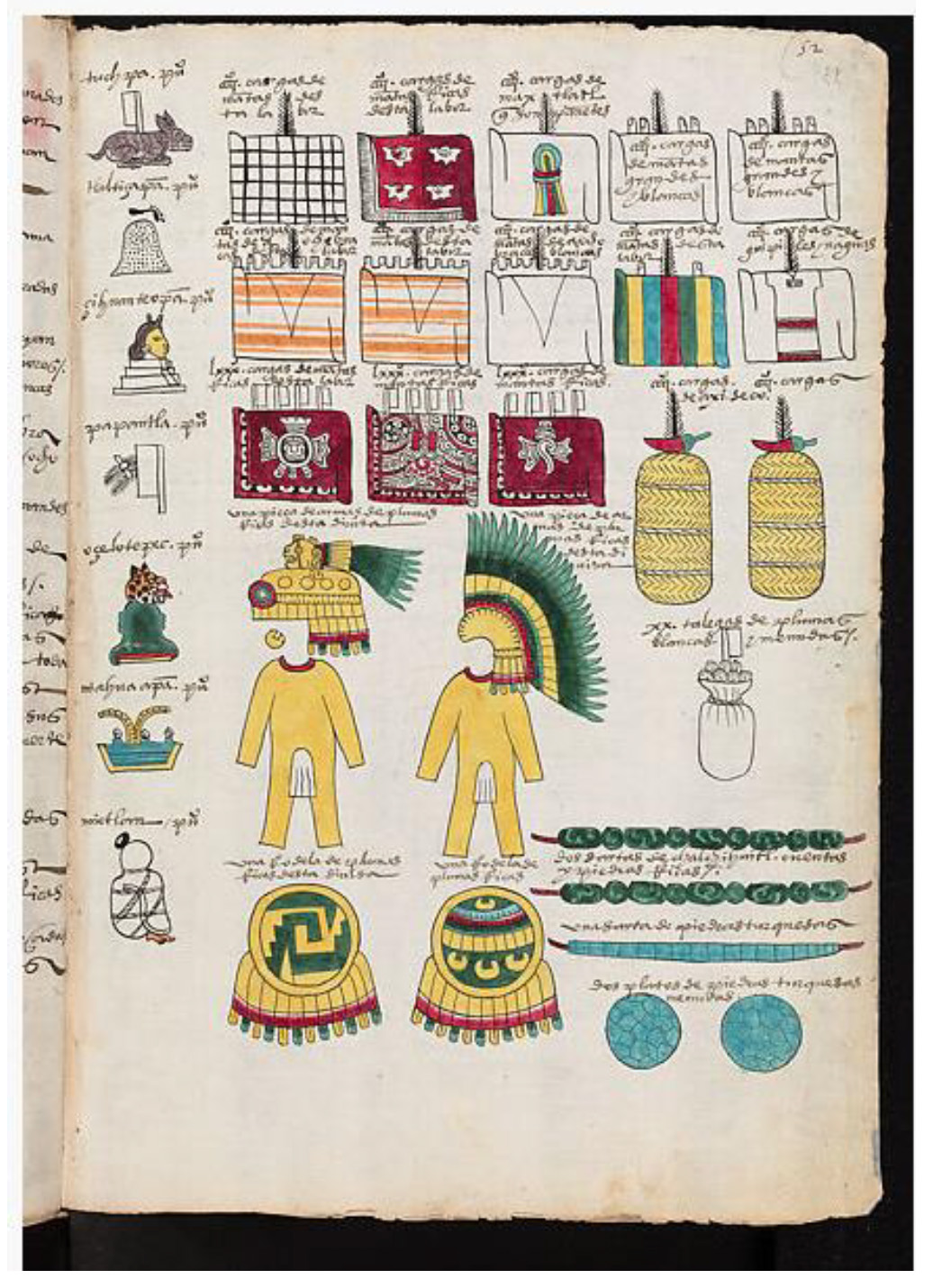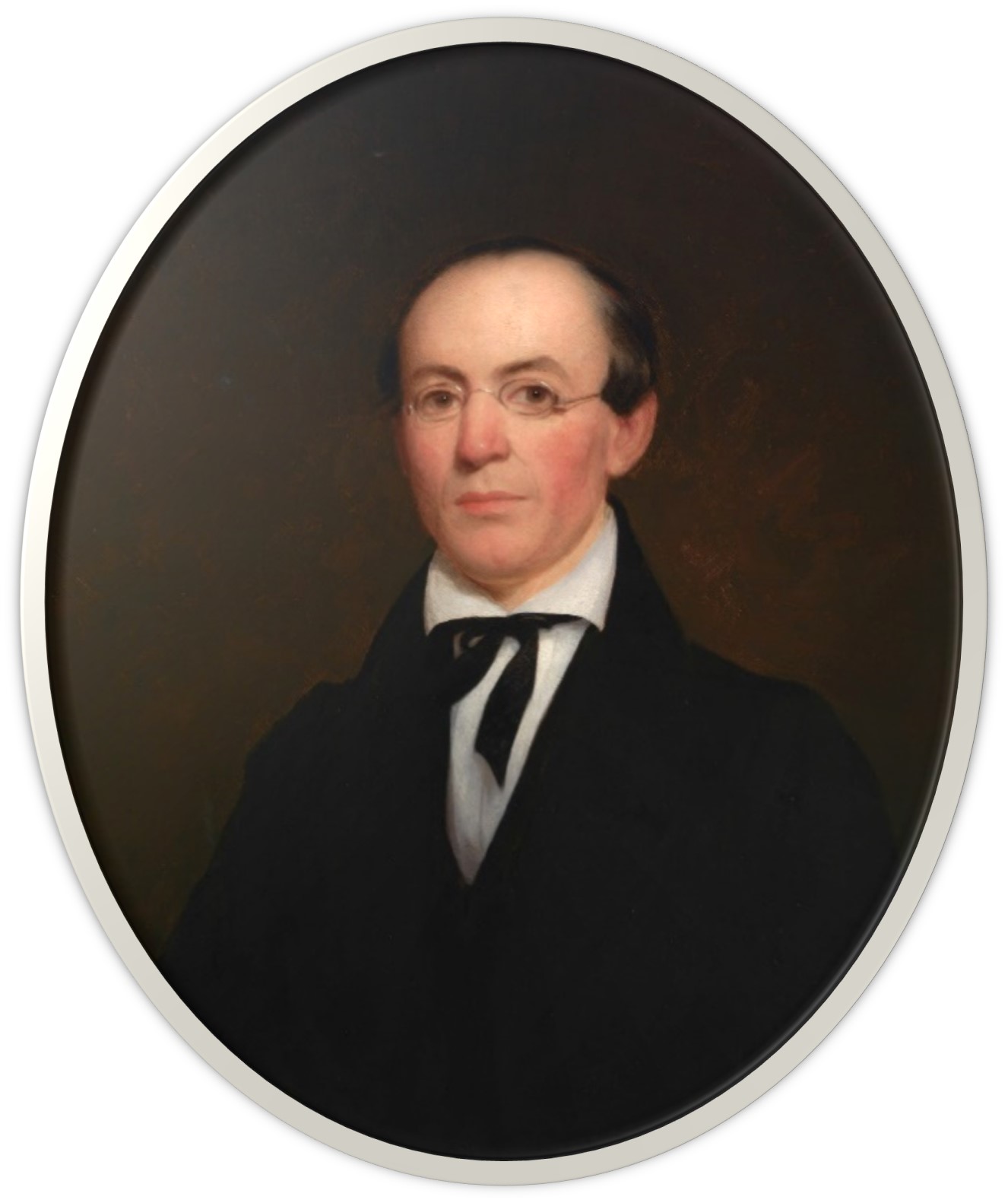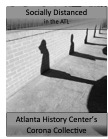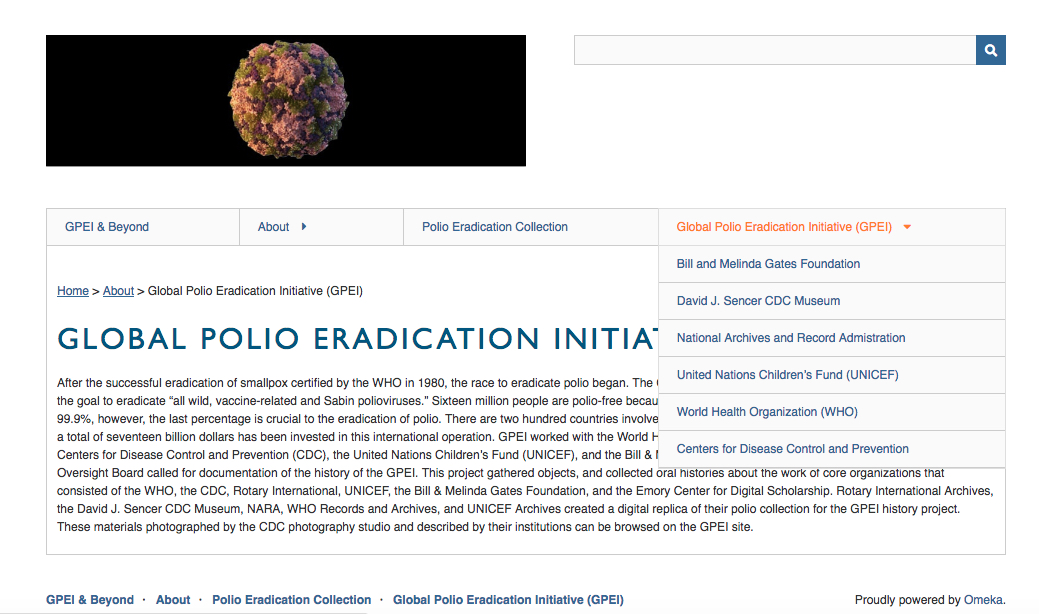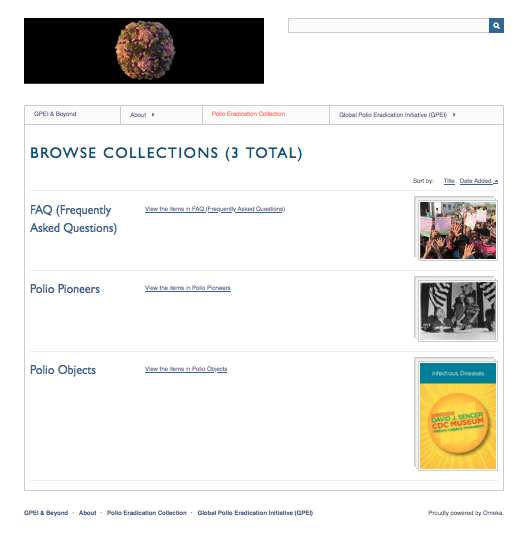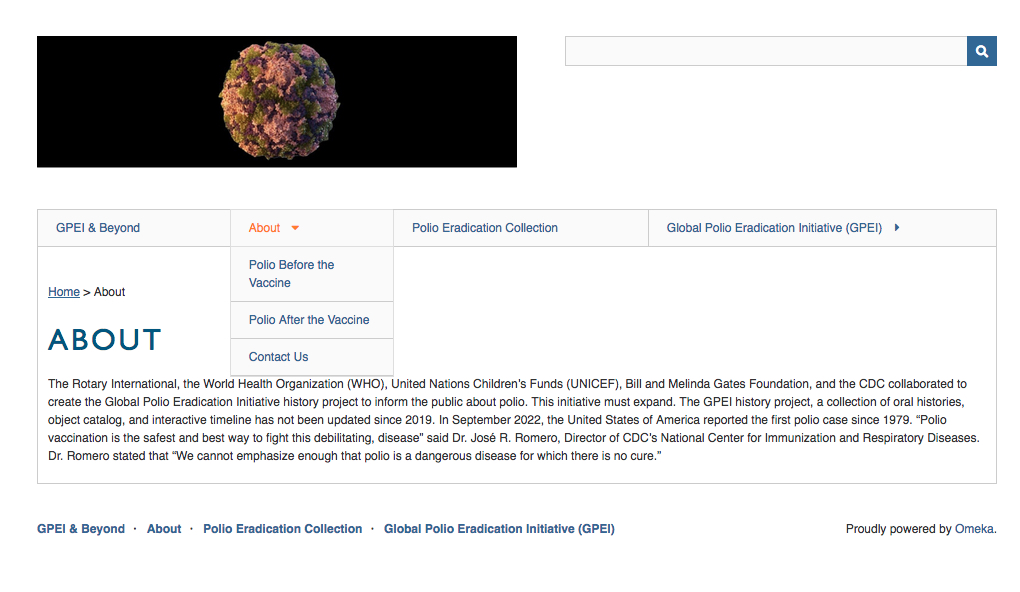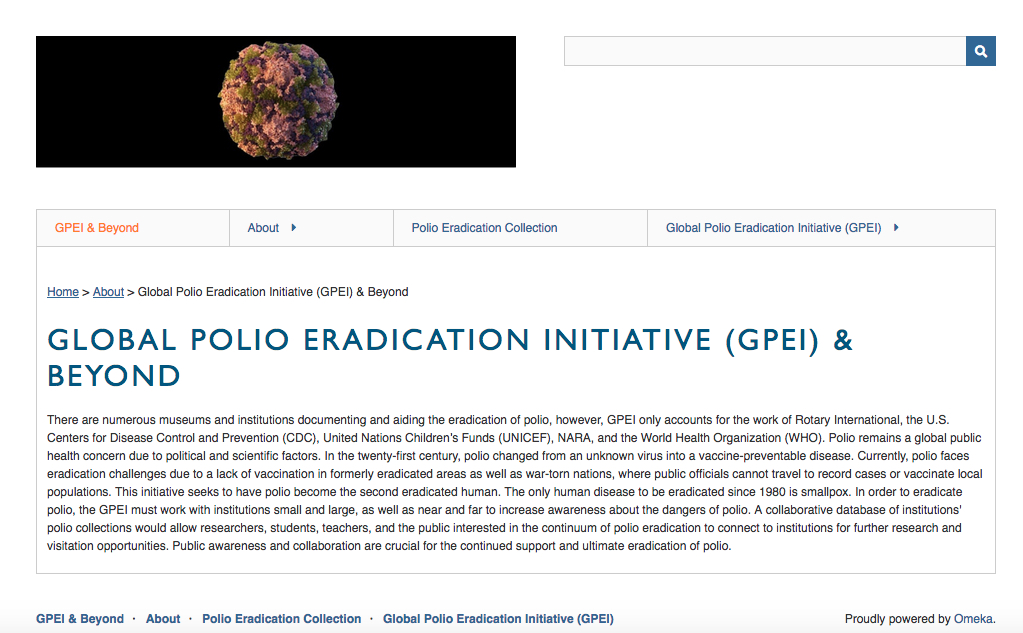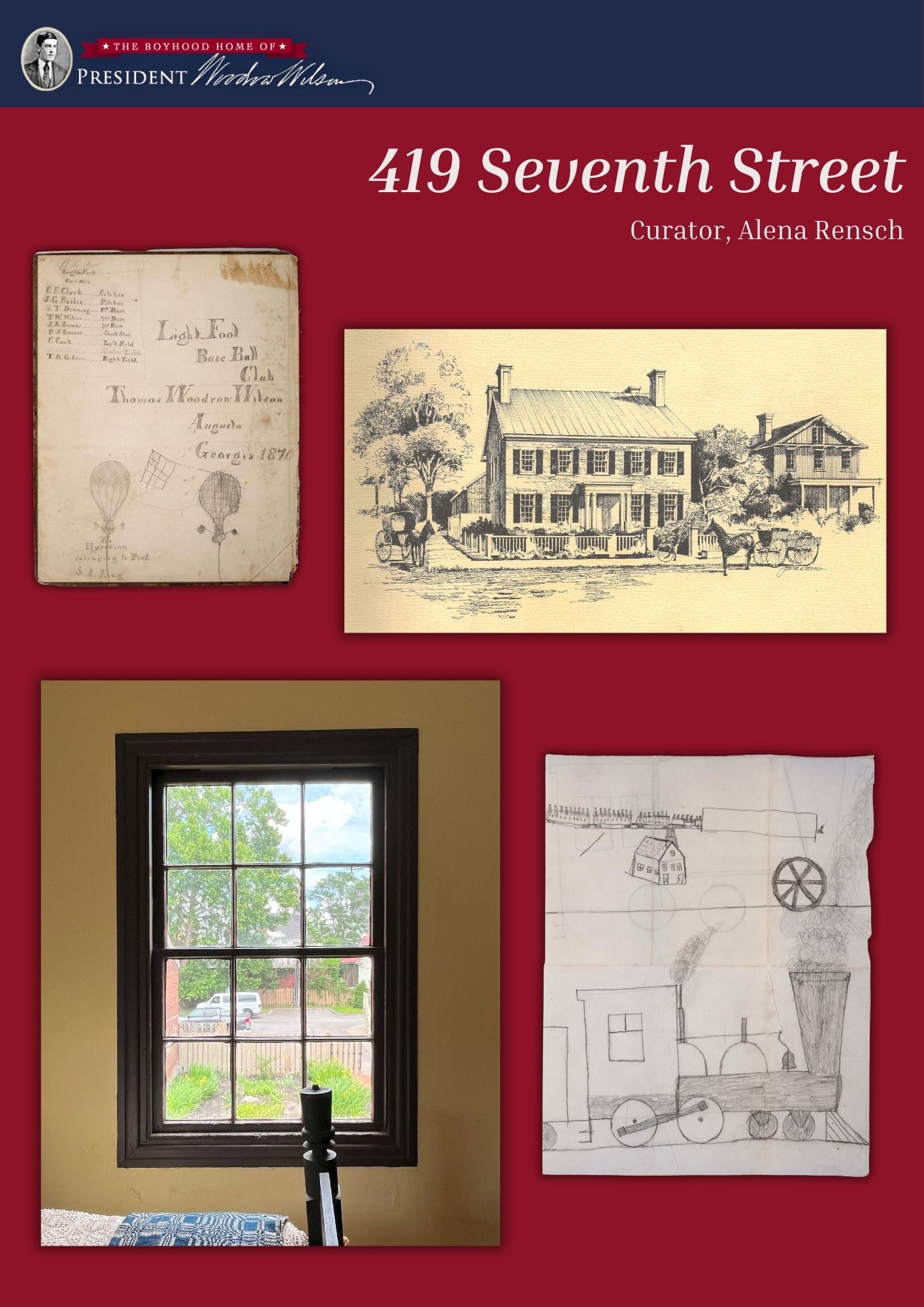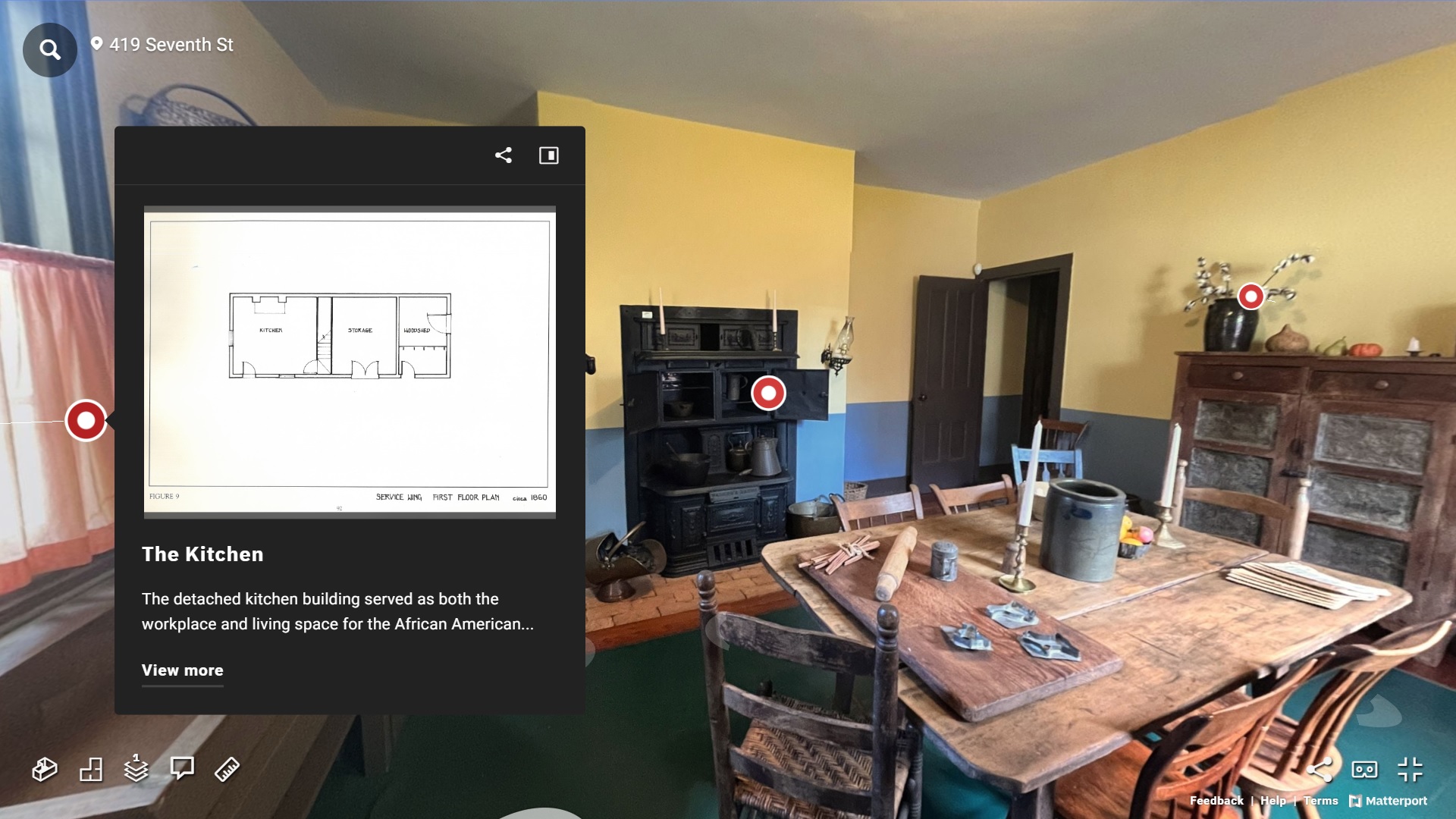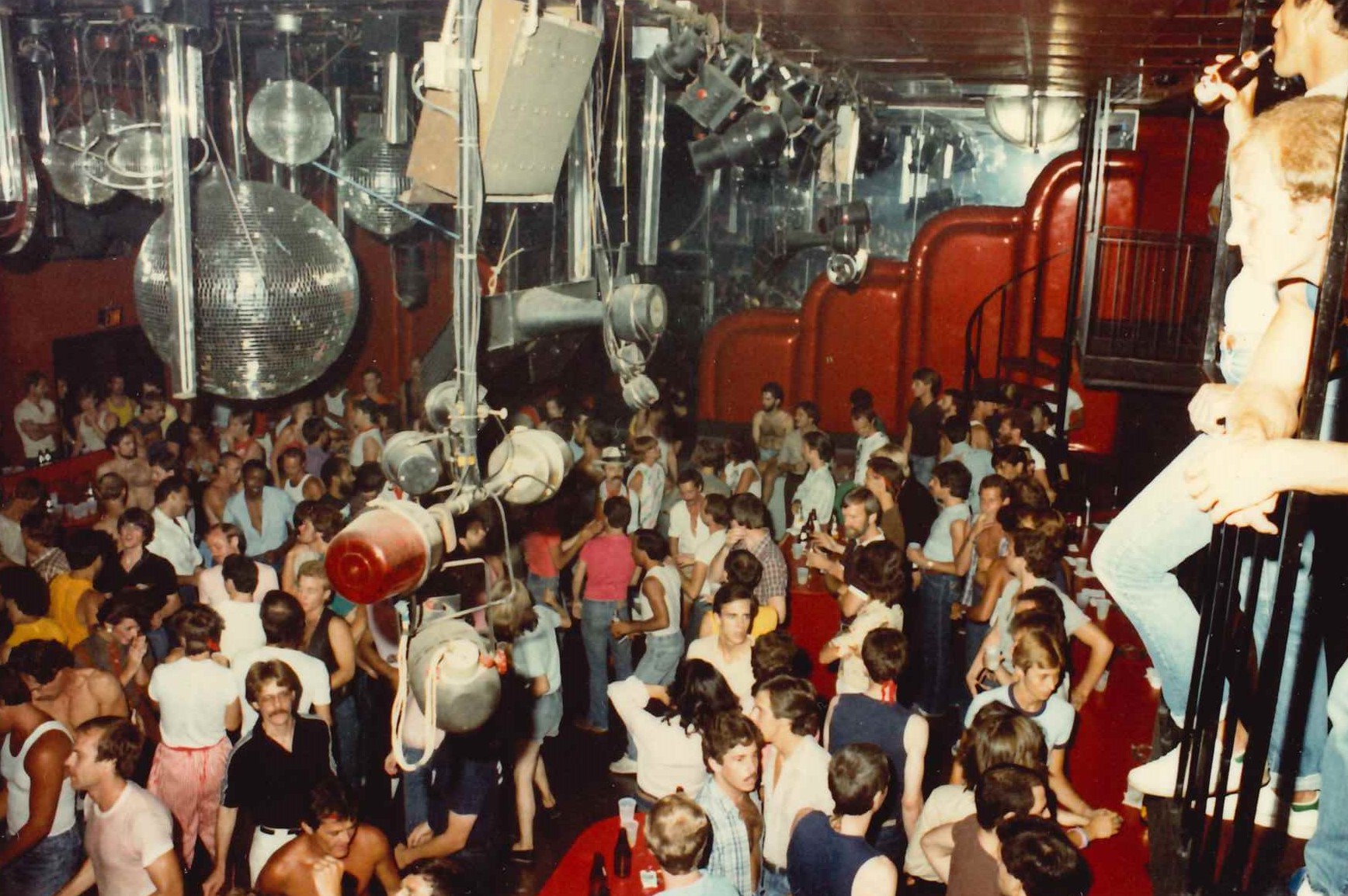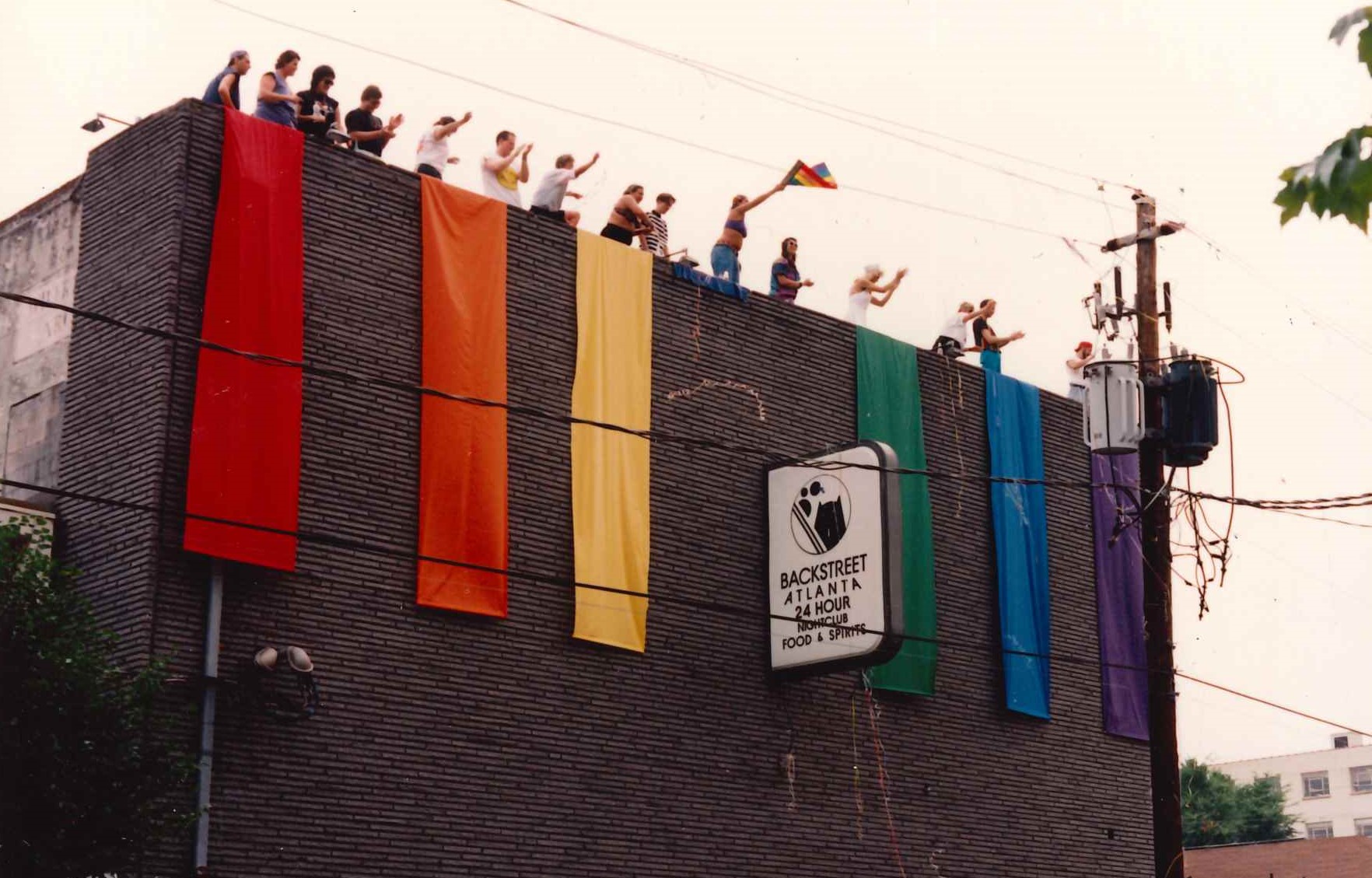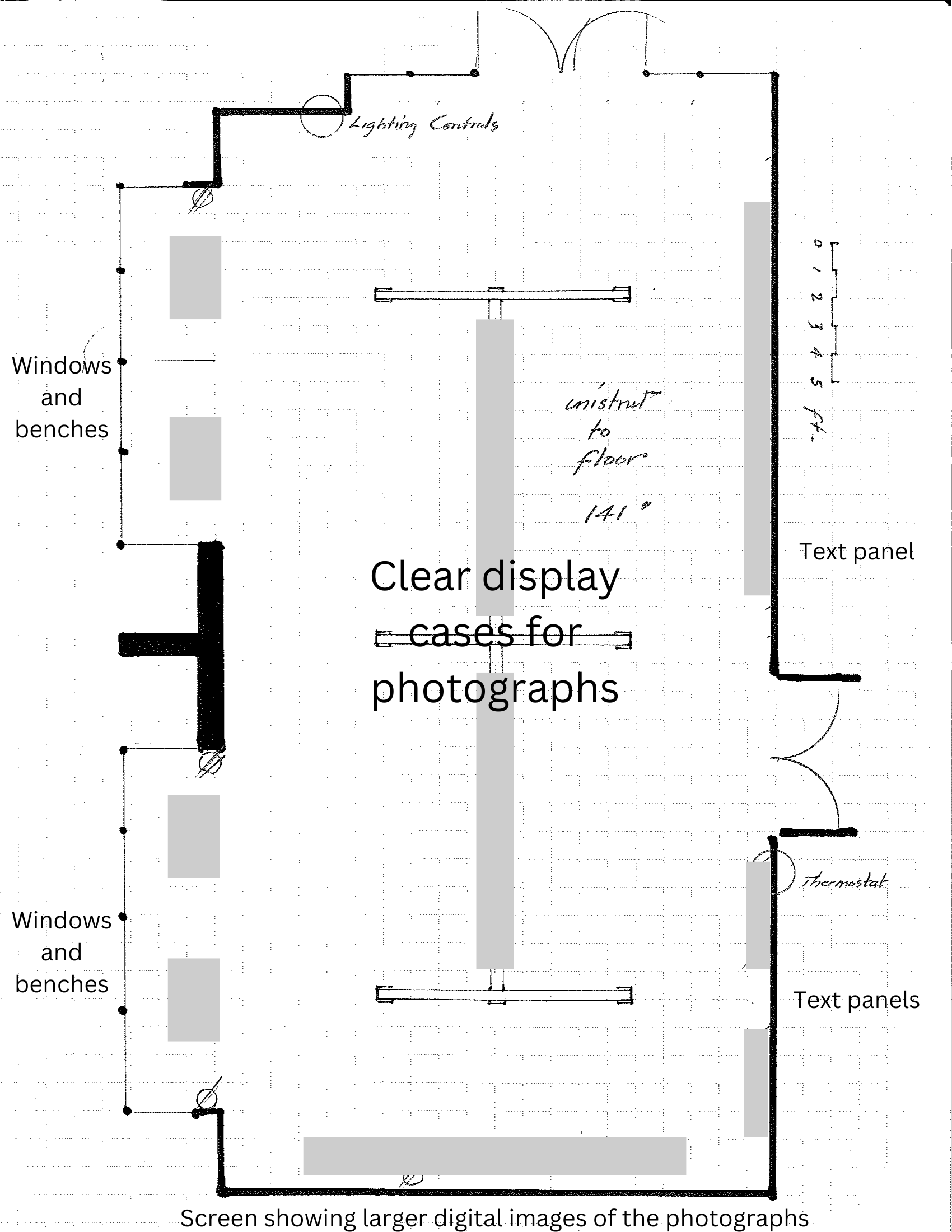
Capstone Exhibition Fall 2023 – Master of Arts in Art and Design
Art Education

Digital Animation

Museum Studies

Art Education
Fatema Ayala
A bee, a mother, and an artist may not have an inherent direct relationship. However, if we think metaphorically, we can draw connections between these concepts. A bee, known for its industrious nature, could symbolize the hardworking and nurturing qualities of a mother. Similarly, an artist can embody creativity and expression, much like a bee's role in pollination, which contributes to the beauty and growth of nature. Ultimately, the connection lies in the qualities and symbolism we attribute to each of these entities rather than a literal relationship.
This project explores the connections I have made with my own identity through the symbolism and metaphor of bees and nature. I started this project wanting to get to know myself and see if completing this graduate program and focusing more on my own personality would have any effect on my role as a mother, artist, and teacher.
Throughout this booklet, you will be taken on the journey and reflection of each and every painting in the series. I intend to take you on the journey that I have been on over the past year. Each chapter desribes the thoughts and analysises of each moment building up to my final show. The end result is an exhibition of eighteen paintings and whole new outlook on myself.
- Instagram: @airyonna.ayala
Please see my website for the complete collection of paintings for this capstone project.
Antwi Boasiako
This project intends to develop a comprehensive sculpture curriculum for High school learners and serve as a reference guide for sculpture teachers. Specifically, it is designed to for the study of advanced sculpture, in the state of Georgia high school education. Sculpture education does not only foster creativity but makes the student a complete human being, here I mean the student educates his/her three H. The Head(mind), the Hand, and the Heart. Students educate their Heads by exploring and figuring out how to get a project done. They develop problem-solving techniques from that for personal development in the future. They educate their Hands using tools and materials to acquire skills and create sculptures. They educate their heart by appreciating the work they do. A student must have a complete experience of three-dimensional forms: the tactile quality, the special expanse of volume and form; the visual experience combined with the tactile; the effect of light on forms. Nature presents three-dimensionality to the students, buildings, trees, cars, furniture, appliances, etc. All these elements of threedimensional objects should be a wholly must for sculpture in the visual experiences of life. Sculpture, a three-dimensional art, gives life experience for the student’s future through direct formal exposure to nature.
Knowing that many kids' formal exposure to art forms ends at high school, and that these students who choose not to study sculpting after high school are deprived of this experience, is quite concerning.
- Instagram: @antwicreations
- Linkedin: Antwi Boasiako
My project centered on curriculum designing of advanced sculpture. So, the pictures uploaded here explains the processes in the various sculpture.
Emily Davis
The purpose of this project is to explore the benefits of origami as a teaching tool and examine the potential of YouTube as a platform for introducing origami instruction to teachers. Through academic research and studies, the project aims to increase awareness of origami's benefits, focusing on its educational, physical, and mental health advantages. The culmination of this project is the creation of the Doorigami YouTube channel, a channel dedicated to empowering teachers to incorporate origami into their classrooms and promote its use as a tool for fostering creativity, problem-solving, and artistic expression. By sharing the findings and establishing this instructional channel, more teachers will be able to incorporate origami into their teaching practices, implement best instructional strategies, and ultimately enhance learning outcomes.
- Instagram: @emilydteachme
- Twitter: @emilydteachme
Taelor Dorsey
The lack of diversity in the world has always had a negative effect on people of color, who are not able to see themselves represented as world leaders, superheroes, or even princesses, until very recent years. While the evolvement of social media and the introduction of more characters of color in TV and film has improved diversity in media regarding race and ethnicity, the representation of a diverse family is still not adequate enough. Students are not seeing their loved ones represented in tv, film, or literature, while simultaneously, other students are not becoming sensitive and aware to different types of families that exist. By targeting educational resources, the promotion of diversity can begin at a younger age and create more inclusive classrooms hence a more inclusive and sensitive society. While as a society we are aware that different types of families exist and thrive, students deserve to see themselves more in media and feel like they, too, have stories that deserve to be told.
Tracy Geter
One of the most common developmental disabilities in children today is ASD or autism spectrum disorder. Autism is defined as a developmental disorder characterized by difficulty in social interaction and communication and by restricted or repetitive patterns of thought and behavior. As the number of students diagnosed with autism spectrum disorder in the general education classroom has increased throughout the years, teachers have been tasked to meet the needs and behaviors of these students. These needs can be wide in range, but the most common needs (self-expression, sensory, and social interactions) can be met through the art education curriculum in the art classroom. The current curriculum does not allow the flexibility that art teachers need to create an environment where students can make their own choices when creating an artwork, such as choice of color, medium, tool, etc. This rigidness and lack of choice can cause students who are on the spectrum to become disengaged or even disruptive. By implementing an inclusive art education curriculum, teachers will see an increase in student engagement, self-expression, and sensory needs. Teachers need to be equipped with as many tools as possible when teaching diverse learners. My research and curriculum will be another tool in their toolbox to help acknowledge the diverse art education classroom of today.
Sabrina Groshek
Perfectionism can have a negative effect on the identity of an artist. The goal for my project was to experience how using an abstract art journal could help overcome perfectionism in art. As an art teacher, I have not been active in creating personal art. I wanted to re-engage in creating art by using small abstract pieces in a journal to shift my perspective from self-perceived dissatisfaction to positive self-awareness. Although perfectionism can have positive effects on an artist, my perception is that perfectionism has had a negative effect on me as an artist. I created several small abstract pieces each week with a brief annotation and stored them in a journal. At the end of the project, I reflected on the evolution of the 60 completed pieces. The result is a style that helped me express myself as an artist while learning to be more focused on the process instead of the outcome of a completed piece. The use of abstract art can be used as a springboard in the art classroom to help students create pieces of art that help shift the mindset of making mistakes.
David Jacobs
This proposal is intended to create a set of lesson plans for an elementary art classroom to use for 5th grade students that will integrate the use of language arts skills inside of art production lessons. The goal is to develop literacy in the art classroom in order to facilitate writing and comprehension skill growth by demonstrating its benefits in non-language arts application.
The use of literacy skills like description, explanation, and expression can be used to clarify artistic images and goals through the use of artist statements, writing as image, and narrative. Language arts skills provide a clear value in assessments, but art production can support their value as a creative outlet equally well- when a student finds that their literacy skills are useful in other situations, they can prioritize developing those skills, and the openended outcomes of the art environment can provide a safe, free space to experiment with literacy skills integration.
This collection of lessons will be a complete set of preparations, instructions, introduction PowerPoints, in-process examples, final products, and assessment tools/evaluation forms for an instructor to use in the classroom to develop student literacy in the art room.
Keywords: Language Arts in Art, Reading Integration, Literacy in Art, Creative Writing
Rebecca Layson
Body neutrality is simply appreciating and accepting one’s body for what it can do and how it looks, even if it is not where one would like it to be. Body neutrality is a middle of the road approach, right in between body positivity and body negativity. Falling into a negative mindset is not a productive way of coping with any perceived shortcomings involving one's body or outward appearance. Those who get caught in an overly negative body mindset are at risk of multiple issues related to body image and self-esteem including depression, anxiety, eating disorders, and self-harm. Adopting a body neutral mindset has been helpful for me personally; allowing space to appreciate what my body does for me and what it may become capable of doing as I work towards healing from past body image issues, disordered eating, self-hate, and self-neglect.
This body of work is a reflective exploration of my past relationship with my body and the positive effects that I have experienced since adopting a body neutral mindset. My body of work incorporates a variety of mediums to help share my narrative including video, photography, sculpture, ready-mades, and performance art.
- Instagram: @positively.neutral
- Instagram: @bexpottery
Megan Lisenby
Each subject, club, organization, and sport is celebrated at Lee County High School with the exception of Visual Art. This project is the documentation of the process to create, design, and present Lee County High School’s first ever Art Show that will showcase a selection of work from each student in Visual Arts Classes. It will provide a timeline, outline of paperwork, budget, spending, displaying, and decorating as well as a review of why the event is important to the school, students and community. An opportunity to display and celebrate work would showcase what students learn in art class and how they progress throughout the school year. Students are of the utmost importance. They should be celebrated and recognized for all of their hard work that has been done throughout the year in Visual Art class. Furthermore, a documentation and review of the show will provide a framework for others to follow as well as feedback for improvements for years to come.
Ruth Mizzell
Since becoming an art teacher, I have found myself practicing my creativity through the act of creating art less and less with each passing year. The only art I ever seemed to create was work samples for lessons, I had begun to lose sight of who I was as an Artist myself, and only focus on the Art Teacher side of me. Through the studio classes in this program, the daily practice of creating artwork, and the use of handmade journals, I sought to reestablish the connection to my own artist identity and begin to once again truly know what it is to practice my creativity. I also began creating work that would in the process reflect my identity as an artist, which was to be a product and reflection of my journey of reconnecting to my creativity. The topic of this project and the resulting paper is the reflective exploration of rediscovering my creativity and identity as an artist, and not just as an art teacher. This was done through daily art creation, using journals, sketchbooks, and reflection as data. At the completion of my project, I found that the only way for me to keep my connection to creativity is to nurture through the act of self care and journaling, and taking an active role in my own creative process and journey.
- Instagram: @mrs_mizz
- Instagram: @bullard.art
- Twitter: @bullard_art
Joshua Smith
Currently, the field of ceramics is inundated with messages of a lack of representation for groups other than white men. The present comparative media analysis will focus on the ceramic arts publication Ceramics Monthly in 1953 and 1973 and its representation of female ceramic artists in the following categories: Editorships, solo shows, articles by and about women, and professional presentations by female ceramic artists. This data will be used to evaluate the number of instances of representation of women in these two sample years and to answer the question of representation through comparative content analysis. Sources include research on representation rates in STEM and visual arts academia compared to representation rates in Ceramics Monthly during the same period.
Keywords: Ceramics, women, representation, Ceramics Monthly
Lisa Sponsel
I find myself in a constant state of improvement. I always want to do better and be better. As I reflect upon where I am currently, where I would like to be, and where I am headed in my career as a mother, an educator, an artist, and a student, I am constantly trying to progress. I can see where I am lacking and need to make growth as well as where I am finding successes and can identify how I might apply those traits to other areas. This project was completed in hopes of evaluating the vulnerability of digging into who I am as an artist and how being a single mother, teacher, and student effect my personal artwork. I created artworks along with a journal to document the exploration of who I am today, as an artist who is also a mother, teacher, and student.
Ashlyn Spurr
I have drawn a series of four self-portraits that each express a different emotion. Sadness, frustration, happiness, and overwhelmed, are the four emotions that I picked because they are the four that I have been feeling the most often. I captured the moment in which I was feeling these emotions by taking a picture of myself with my phone and then I turned them into drawings using graphite and white charcoal on toned tan paper. This process has allowed me to confront not only my emotions and how I am feeling in order to work through them, but it has allowed me to face my own body image issues and self-esteem issues. This was even more empowering when I put my artwork on display in a gallery setting for others to see. This process has also allowed me to become a better teacher to my students and I feel more empowered to teach deeper lessons and give my students an opportunity to talk about their own emotions in their art.
Christine Thompson
Student engagement in learning is a hot topic in education and important to all education stakeholders. Teachers create curriculum with the goal to increase learning which happens when students' desire to interact with the content. Creating an equitable curriculum that mirrors the diversity of the student body - seeing themselves in the artists and works being shown - would, logically, create an interest to interact with the curriculum. The art education of the pre-service art educator is often focused on the Western, European, white male dominated art. Changing the art curriculum to incorporate more diversity so that students can see themselves reflected in the artists and artworks being shared in the educational experience would enhance the level of engagement of students with the content and result in greater engagement in the learning and creating process.
Anna Traykova
The expert can rarely or only with difficulty relate to the novice when they have forgotten what it is like to be a novice. This is the curse of the expert when they try to teach their art or craft. This project is a self-examination through autoethnography of the experience of being an adult beginner-level art student in a pottery class. It can be viewed as a case study that utilizes an a/r/tographic approach. The author analyzes journal entries and memories reflecting on her 18 hours of experience in a six-week evening beginner pottery class and presents the findings as an illustrated short-story styled as a diary, conveying her experience and insights with the aim to inform her own art teaching practice as well as that of other art educators and researchers. The author reflects on her experiences as a learner, artist, individual, and future art educator. The illustrated story is simultaneously an artifact, creative product, research findings document, and a tool for (self-) reflection and deep learning. The ceramic body of work created in the process is displayed in some of the photos accompanying the text published at https://issuu.com/anna.traykova/docs/diary_of_an_adult_pottery_adventure_by_anna_trayko.
- LinkedIn: https://www.linkedin.com/in/atraykova/
Brianna Walker
Since the 1820s, crochet was widely used by women as a way to create decorative items all the way to wearables. Merriam-Webster defines crochet as “needlework done with a needle having a small hook at one end for drawing the thread or yarn through intertwined loops.” For close to 200 years crochet has been popular amongst women, which is why many consider crochet to be a craft that keeps women busy. There is a misperception that crochet will always be considered craft and never an art form. I plan to challenge that way of thinking by creating a large-scale art piece that features crochet. My goal is to create a full dinner party scene that helps show that crochet deserves a seat at the table of art. The pieces will trick the eye into looking like realistic food which will challenge the viewer to think about what they consider crochet to be. My goal is to show the piece off in a gallery setting alongside other forms of art.
- Instagram: @peaches.and.cream.creations
Judy Waters
This autoethnographical project studies the role that vulnerability plays in the self-expressive artmaking experience. The artist studied her own psychology as she created her first body of personally meaningful artwork. She aimed to observe what vulnerable feelings arose throughout the creation process as well as what lessons those feelings could teach her. Since self-expressive artwork was new to her, she experimented with the different teaching approaches used to encourage this type of work which include psychological safety, third-hand intervention, and scaffolding risk. In the end she learned to become comfortable with the uncomfortable by leaning into what vulnerability could teach her about her beliefs and practices as an artist. Through this project she also discovered her own passion to use her artwork to promote healing and reduce the stigma related to mental health. In the end she took the greatest risk by turning her artwork into an immersive art exhibit called The Unexpressed where patrons were able to view artwork while listening to musical storytelling accessible by QR code.
- Instagram: @judywatersart
- Tiktok: @juders03
Sara Williams
Social justice in art education is an essential component in contemporary pedagogy, art processes, and exhibitions. I want to explore how art educators can create a K-5 elementary art lesson that is academic, creative, and convincing of the validity of an art education at an early age. Art is not going to be the most favorite subject in school for all students, but I believe there can be a middle ground where students can connect, discuss, and create at some level instead of simply shutting down the idea of learning and connecting with one another in art class. It is the awareness of my own upbringing and privilege that I feel there is an injustice taking place that needs to be corrected for the sake of our future citizens. For these reasons, I developed an art lesson suitable for all students to create a collaborative art installation that is intended to transform the environment in their own school hallways.
Digital Animation
Jasaad Graves
"The Lower World” is my attempt at contextualizing themes revolving around the constant struggles associated with earning a living in the United States. Similar to the world that the series takes inspiration from, there is a constant strain to find the ideal work life balance. Bills serve as an ever-impeding reminder that we have finite resources at our disposal in this capitalist society and we must essentially sell our metaphorical souls, represented by our time and autonomy, to survive from pay period to pay period in this system. “The Lower World” takes these espoused themes surrounding work and capitalist survival and depicts them in an irreverence and facetiousness that can be digested by the masses. The characters’ respective existences serve as an analogous perspective into the way that we individually make ends meet, or perhaps thrive, within our occupational roles in such a capitalist driven society. In addition to the themes surrounding occupational culture, there also exists the thematic examination of how we interact with others in a workplace and personal setting, the characters will explore the everyday skills that we learn and maintain to protect our perceived professionalism and the subsequent internal conflict that persists between a person’s work self and personal self.
- Instagram: @Saad_Almighty
Kaylee Hammer
The only constant in life is that it changes. Recently, I have been adjusting to a new season where I have gotten the chance to slow down and heal some old injuries. This has allowed me to reflect on my childhood and the wonder that filled my soul. It has also been a time where I can reconnect with my inner child, lifting my spirits while facing the daunting life changes ahead. I didn’t know it then, but my time spent playing in and exploring the creek outside my grandmother’s house cultivated the curious, daring, and determined spirit I have today, but I went through many years where I struggled to connect to those attributes. I felt so disconnected from my most authentic self, and I feel that many people, young and old, experience this disconnect at some point in their lives. So with this in mind, I started creating a short story inspired by events I experienced at the creek growing up. Choosing this path for my project, allows me to continue growing while creating a piece others can relate and be inspired by.
At its core, Creekside Pl. is a tale of healing from depression, by reconnecting with one’s inner child and embracing nature. This brief 2.30-minute film beautifully captures the journey of a young woman as she rediscovers her inner child while immersed in a familiar setting. Throughout the narrative,heartwarming recollections surface, evoking the wonder and joy that once adorned her world. Marked by a lack of dialogue, the film skillfully weaves together vibrant visuals and the emotional beats with “River Flows in You” (covered by Lindsey Stirling). The melody eloquently guides the audience through the protagonist’s emotional journey. Beginning with a somber and lethargic demeanor, the lead character gradually undergoes a change, becoming filled with contentment, joy, and a newfound appreciation. Overall, this artfully crafted, lighthearted short film possesses universal appeal, touching the hearts of audiences spanning all age groups.
- Instagram: @k.hammer.art
Shea Minor
The story of The Neon Bee is this: A young tech phantom thief (Desmond) steals from massive corporations and tags (code for graffiti) on their buildings to raise awareness for his section of the city in constant poverty and crime. His brother, a no-nonsense detective (Haki), continuously opposes him despite profoundly believing in the message. The story for the short bits of animation I have is that Desmond had broken into the secret military facility of a major tech corporation. Amidst that, he accidentally trips an alarm and is chased out as he learns about the large group of Drones said company is making. During his escape, he runs into the detective. My project was my attempt to blend 2D animation with 3D environments. I achieved this primarily by using Blender for the 3D things and Clip Studio Paint for the 2D animation. I began the project with much work as I had been developing this idea for a few years. I ended this project with one main deliverable: a pencil test animation.
- Instagram: @the_jamaicanese_artist
- Twitter: @theJN0423
Anissa Pearson
Hunt is an animated story about a monster hunter named Taru who sets out to fulfill a routine bounty--only to find himself face to face with one of the fiercest beasts he’s ever had to fight. Is a sum of gold worth his life, and will he live long enough to receive payment? The goal of this project was to create a full turnaround of Taru, fully storyboard the project into an animatic, and create 18 seconds of fully animated 2D footage. Long term, I hope to fully finish this animation, and continue telling the story of this world through a series of novels.
- Instagram: @anipwrites
- Twitter: @anipwrites
- Tumblr: anip-art.tumblr.com
- Facebook: Anissa Pearson (I rarely use this)
Nick Shook
Pop’s Corn: A Food Truck Story is an upcoming, heartwarming short film that follows the journey of Pop, a beloved popcorn vendor in town. When a soulless corporation, Robo-Cor, comes into town with a new food service vehicle and threatens his business, Pop's business starts to suffer as people flock to the quick, monotonous meals offered by the competition. Determined not to be overshadowed and to win back the community, Pop begins experimenting with new flavors and seasonings for his popcorn, creating a unique and irresistible product. As Robo-Cor tries to replicate his success, they fail to capture the personal touch and flavor that Pop brings to his food truck. In the end, Pop's popcorn prevails, reminding the community that there is no substitute for the authenticity and individuality found in his popcorn. The story celebrates resilience, determination, and the power of staying true to oneself in the face of corporate competition.
- Instagram: @nickpshook
Museum Studies
Tyler Coonfield
This is a hypothetical exhibition that I created that could be used in any large natural history museum in Europe. My exhibit examines the origin of an Aztec Feather-work headpiece currently held by the Welts Wien Museum. Spanish texts and works at the time, give an insight of the Aztec world before the Conquest of Mexico. With many of the items on display coming from Mexico, the United States, the United Kingdom, Germany, and Austria, the exhibit would have to be held at a Natural History Museum in Europe. With the condition of the Penacho making it difficult if not impossible for it to be moved to an exhibit in Mexico. A major feature of the exhibition would be feather work headpiece reconstructions. There are no other remaining headpieces like the Penacho on display. Thus, I would like to work with an Indigenous Mexican artist with expertise in Feather work, and a connection with Aztec or Pre-Columbian art. My goal of this exhibit is to educate guests on the history of the Spanish Conquest, the history of the Penacho, and the art of feather working. My output would be a large exhibit with space to sit and enjoy the Aztec and Spanish art.
Kristin Jones
William Lloyd Garrison (1805-1879) was a controversial figure. He was a noted abolitionist in the decades leading up to the Civil War, often using strong language to speak about slavery and slave-ownership. To help spread his views, Garrison was editor and cofounder of an abolitionist newspaper, The Liberator. He regularly wrote editorials about the evils of slavery. However, he was not just a journalist and abolitionist; Garrison was also a great abolitionists at the time, though they wanted to end slavery, they did not think that women should have the same rights as men.
Aspects of Garrison and his work exist in a few museums in the United States, including The National Abolition Hall of Fame and Museum. However, there is no museum or exhibit dedicated solely to Garrison. Even the site of his newspaper, The Liberator, no longer exists there is just a placard on the street of where the building was. This exhibition aims to showcase Museum visitors will learn about his newspaper, his relationships with other reformers, his thoughts on religion and the Constitution and some of the controversies he had. The goal of this exhibit is to educate guests on a figure they may not be aware of, and the work he did to change the course of American history.
Christen Knickerbocker
The Atlanta History Center’s Corona Collective are born-digital images, videos, and manuscripts submitted by Atlanta-area residents that detail their personal experience of COVID-19 events during the spring of 2020. I am proposing a temporary exhibition, Socially Distanced in the ATL, to the Atlanta History Center. This exhibition portrays how Atlanta-area residents were affected during the COVID-19 pandemic, through the lens of social distancing, in correlation with Georgia and Atlanta Executive Orders. Exhibits include the images, audio, and text from the Corona Collective along with a timeline of Executive Orders. To gather more documentation of this historic timeframe, guests will be invited to share their experiences through the Share Your Story recording booth, be provided with a QR code for digital submissions, and can write their story on a note for the Reflection Wall. Reflections may be archived by the Kenan Research Center.
Courtney Lonsway
This project consists of a paper proposing an international polio database that would allow physical collections related to polio to be digitalized and shared with the public prototyped as an Omeka site of David J. Sencer CDC Museum polio objects. The David J. Sencer CDC Museum has a large collection of physical polio objects illustrating the historical impact of this ancient, global, life-changing and preventable disease. The database uses the Omeka platform, and would allow multiple institutions to contribute entries. A sample of the collection on the Omeka site provides the basic template for the David J. Sencer CDC Museum to create an international polio database. This proposed database would allow the David J. Sencer CDC to build on my project to allow researchers, students, teachers and the public interested in the continuum of polio eradication to connect to other institutions for further research and visitation opportunities.
Alena Rensch
In partnership with Historic Augusta, Inc. and the Boyhood Home of Woodrow Wilson in Augusta, Georgia, I have curated and designed a virtual exhibition of the Boyhood Home property located at 419 Seventh Street. The goals of this exhibition are to provide a more accessible way of learning about the historic property through a virtual platform, and to offer an opportunity for visitors to interact more directly with the Boyhood Home’s collection of historical items. The final product of this project is a full proposal for the exhibition, including a list of objects, didactic text, and an example virtual space constructed through Matterport. Relevant information to the specific themes and narratives linked to the featured objects within the exhibition is also included.
Annelies Van Linden
This is a proposal for a temporary exhibit, done in collaboration with the Atlanta History Center, for one of the archival photo collections held by the Kenan Research Center. The photo collection is a variety of photographs from Backstreet Atlanta in the 1980s, 90s, and early 2000s. Backstreet was a prominent gay bar and drag cabaret club and the exhibition hopes to both provide a glimpse into the world of gay bars during that time, and to emphasize the importance of gay bars and drag clubs as a community space for LGBTQ+ individuals. It is also to help highlight a very important piece of Atlanta’s queer history during the current time when the LGBTQ+ community in the US is facing a huge number of political attacks aimed at trying to reduce the community. The proposal includes information for creating the exhibit such as a floor plan and exhibit layout in the gallery, didactic texts, provenance, and background research into the subject and its importance.
Instagram: @the.neighborhood.book.wyrm
Twitter: @danssair
LinkedIn: https://www.linkedin.com/in/annelies-van-linden-a13b85289/











